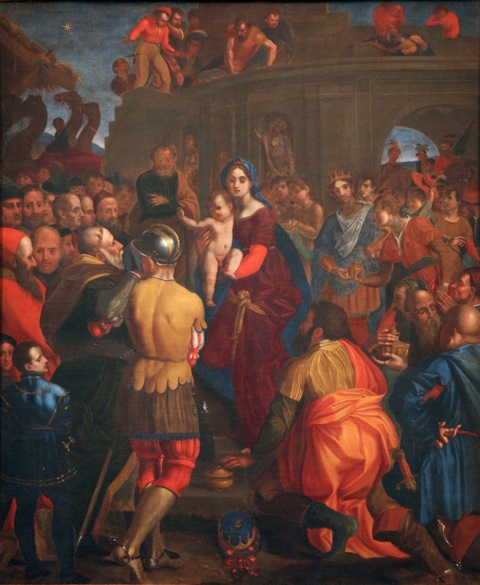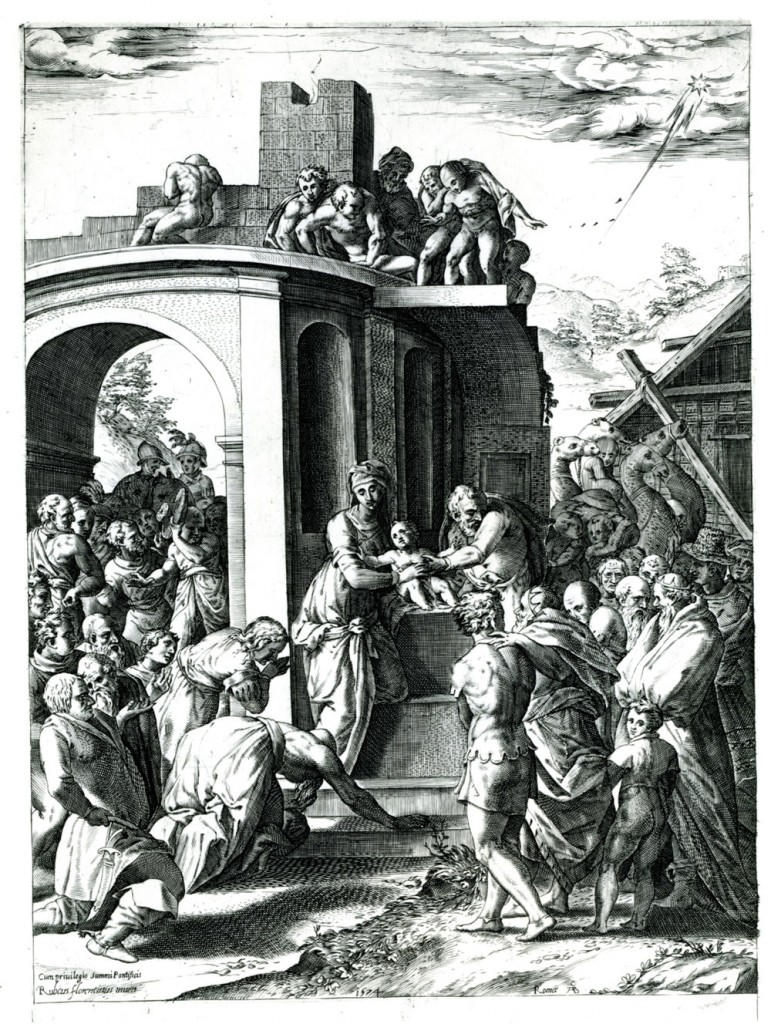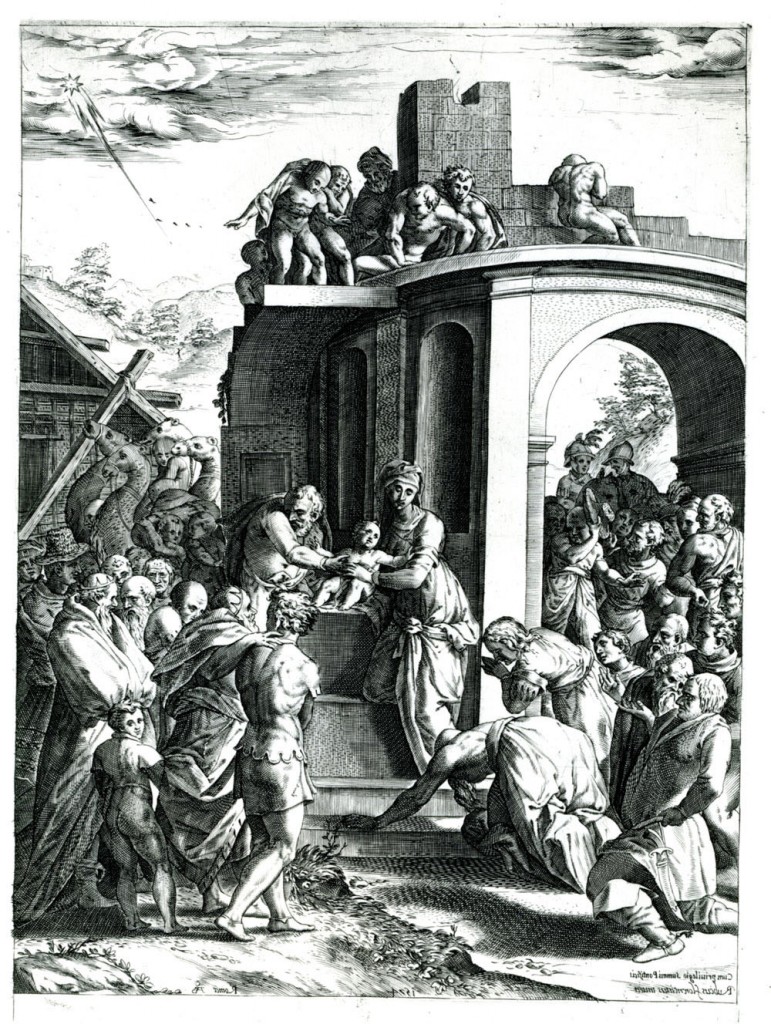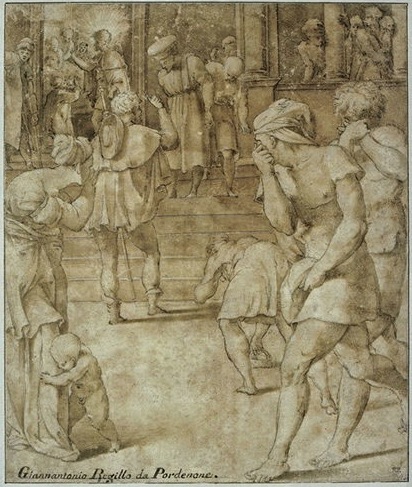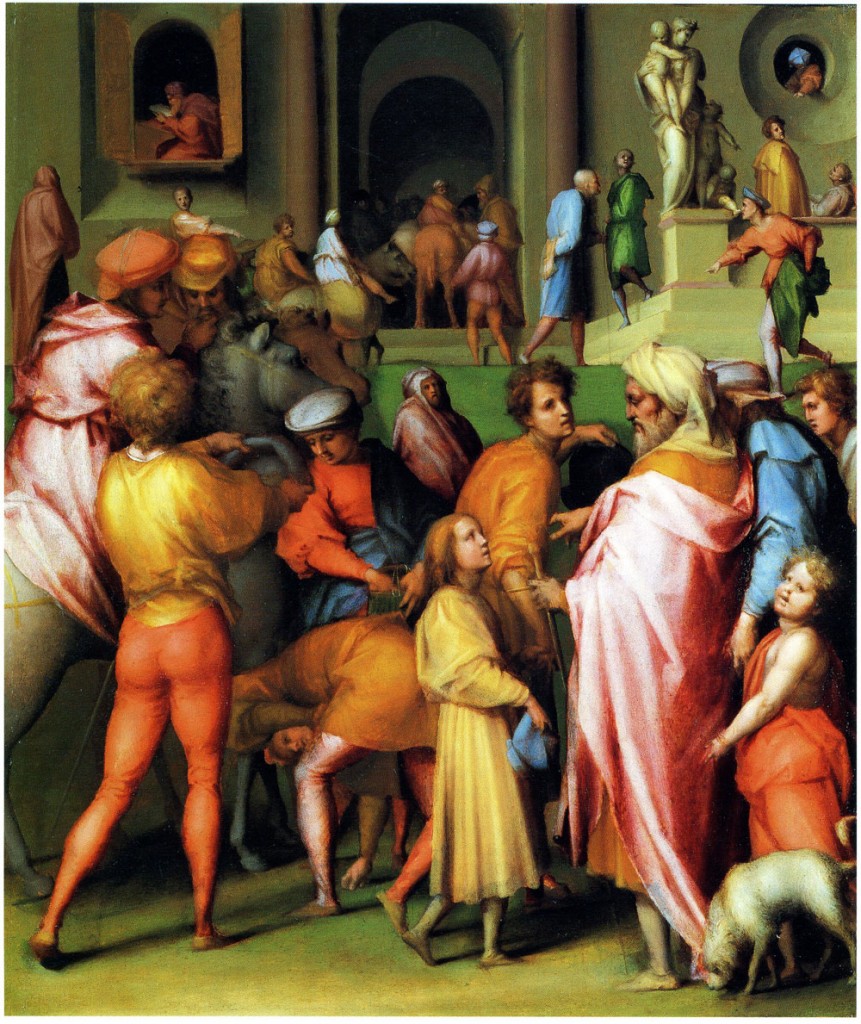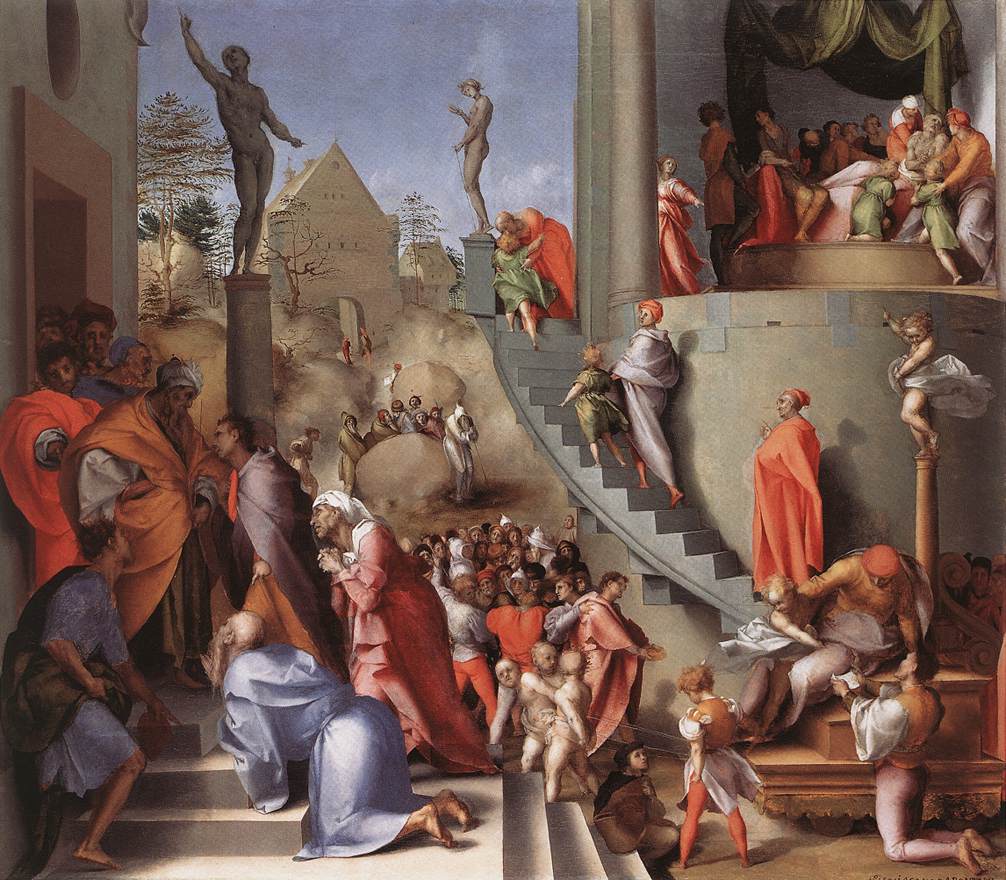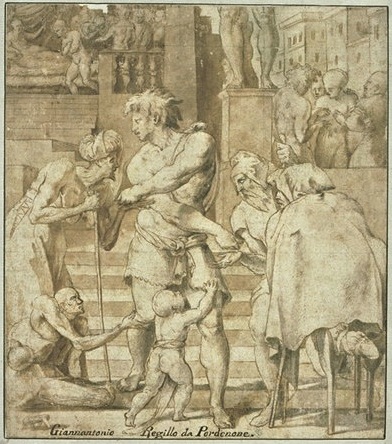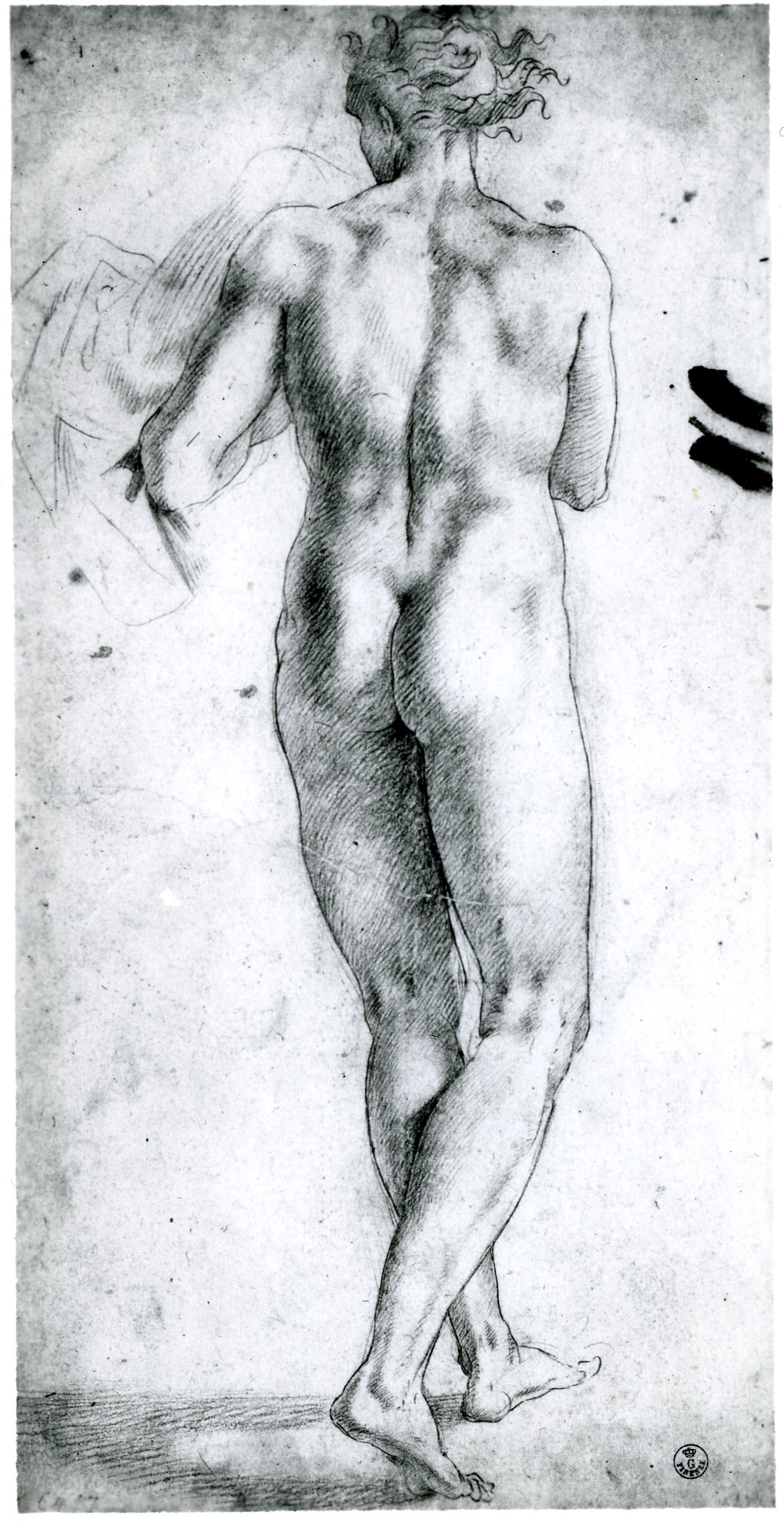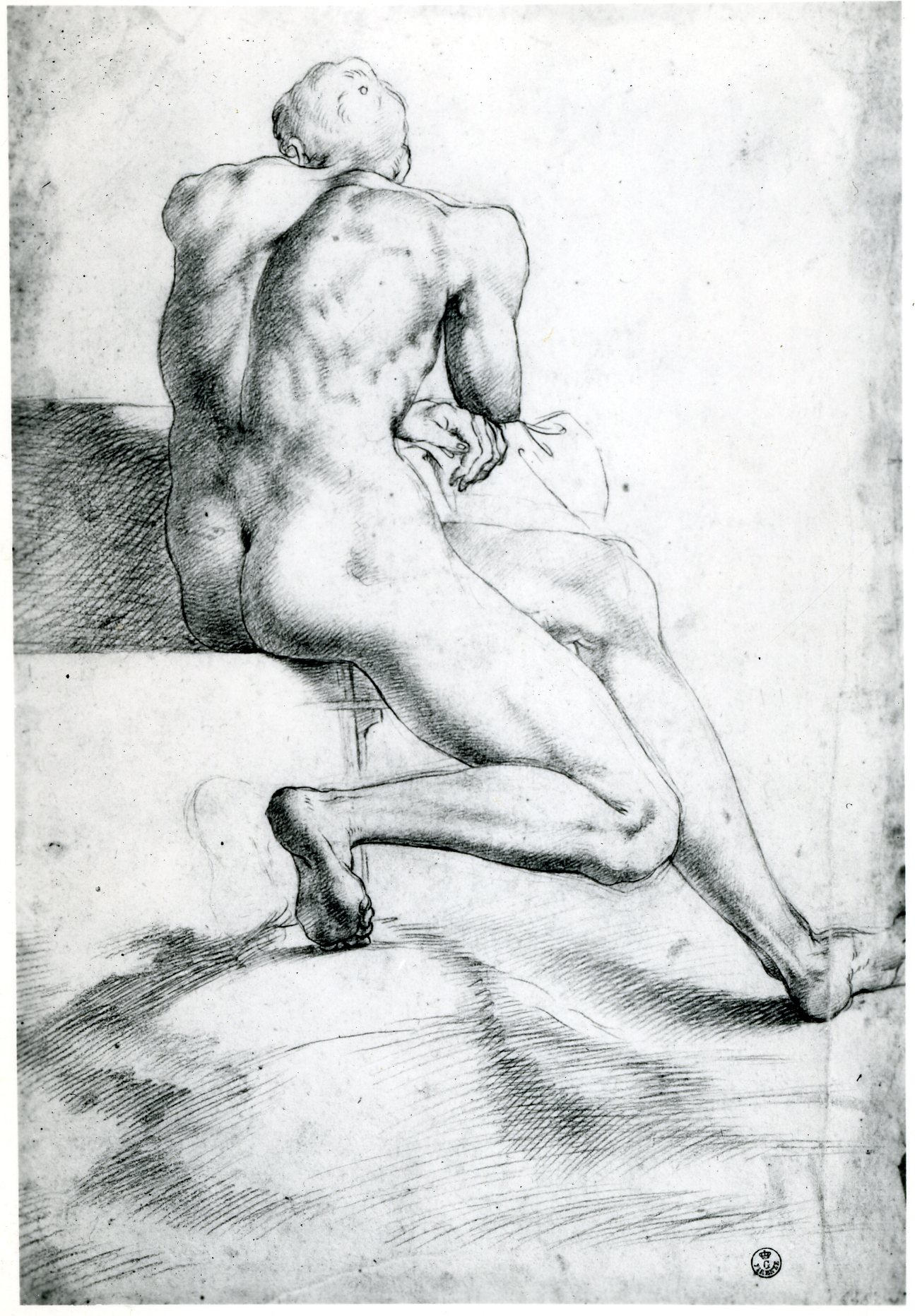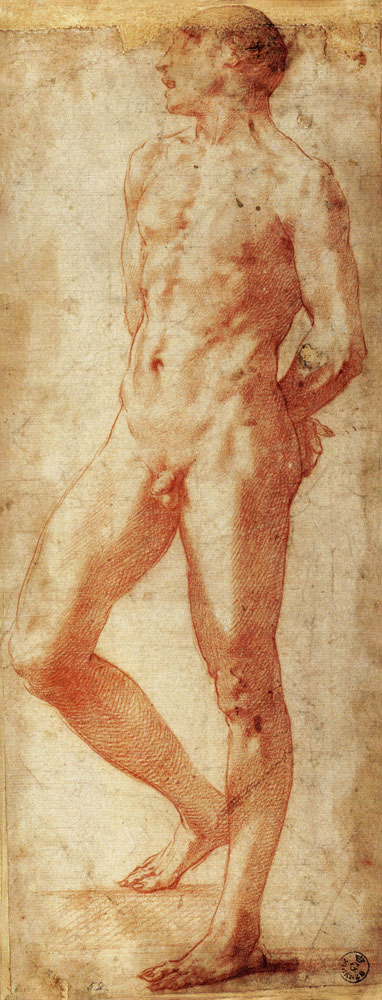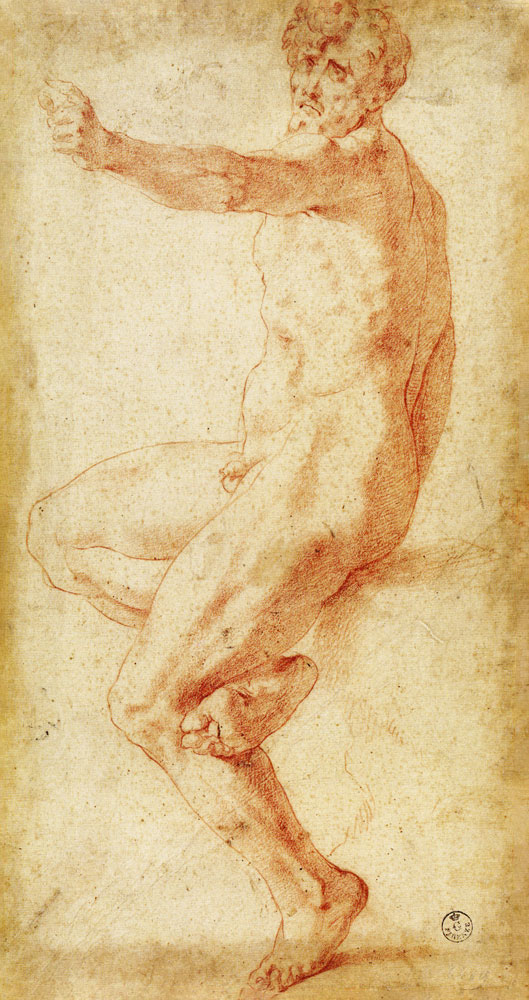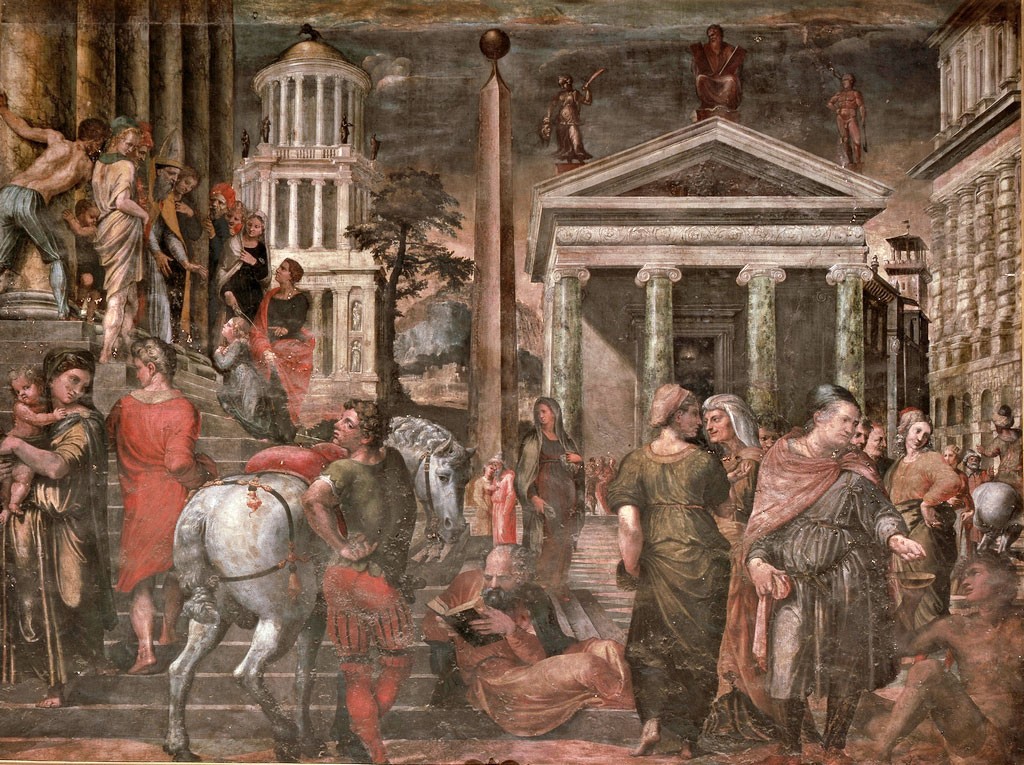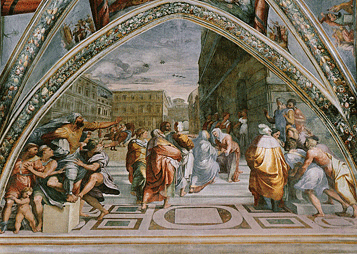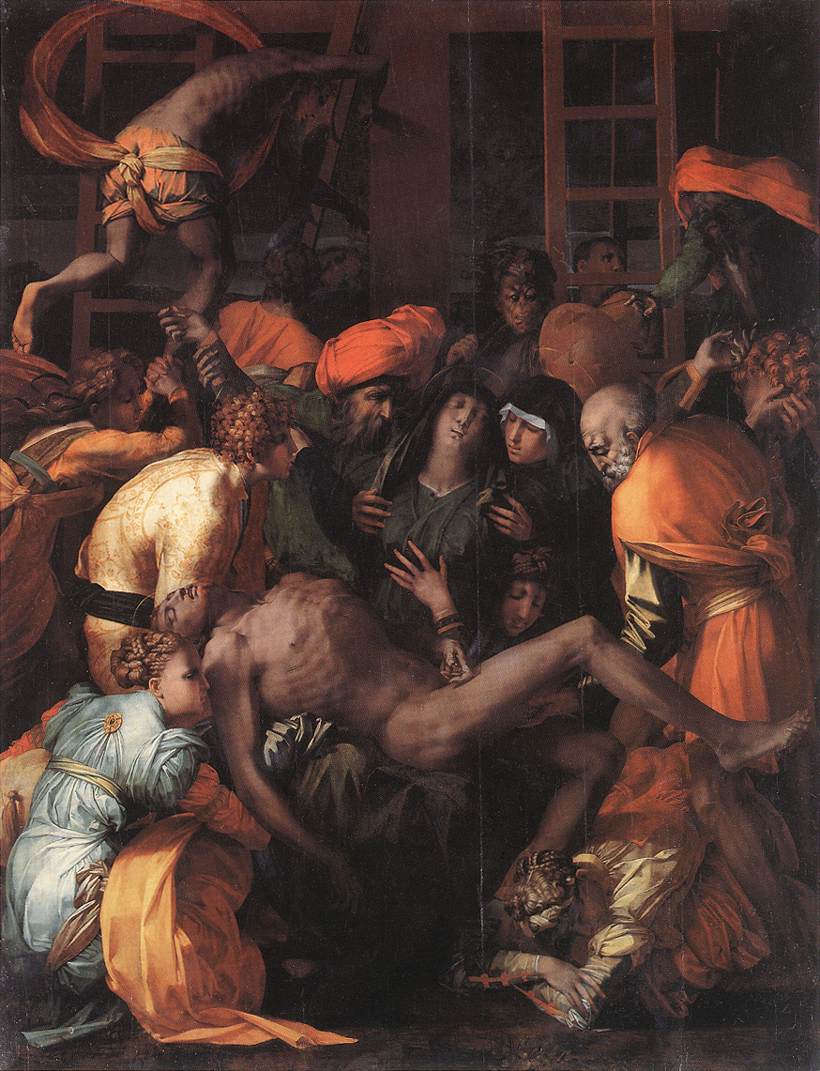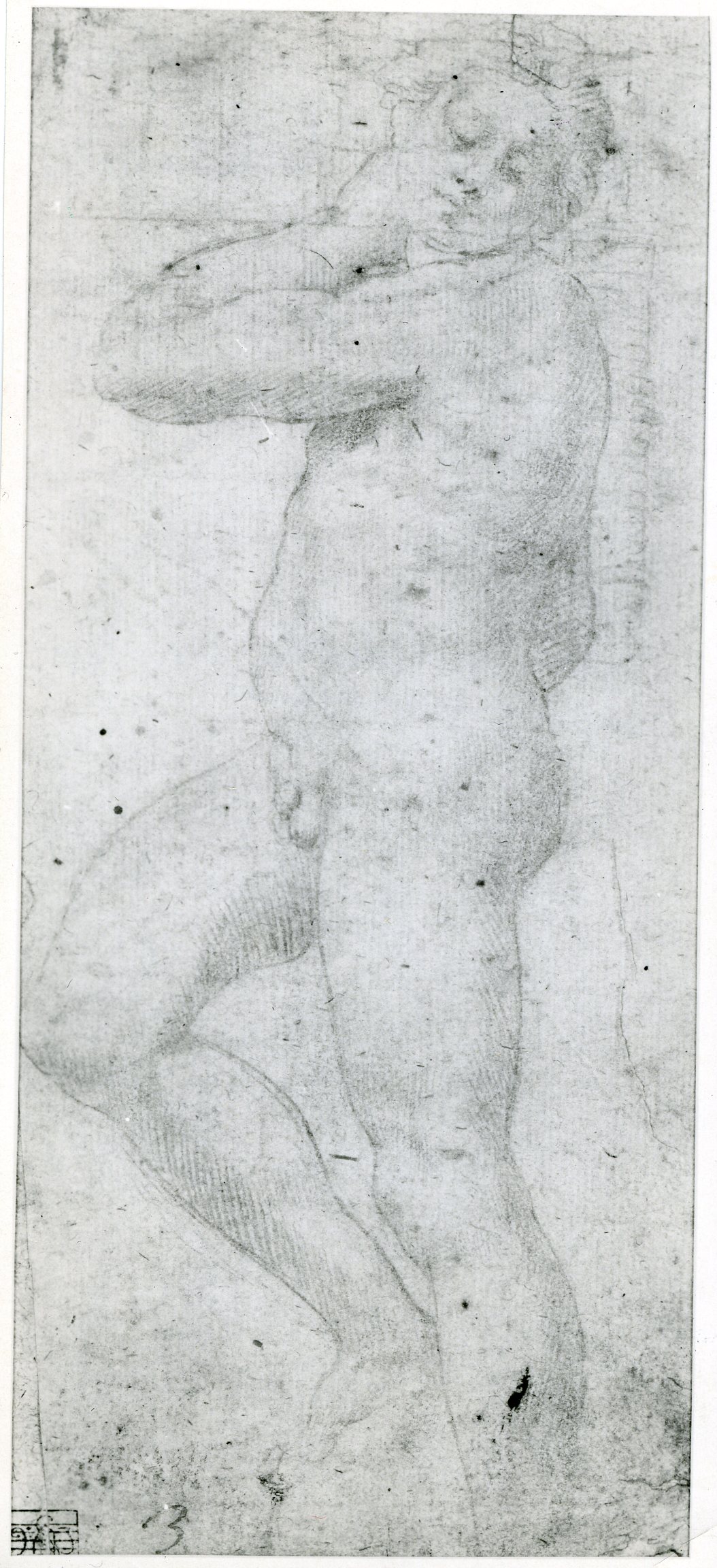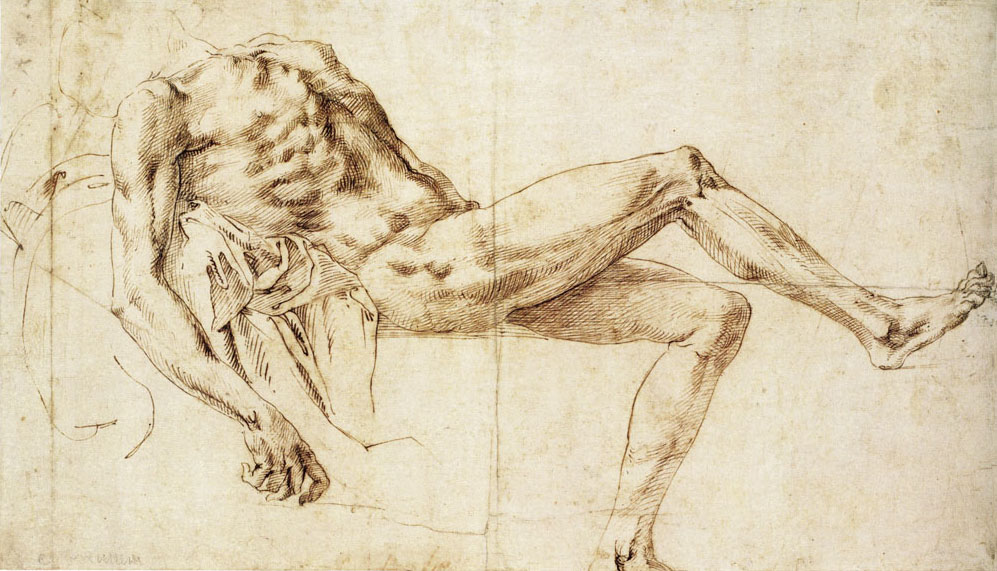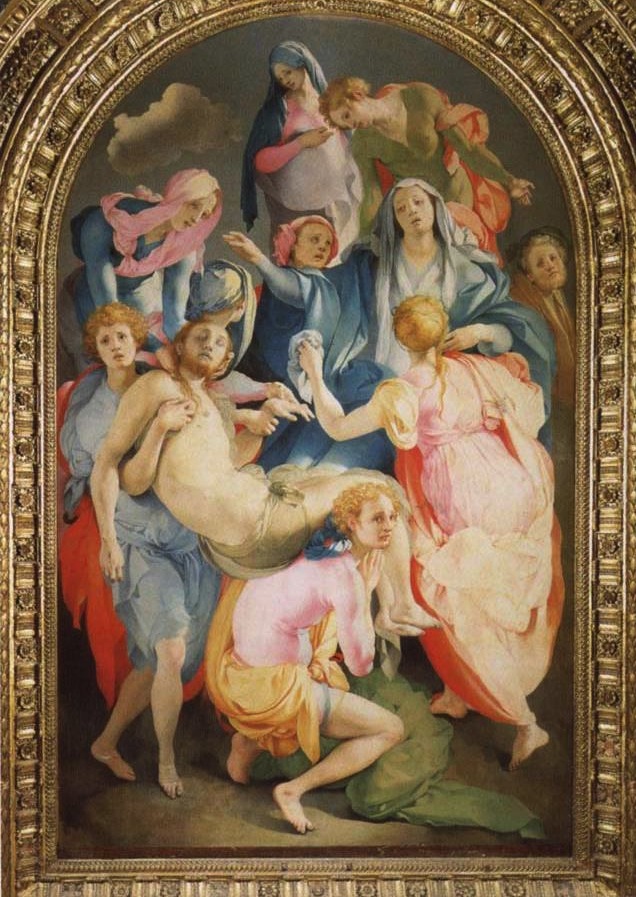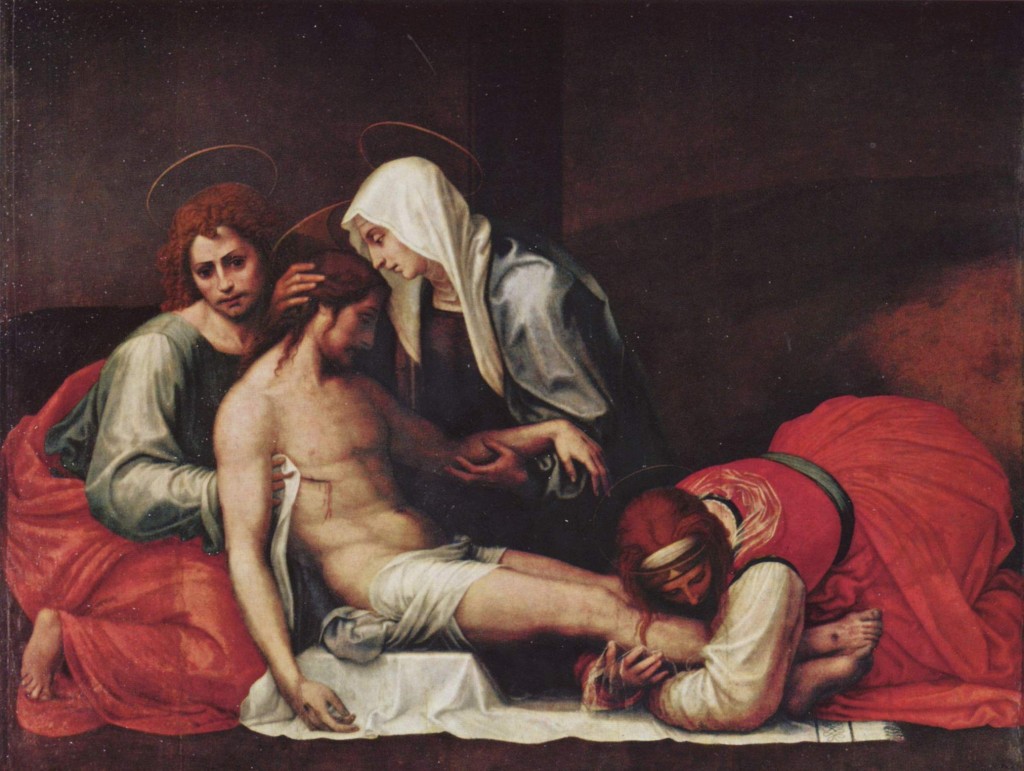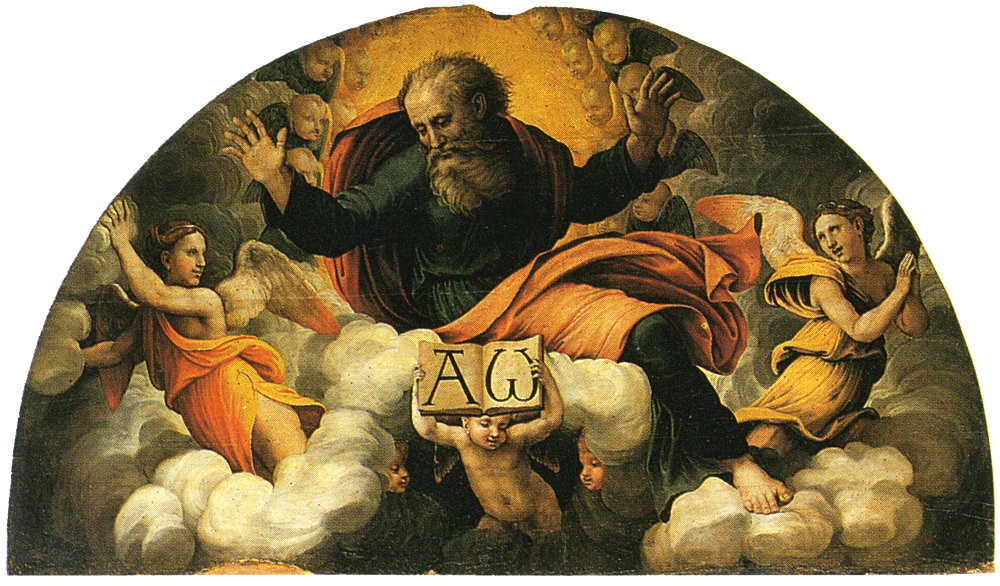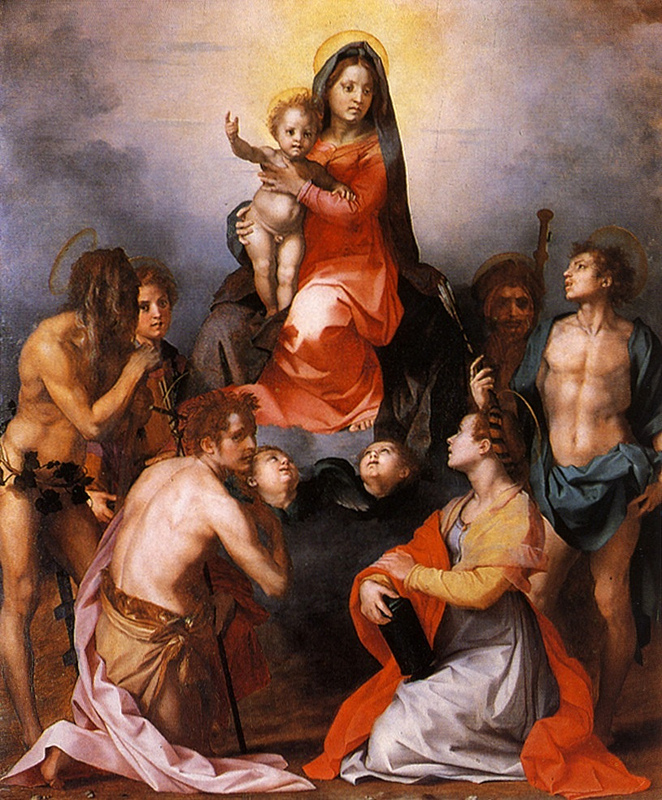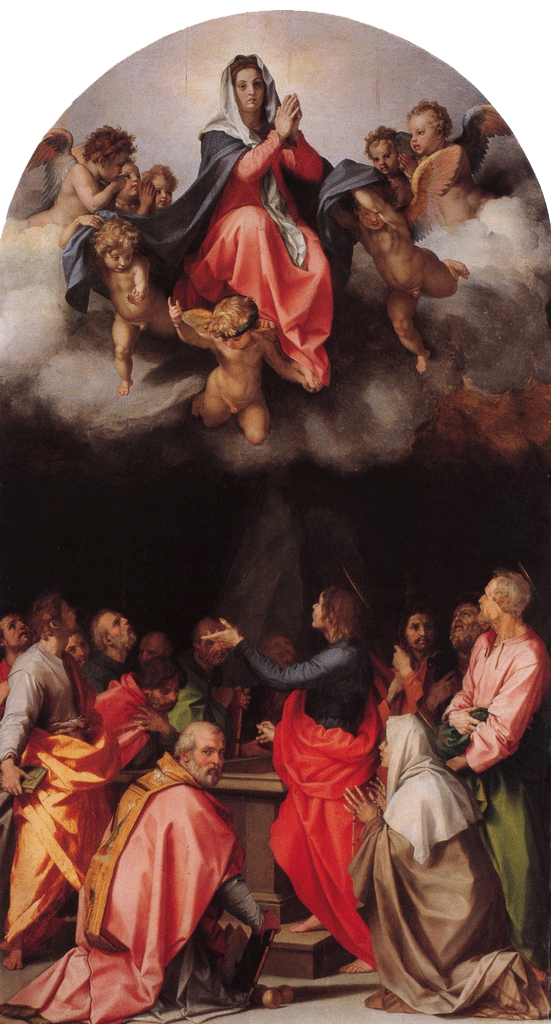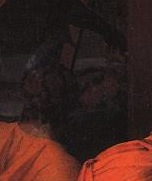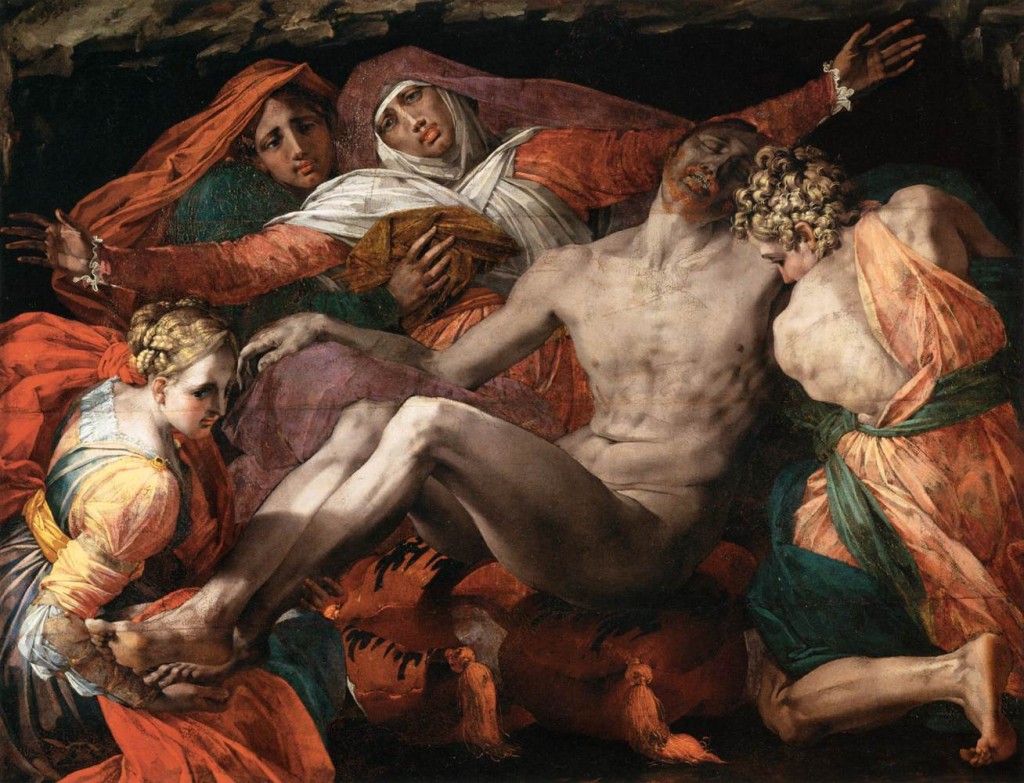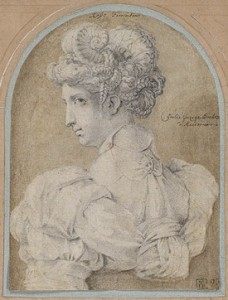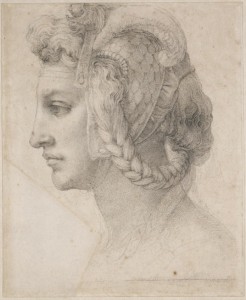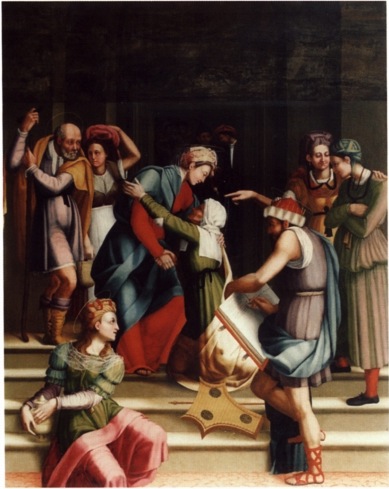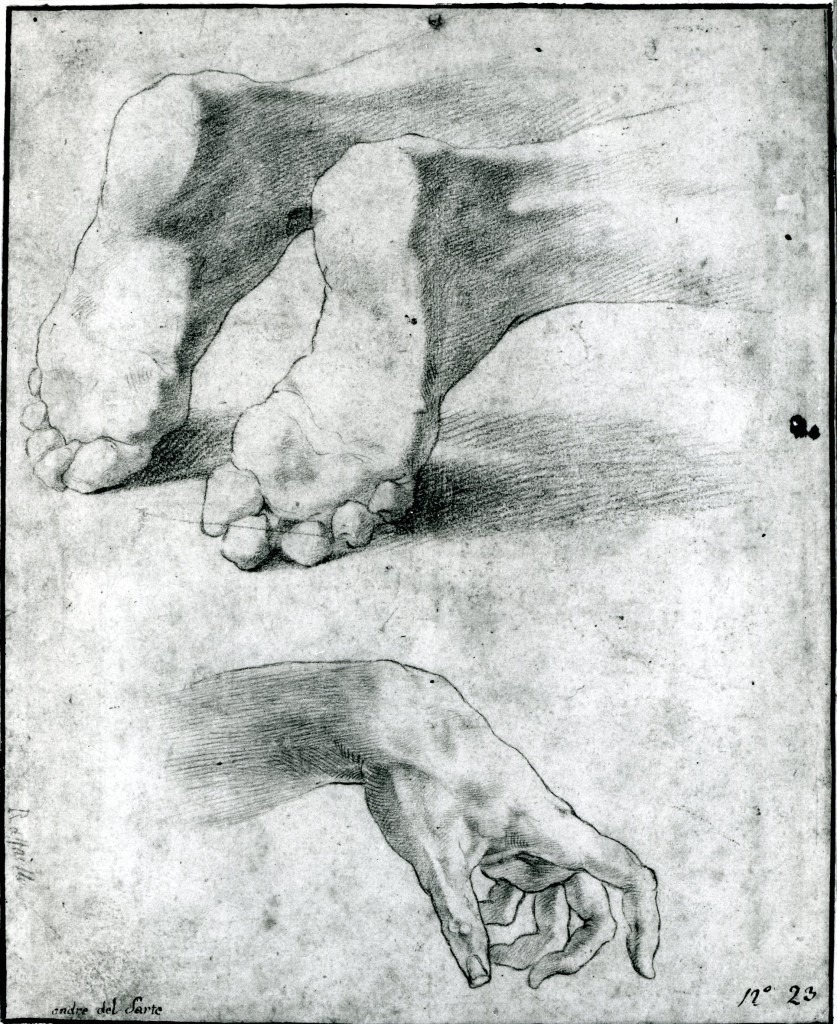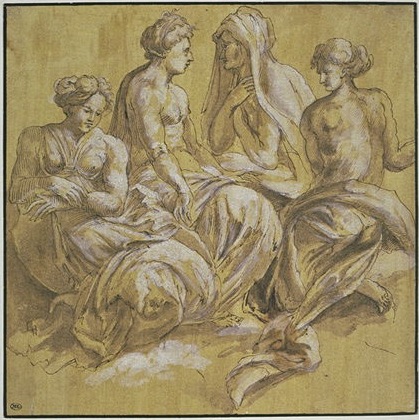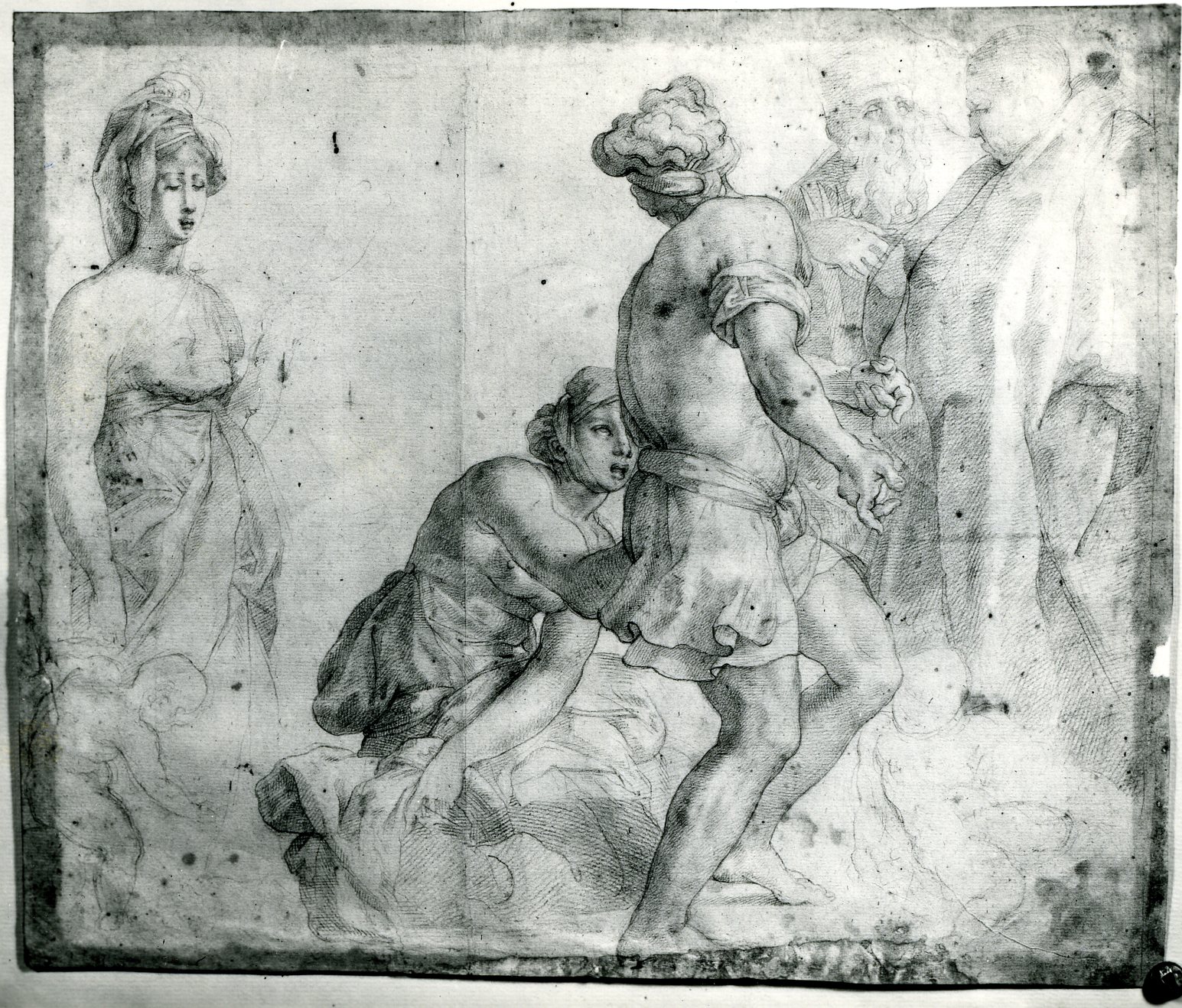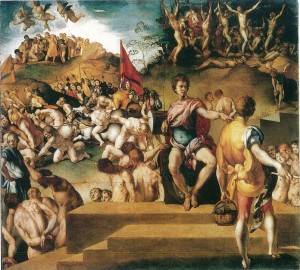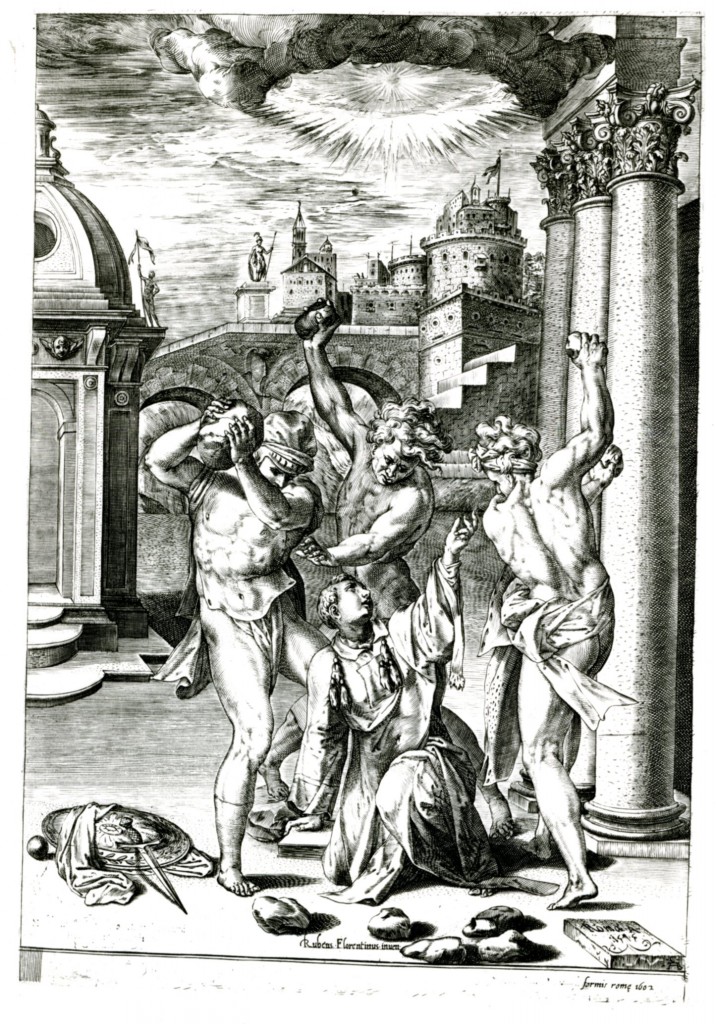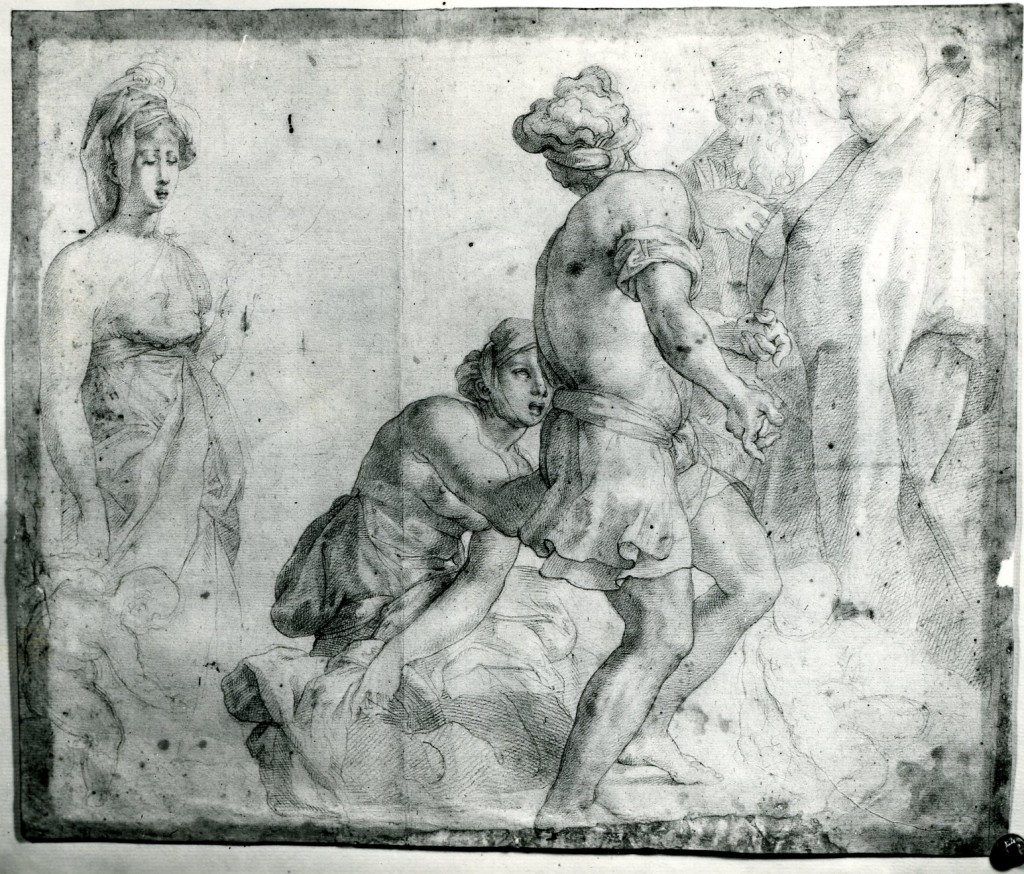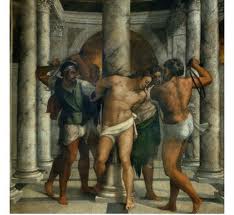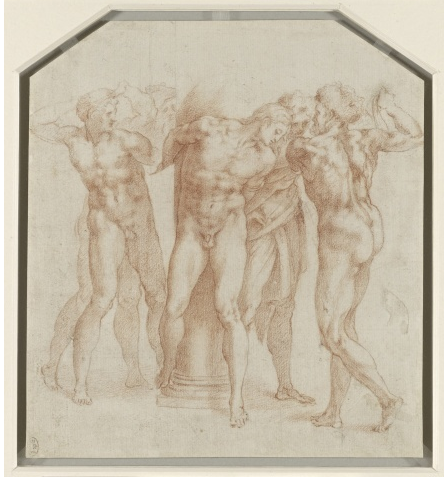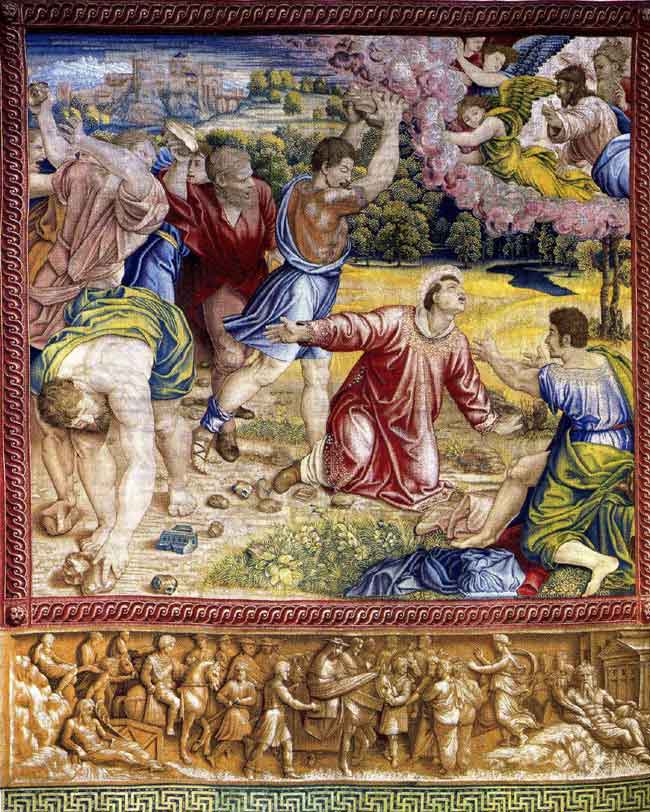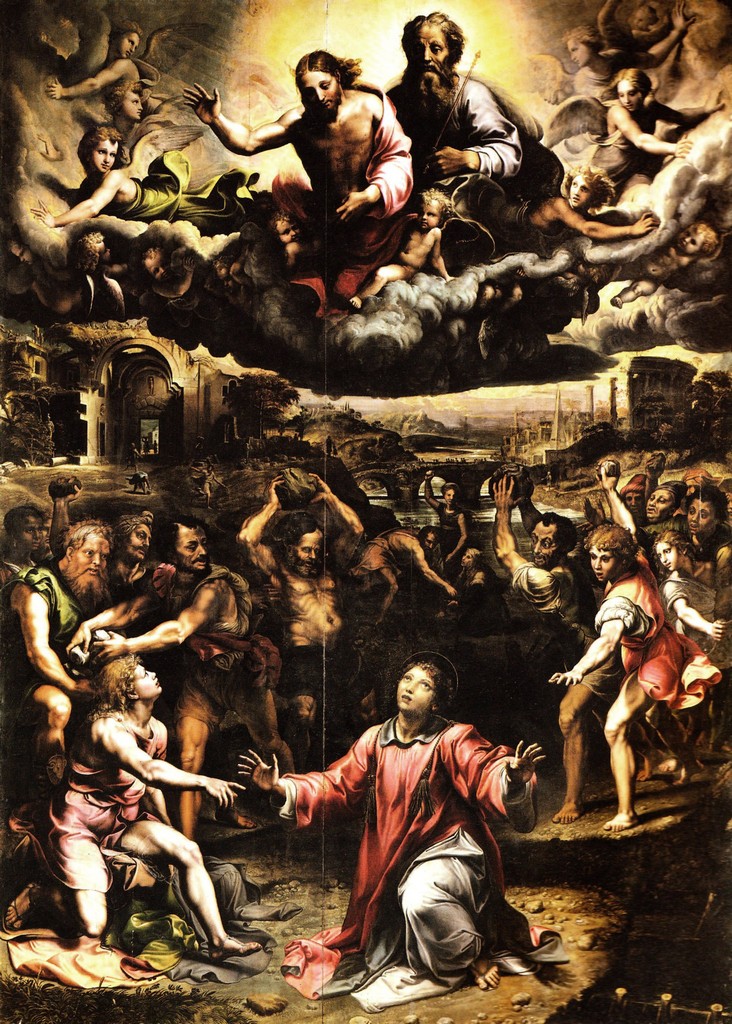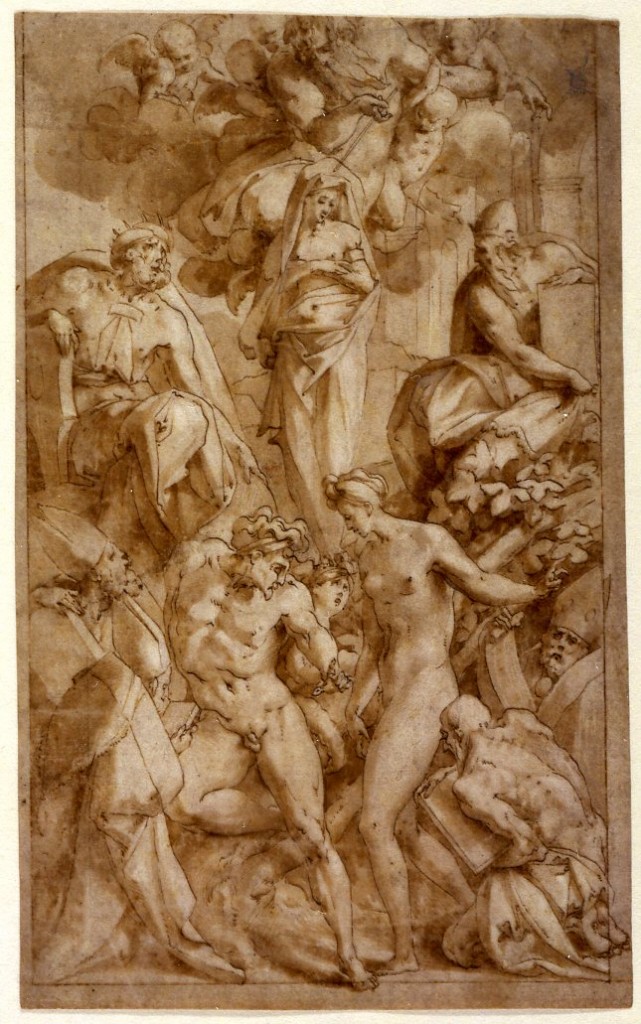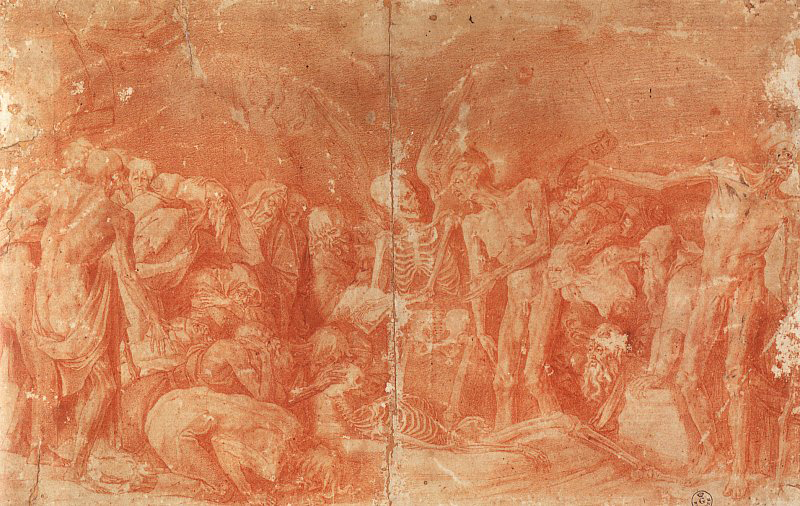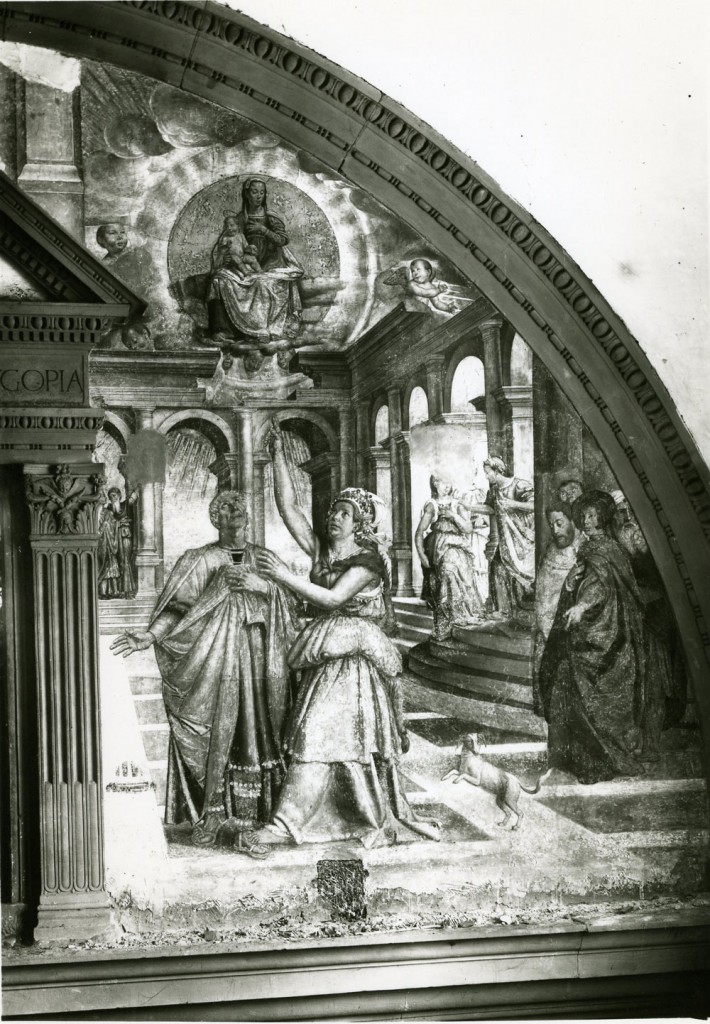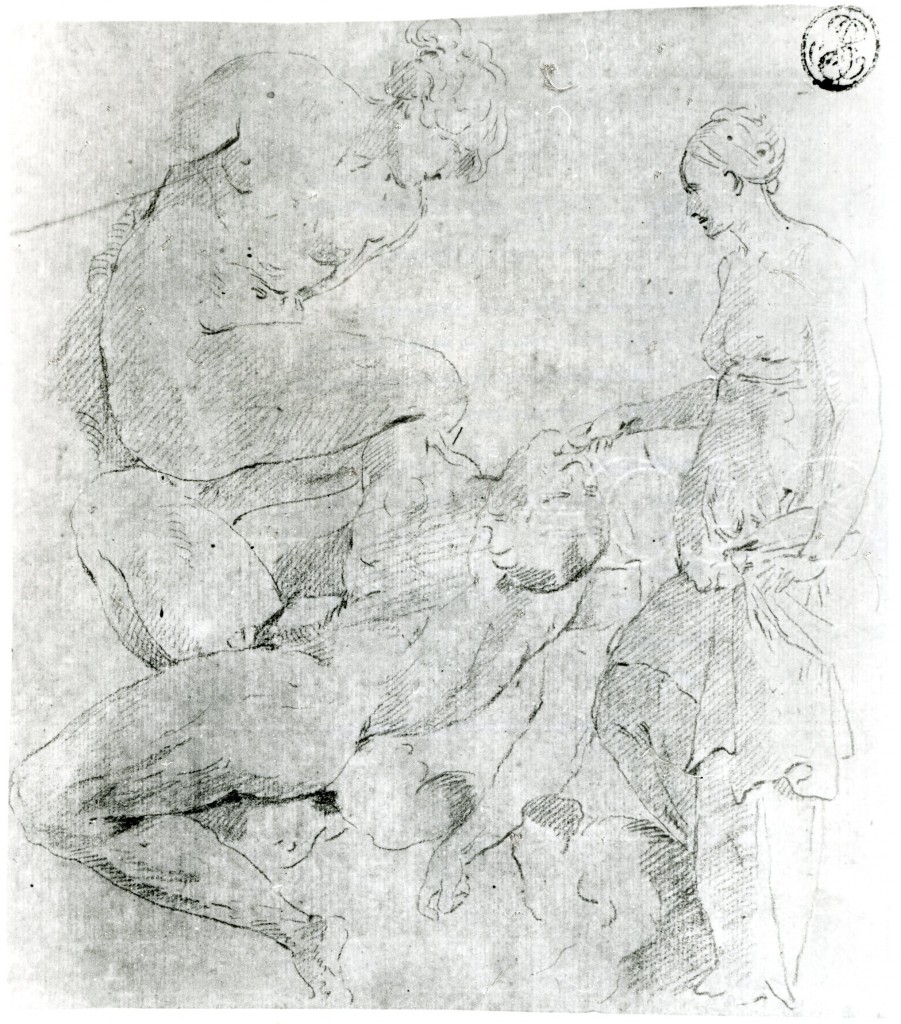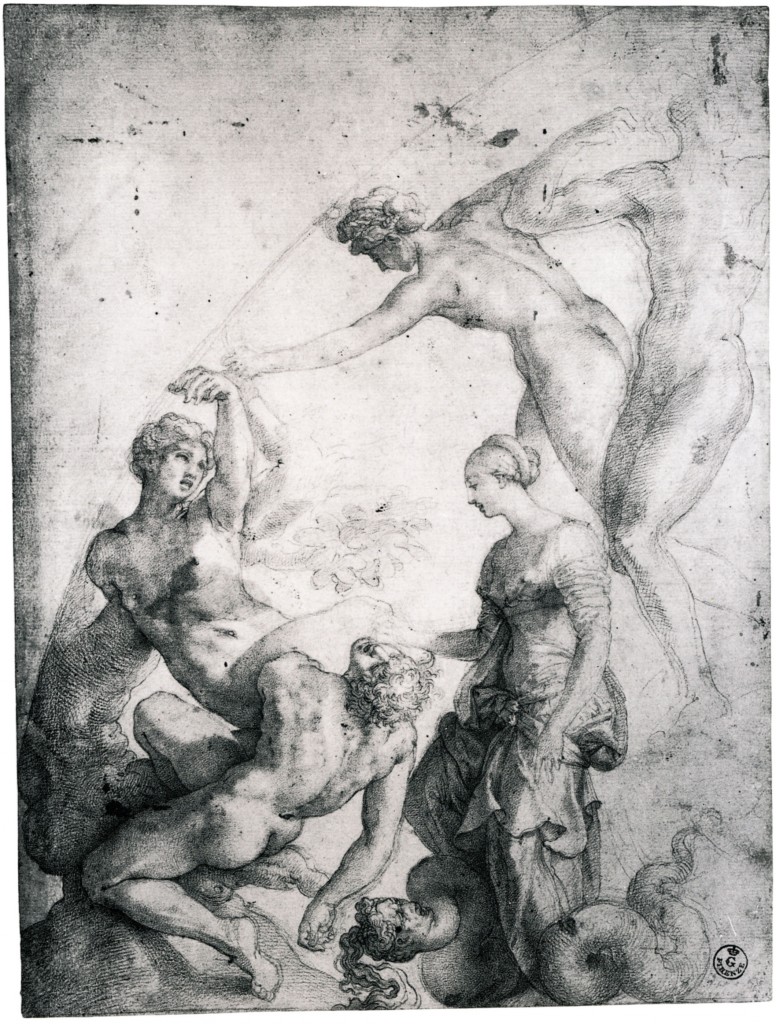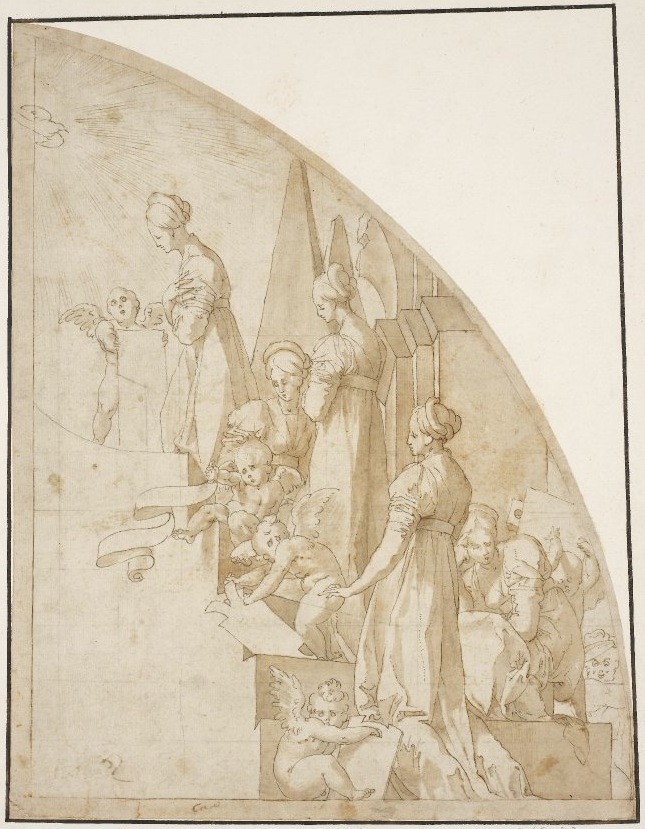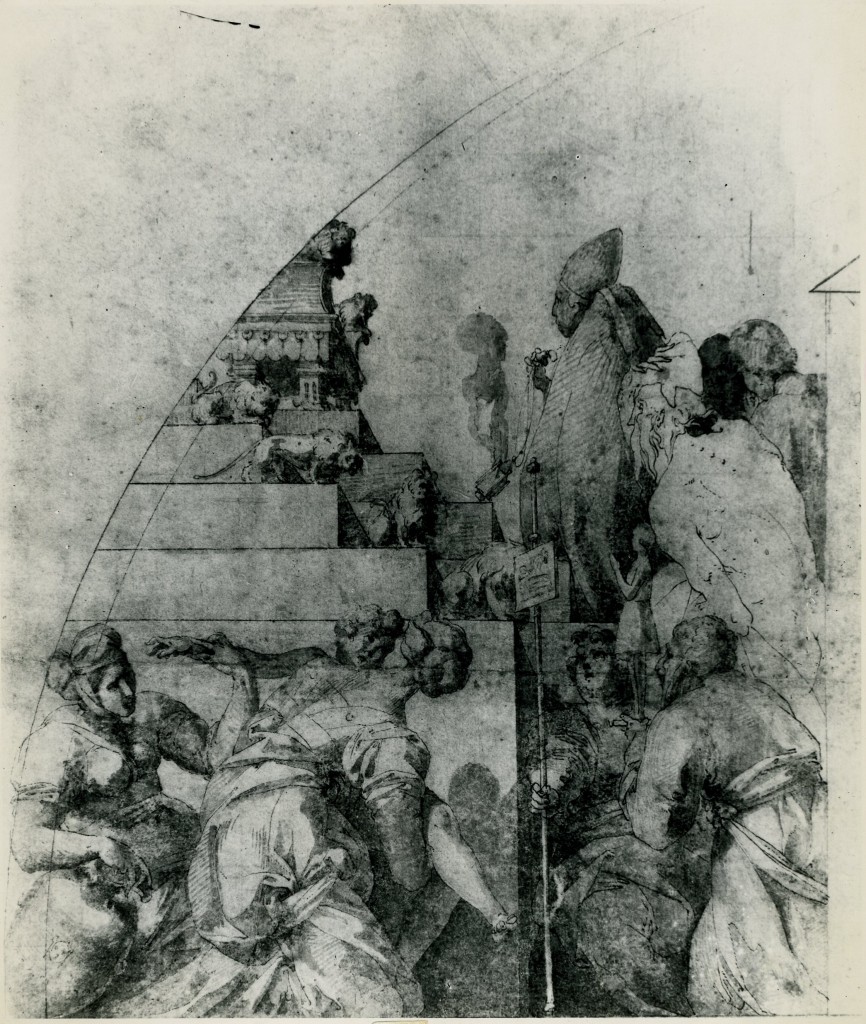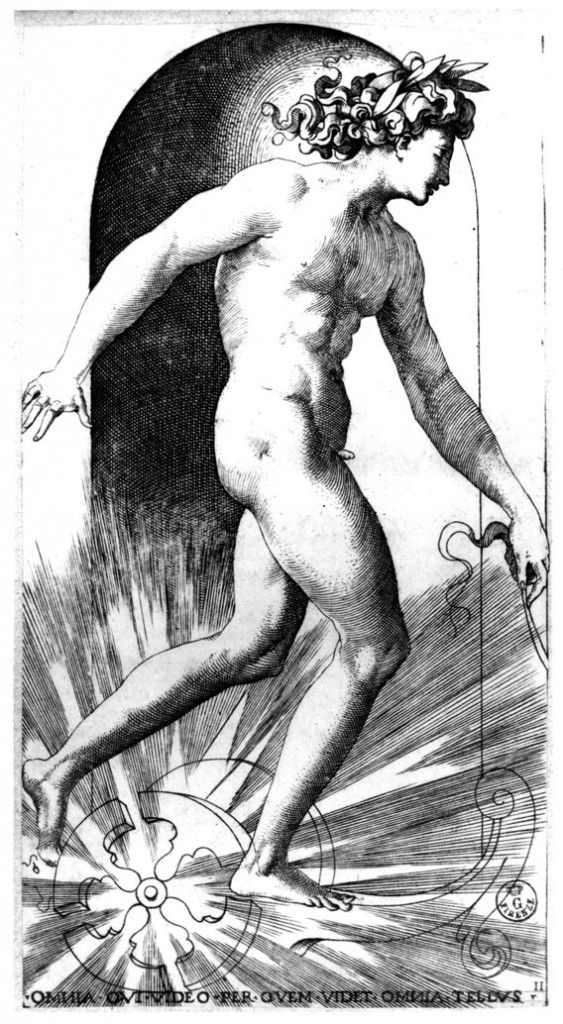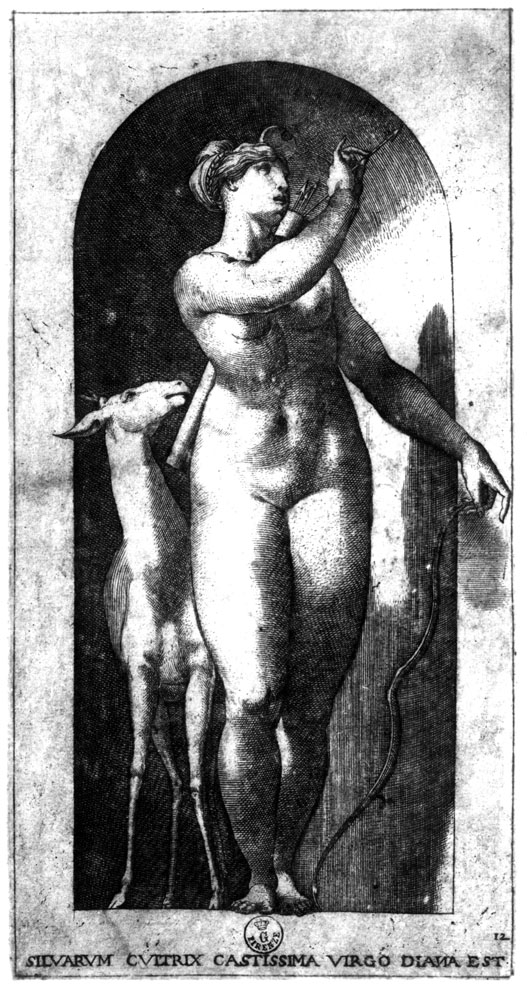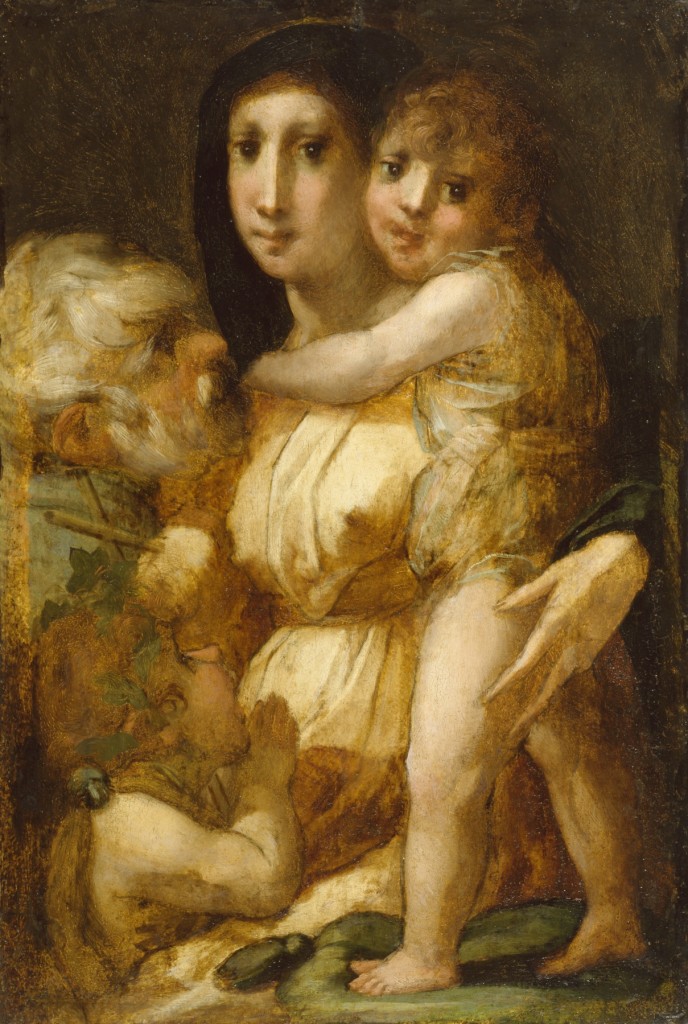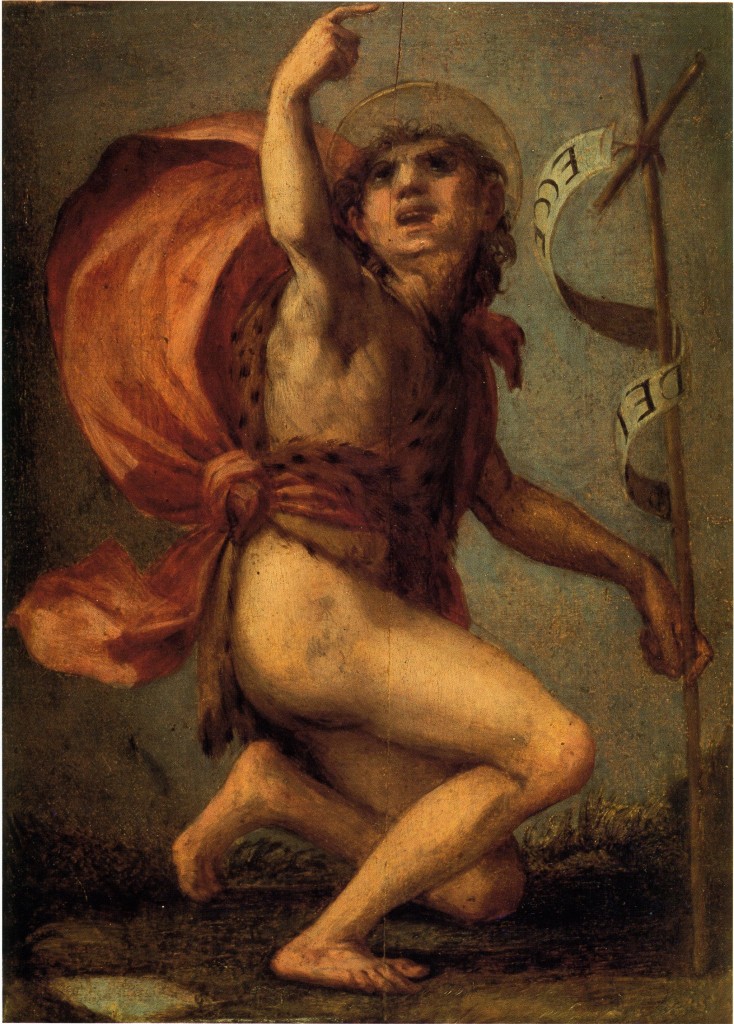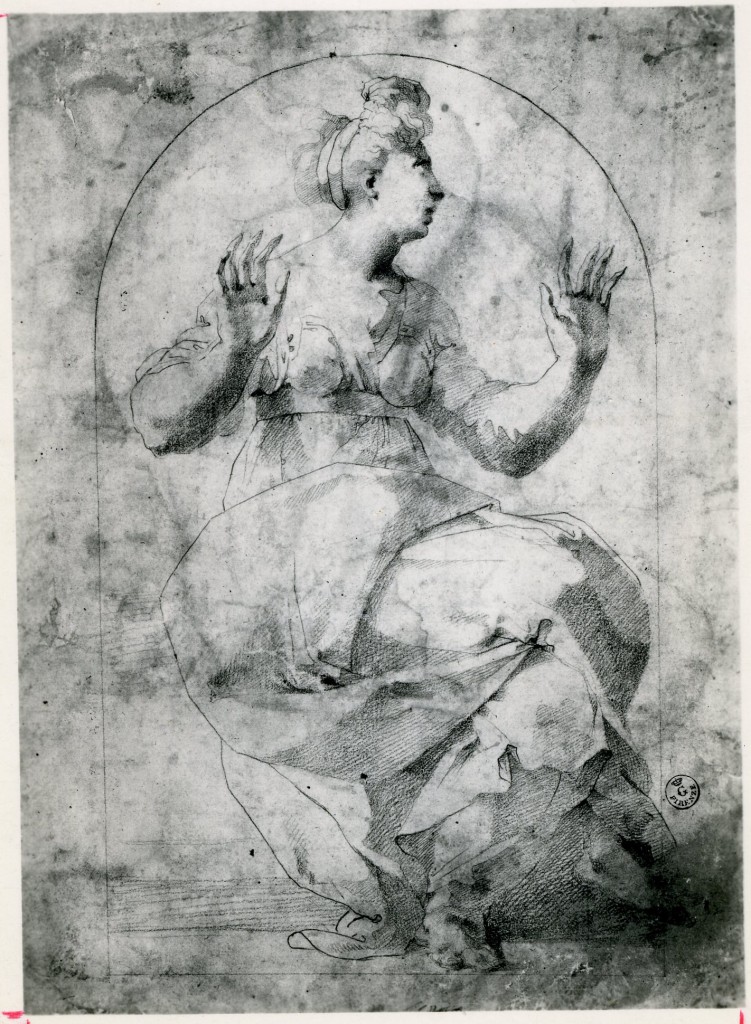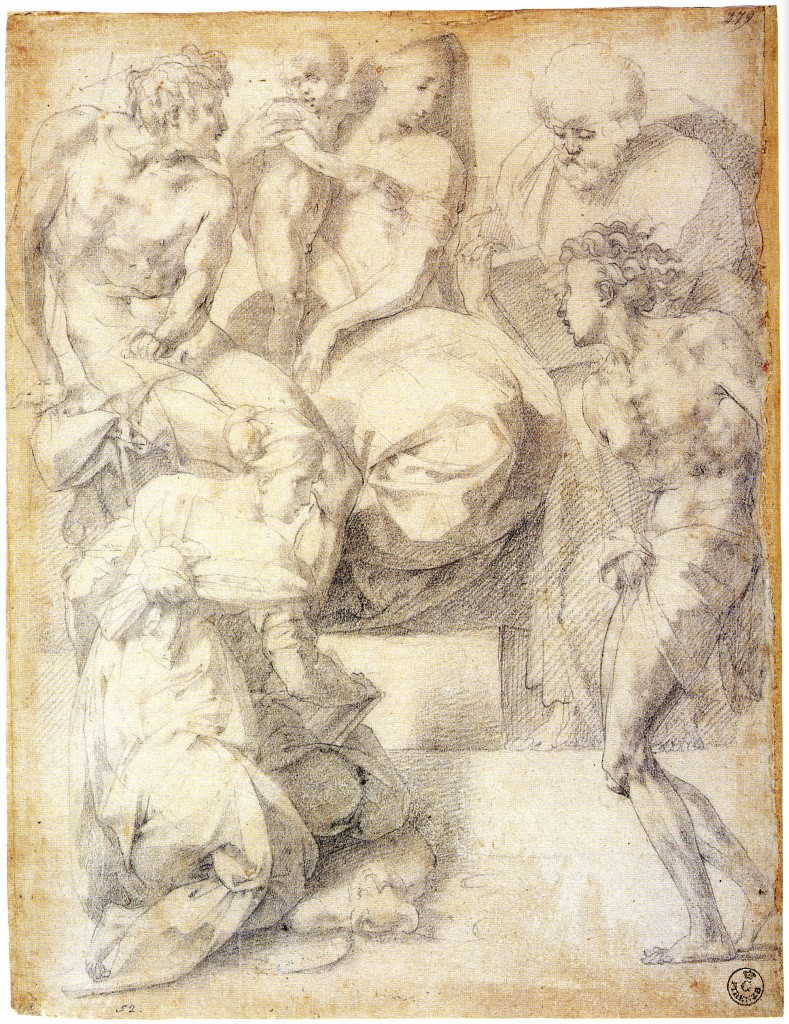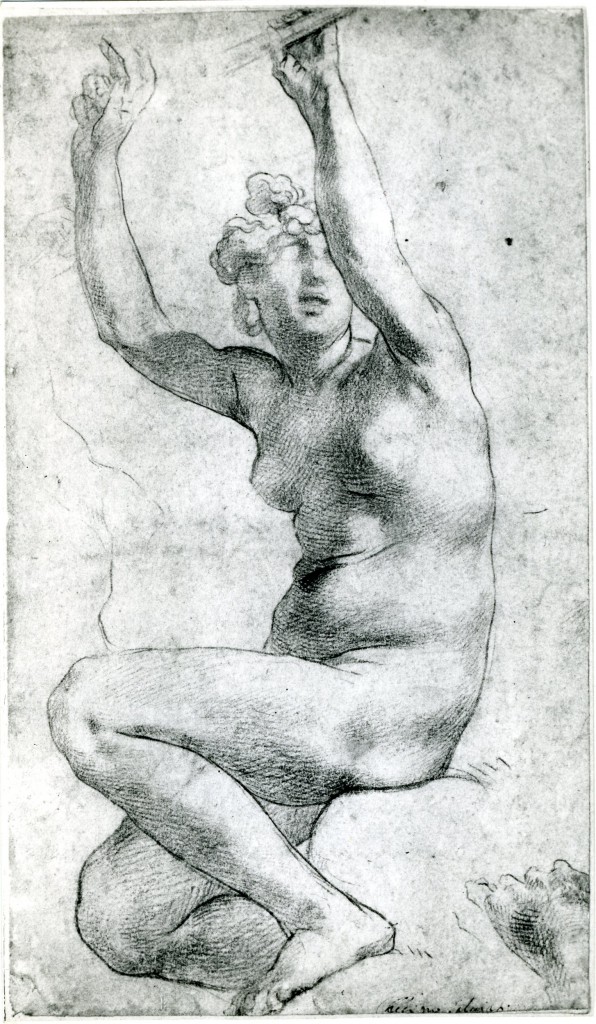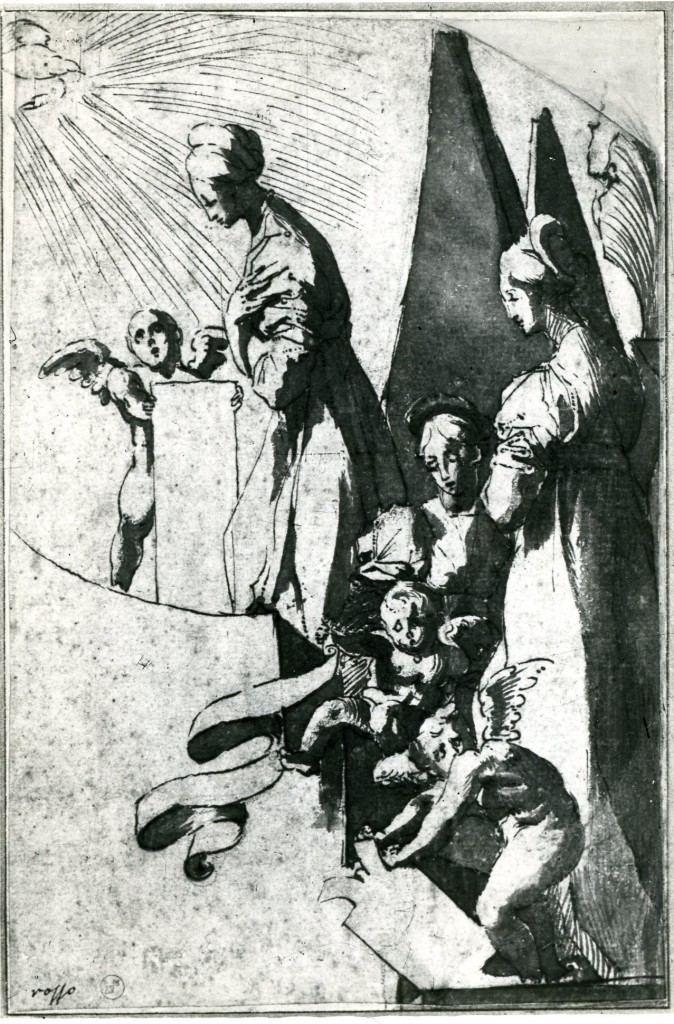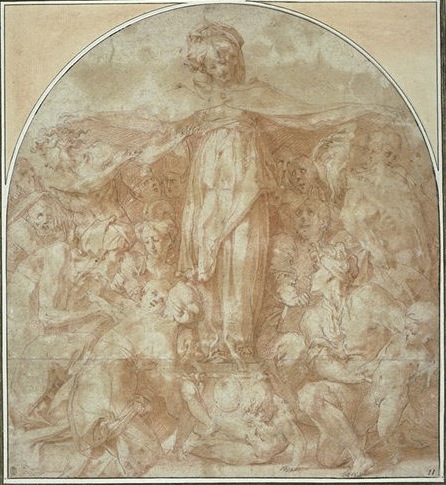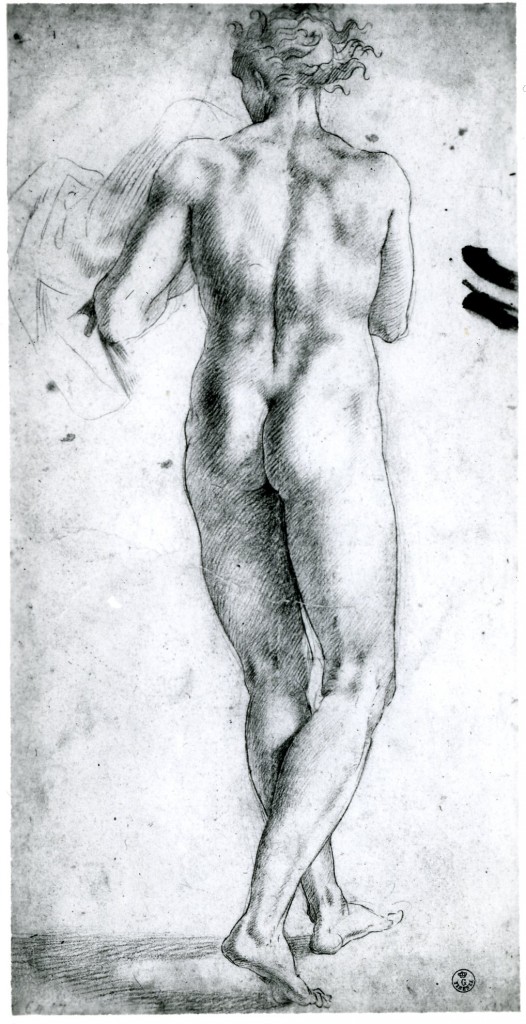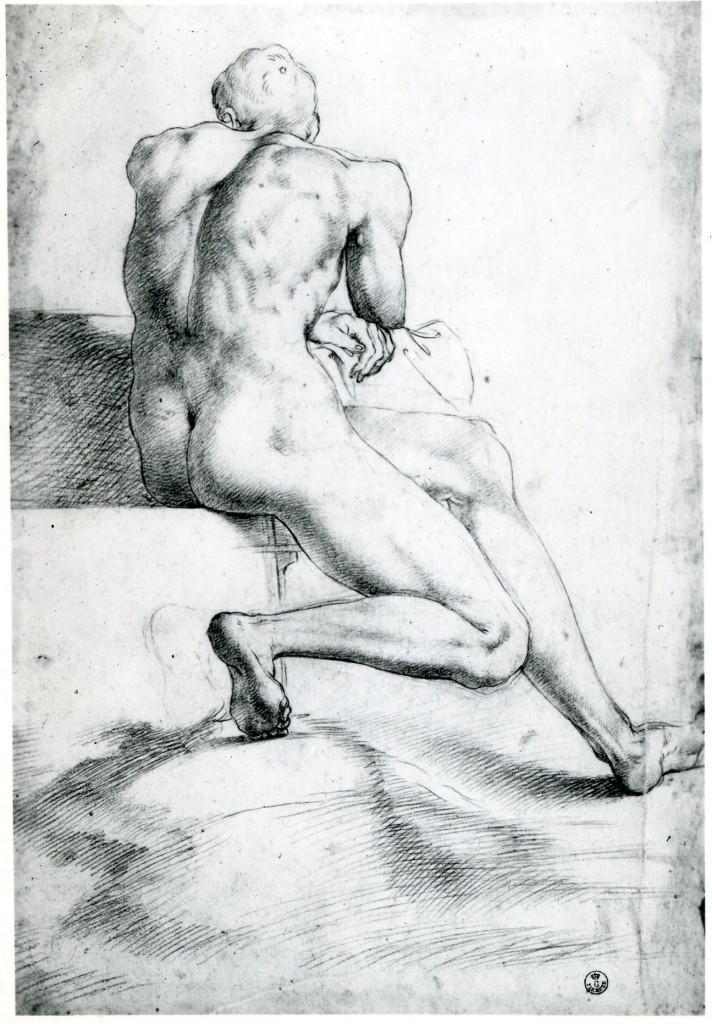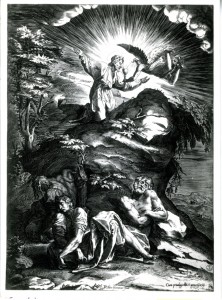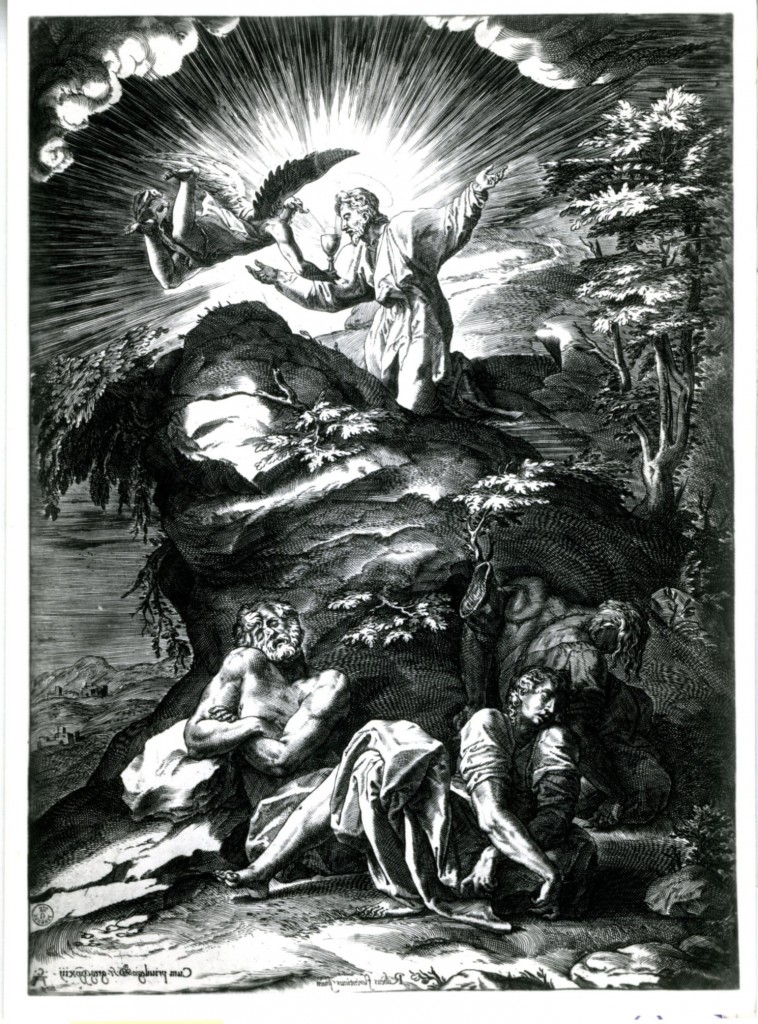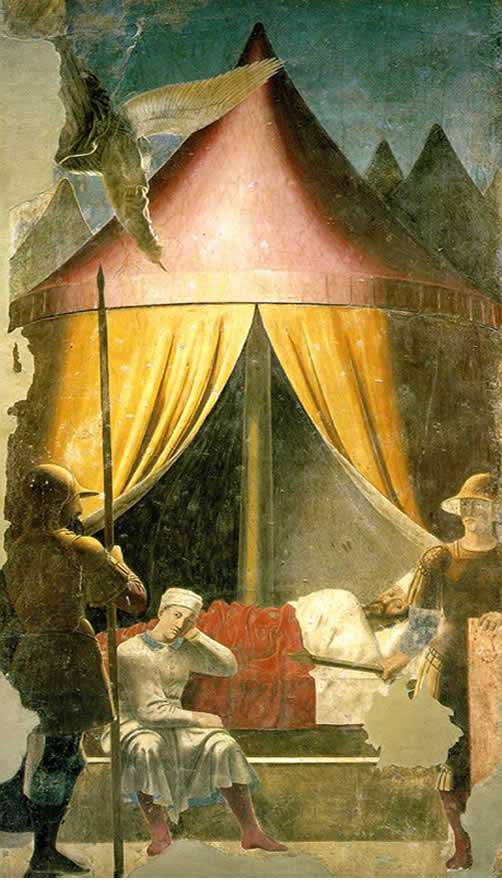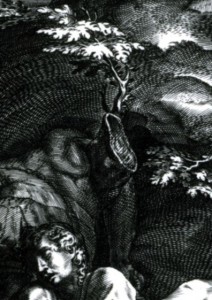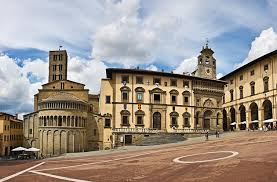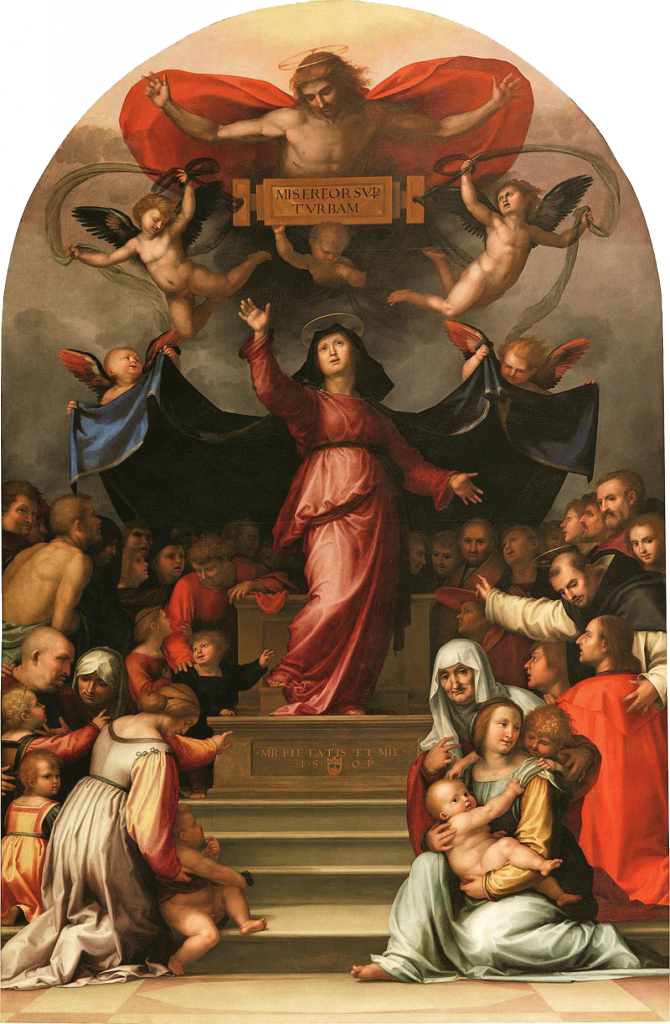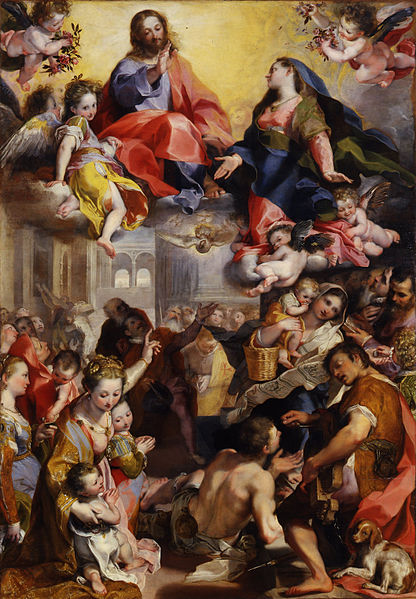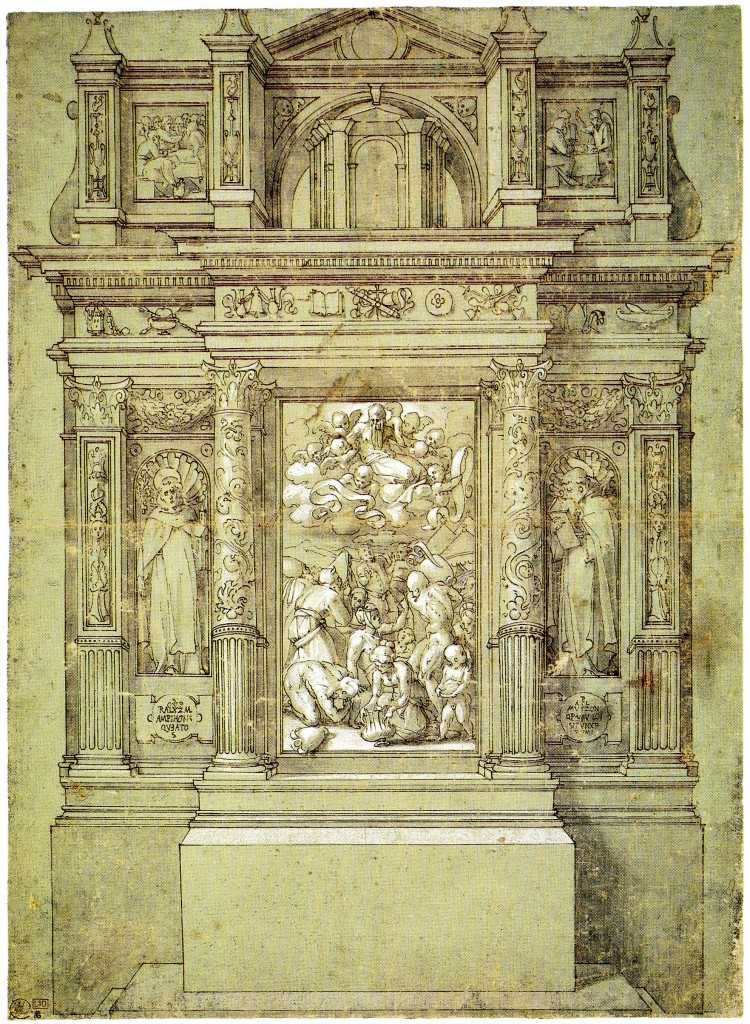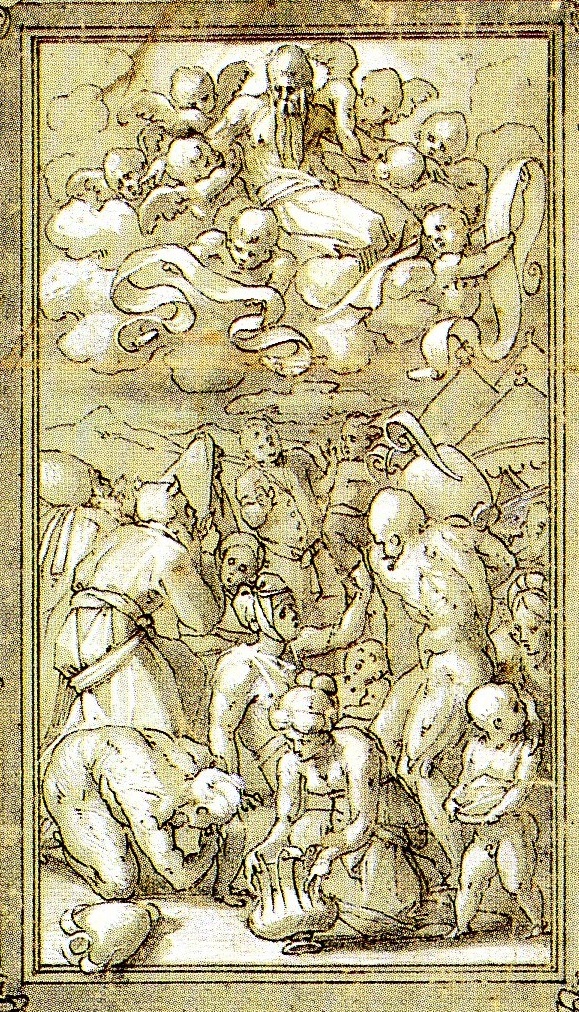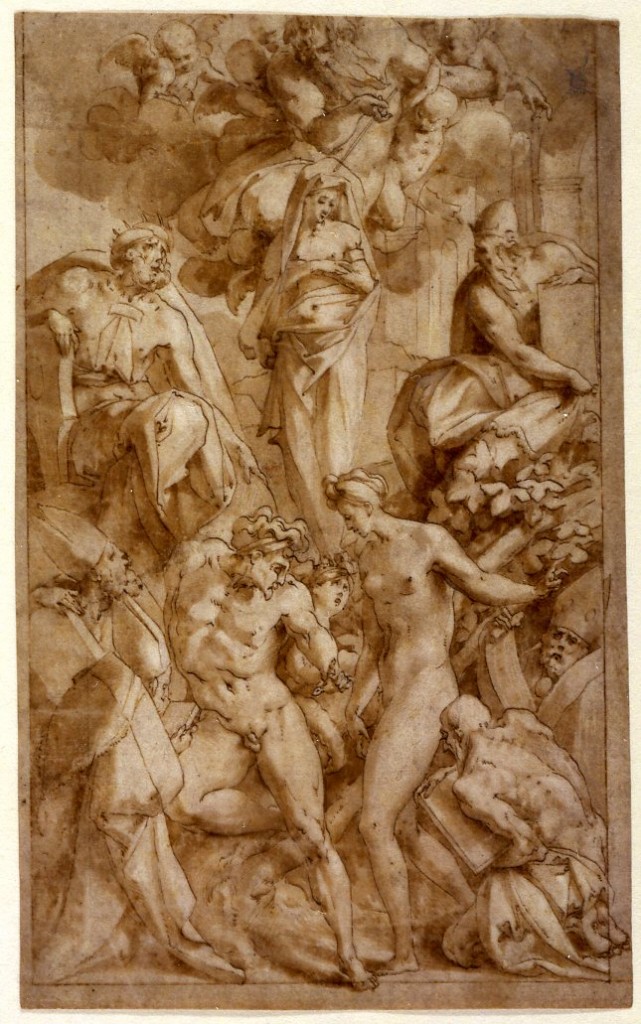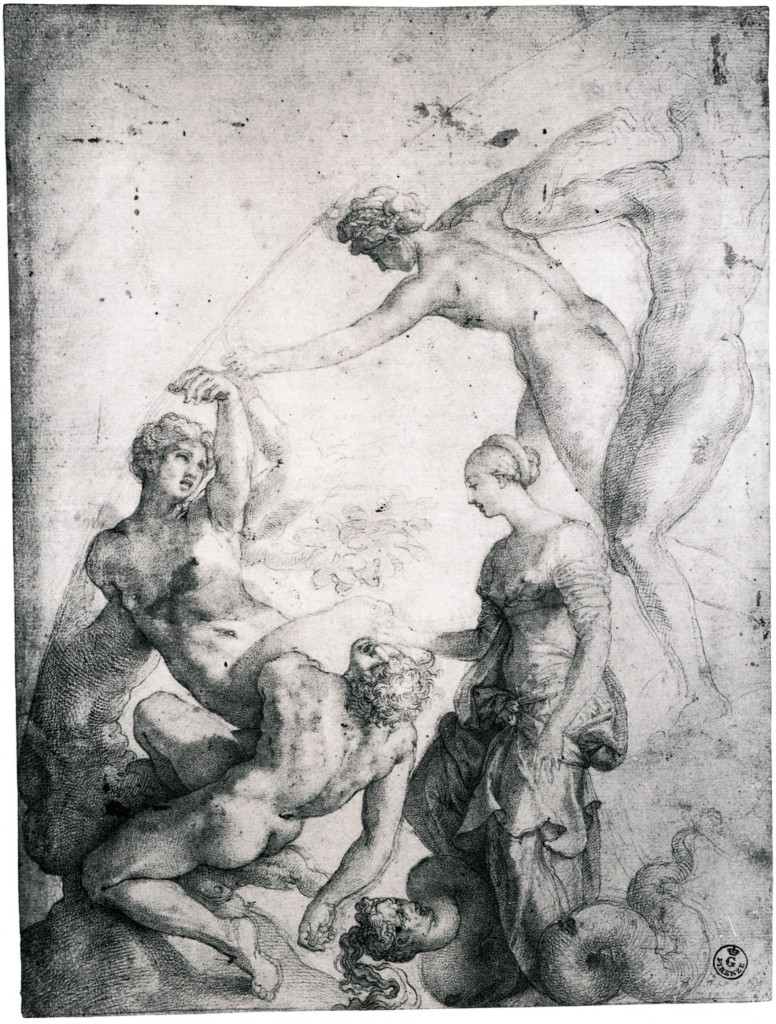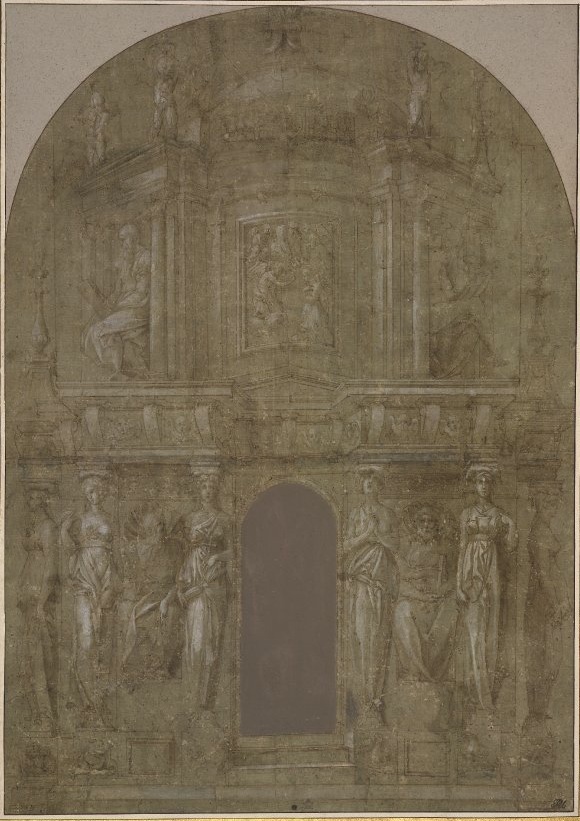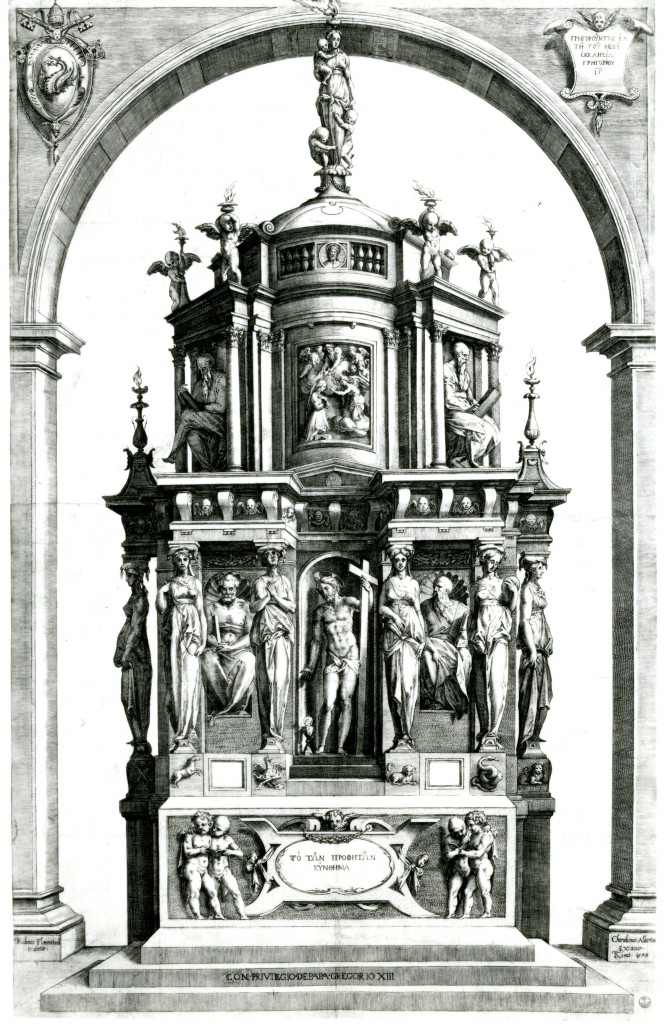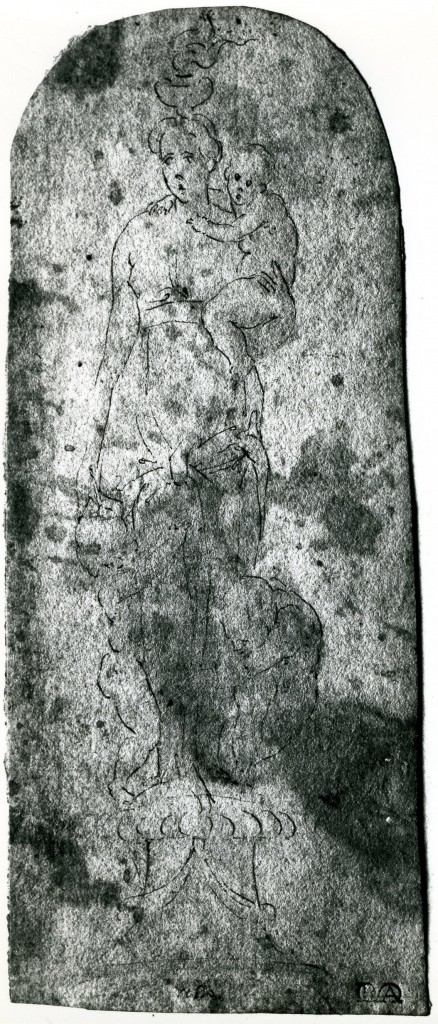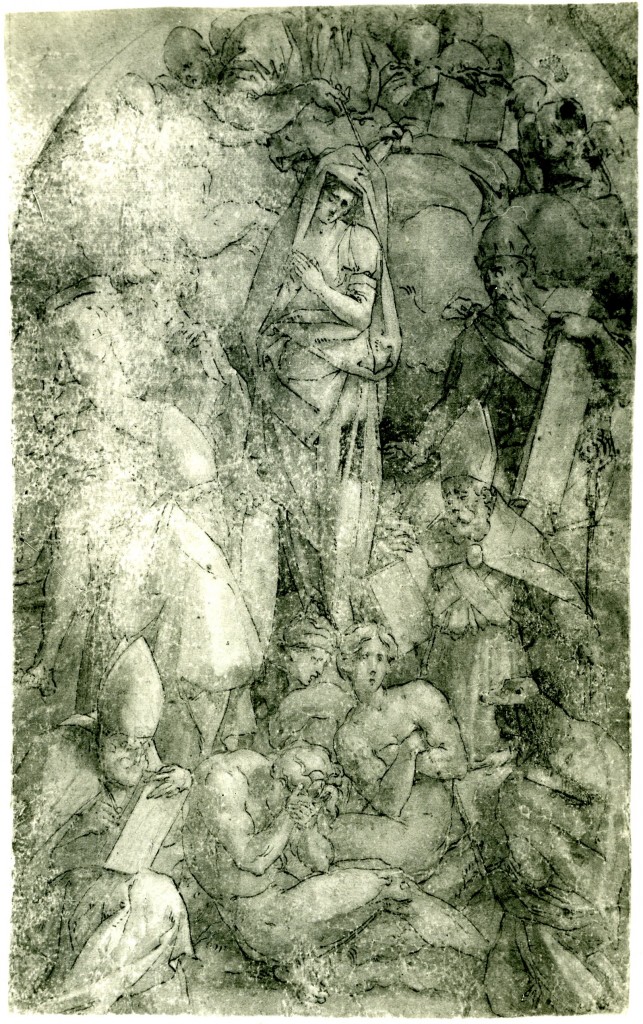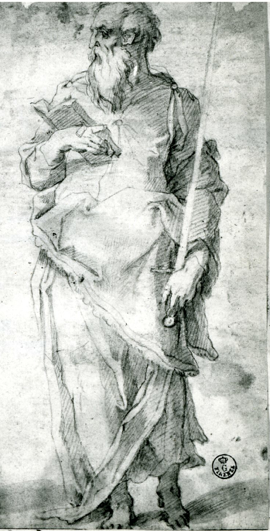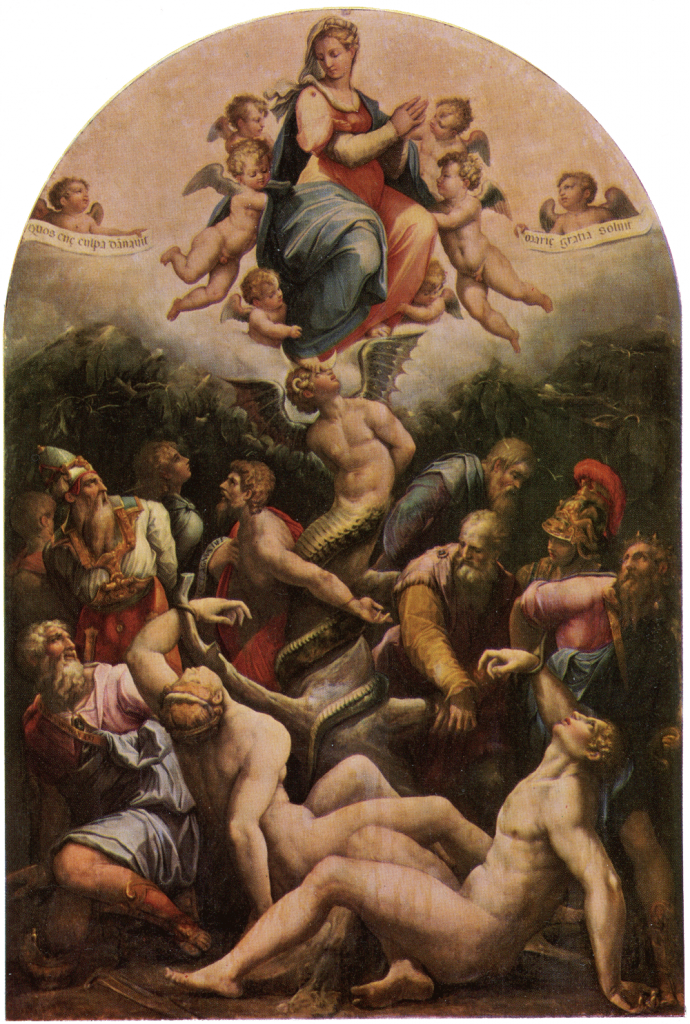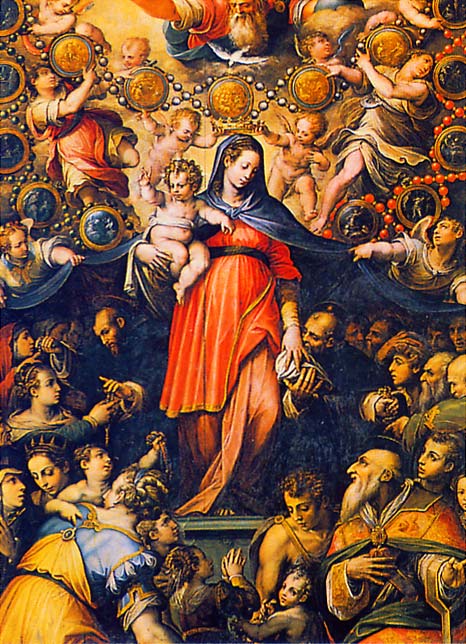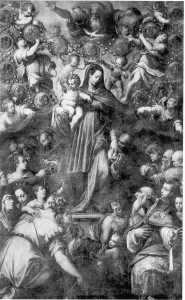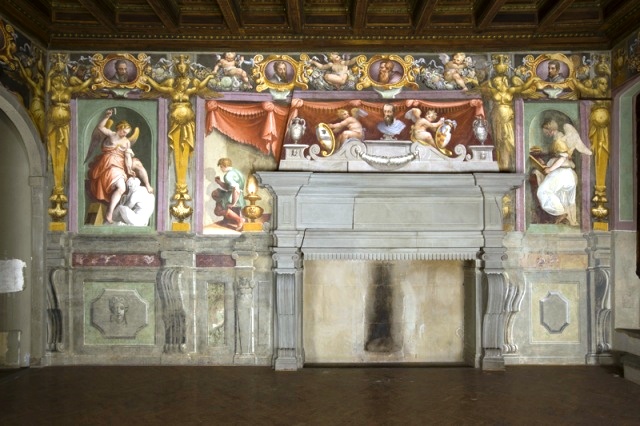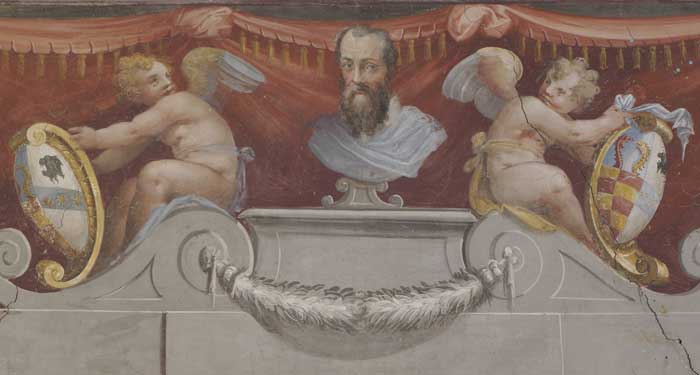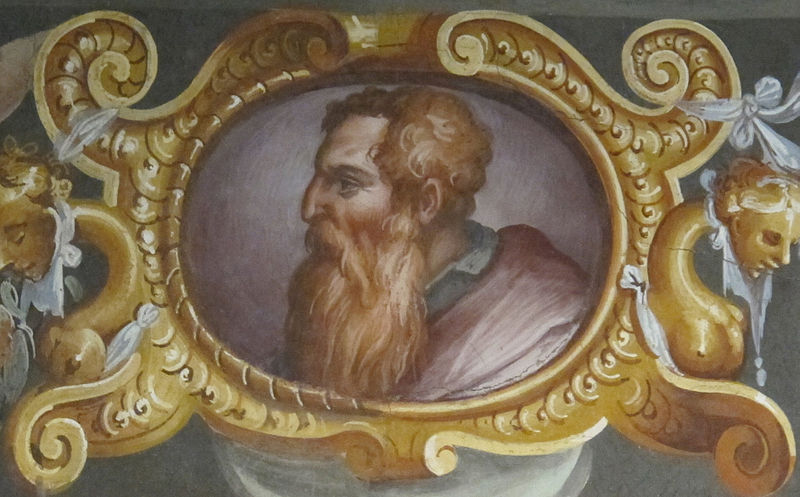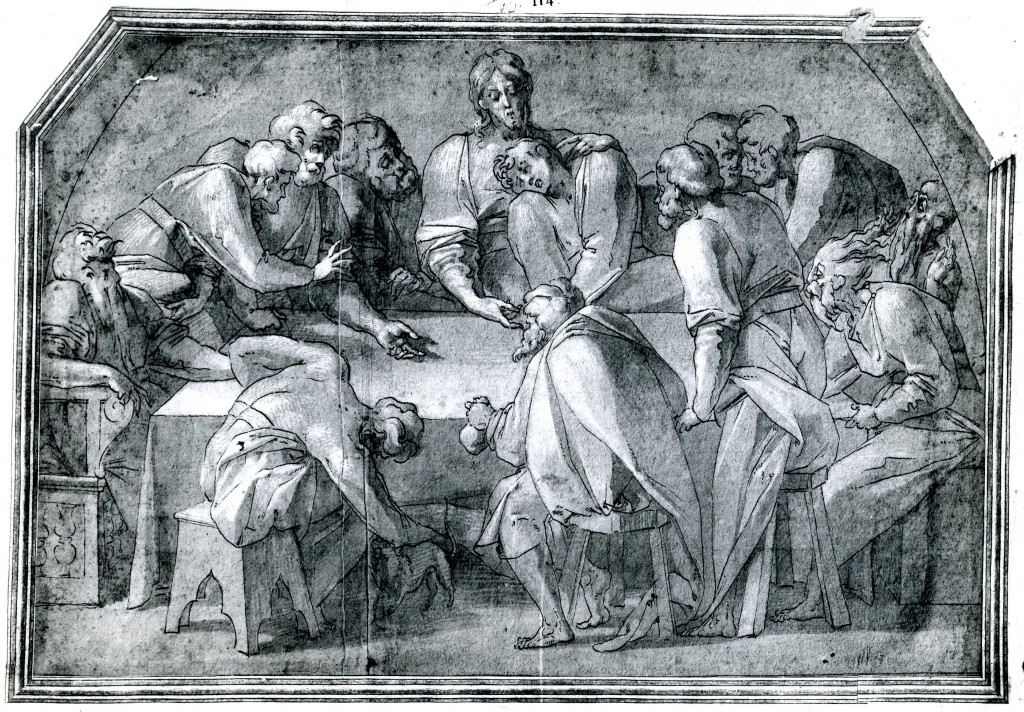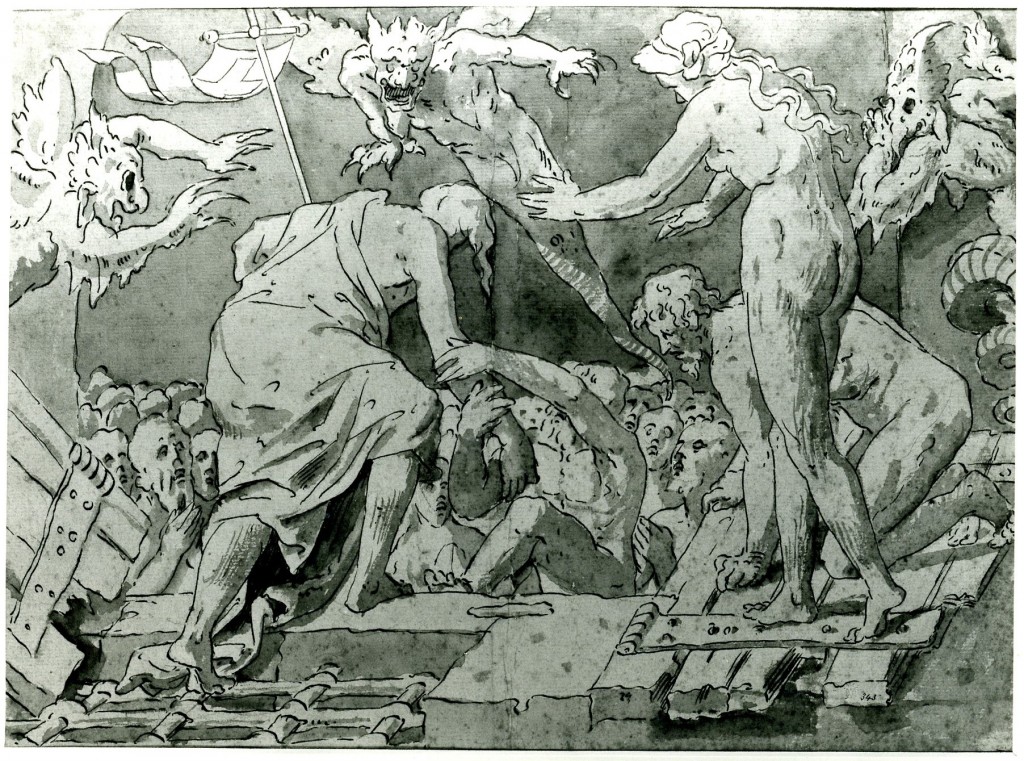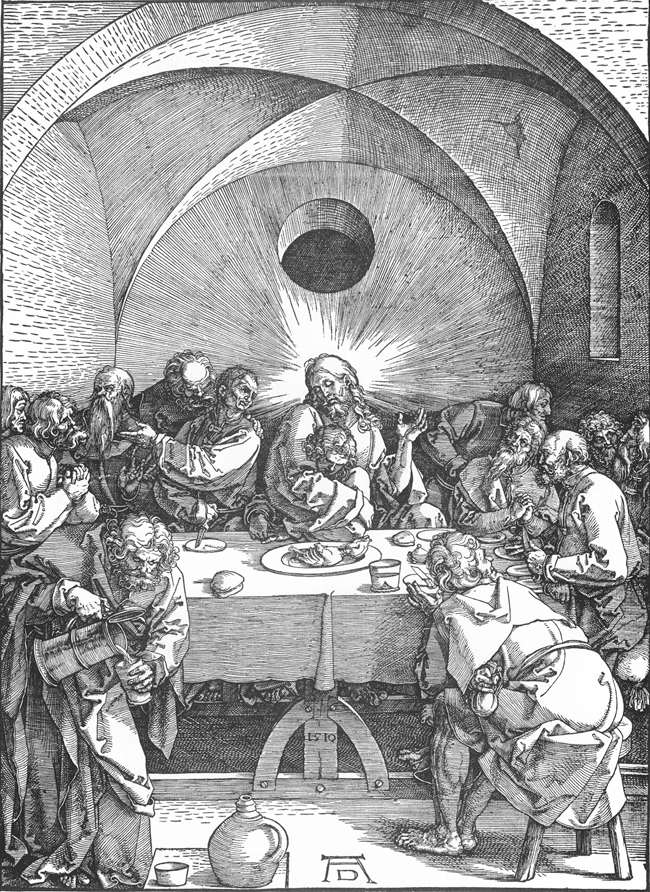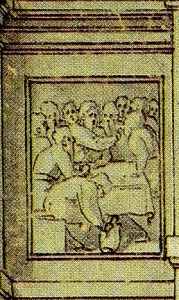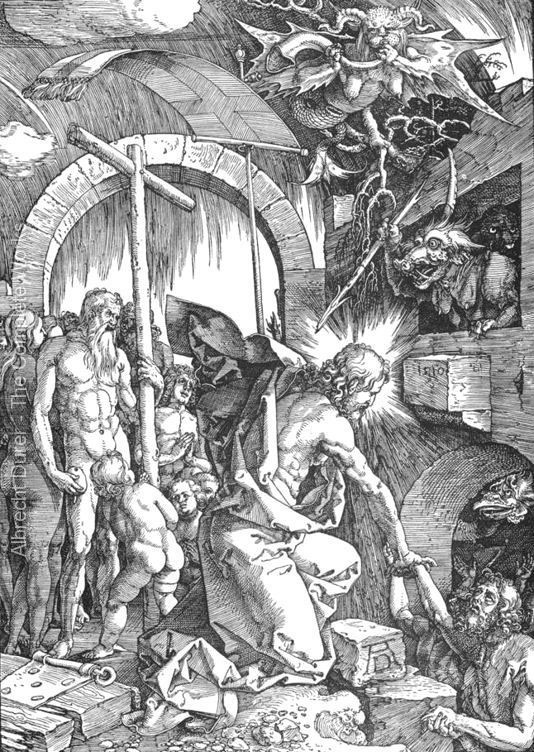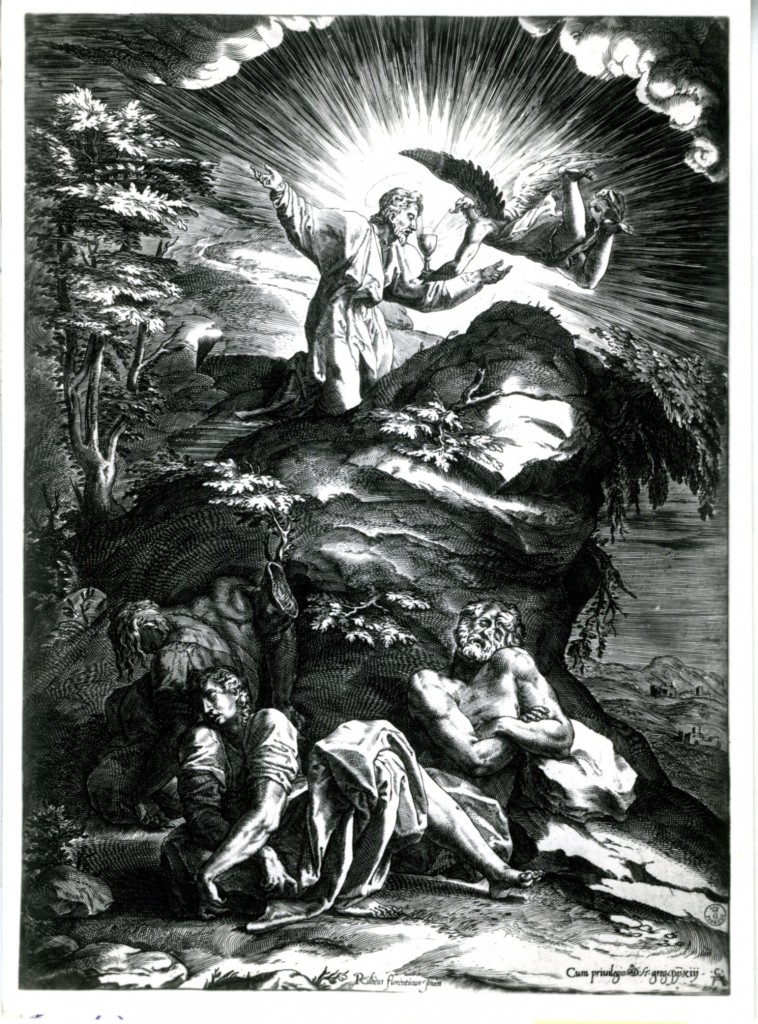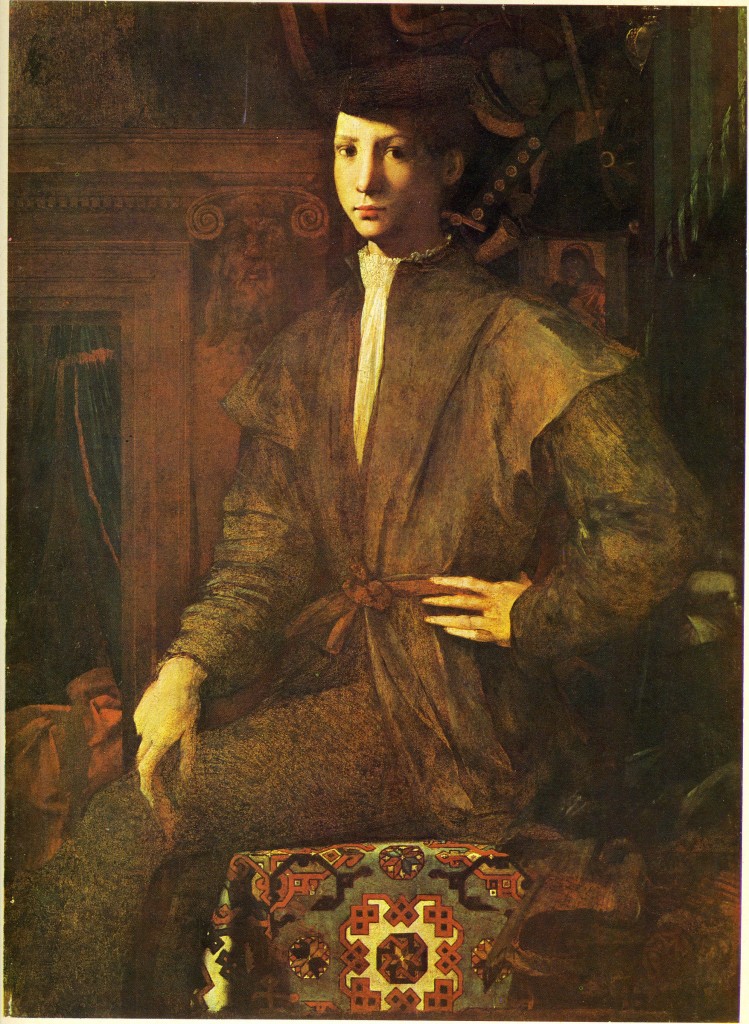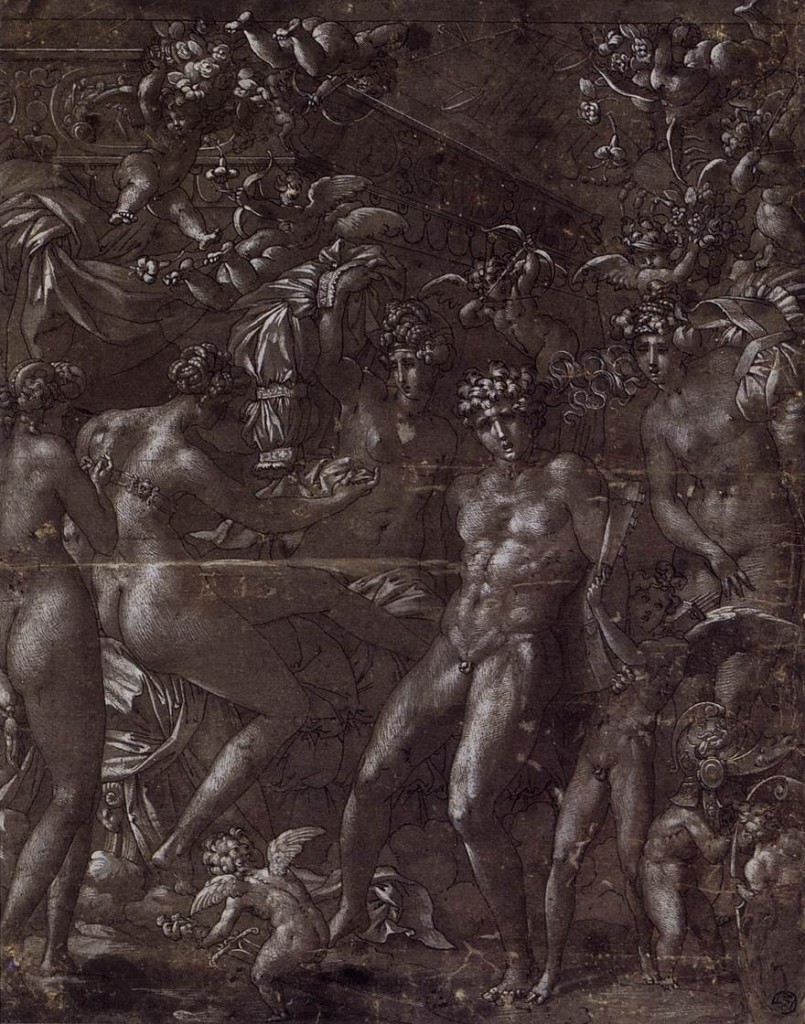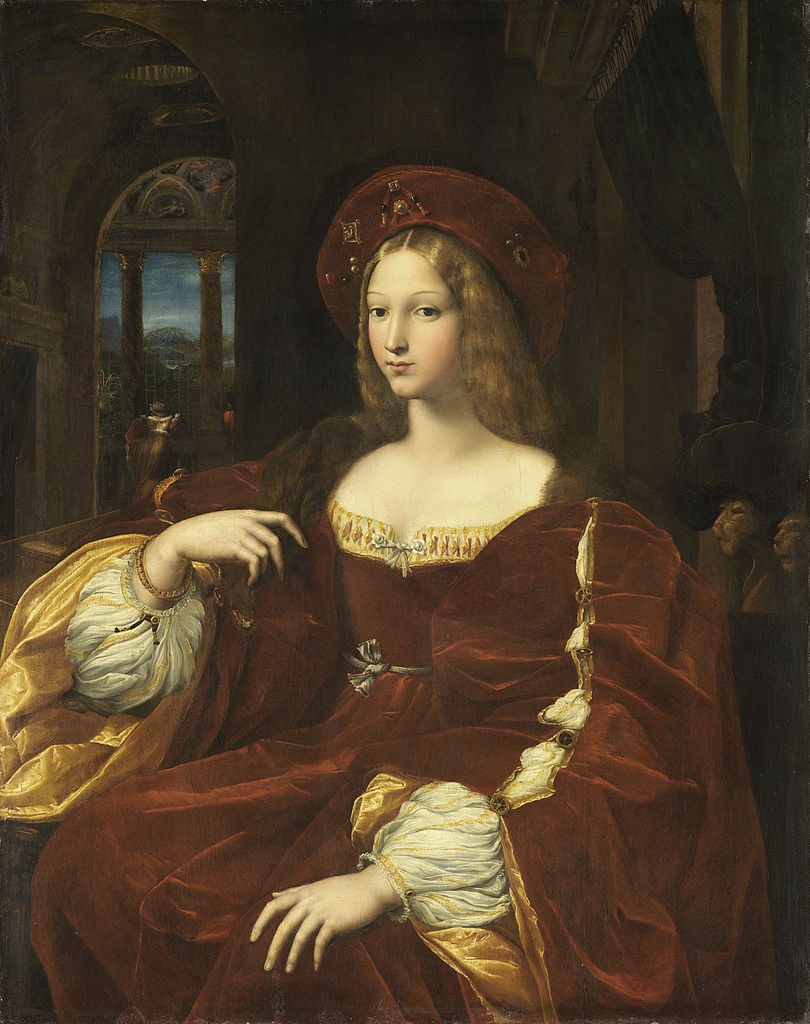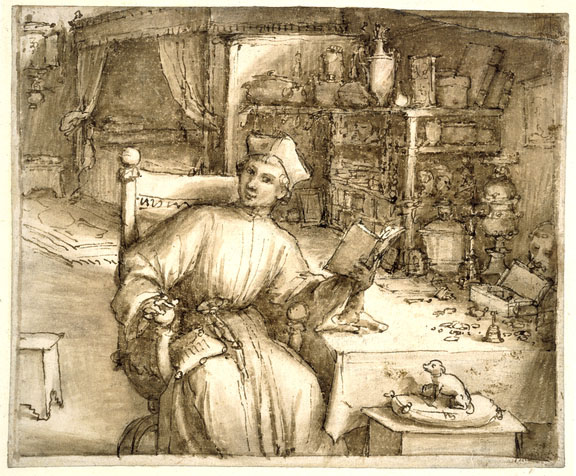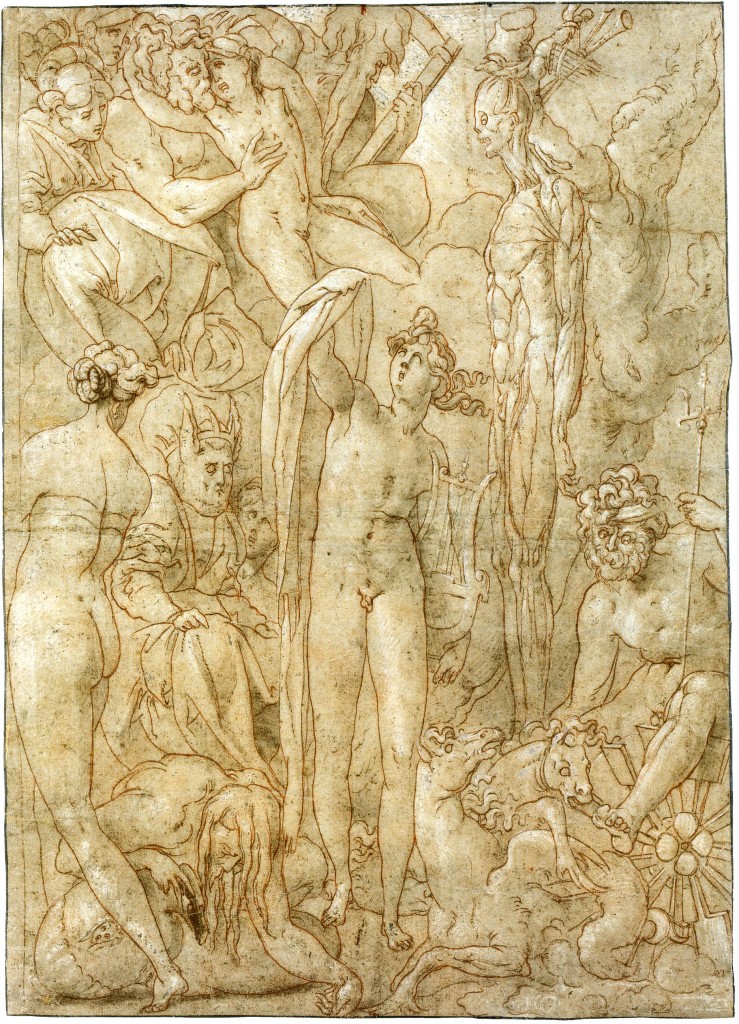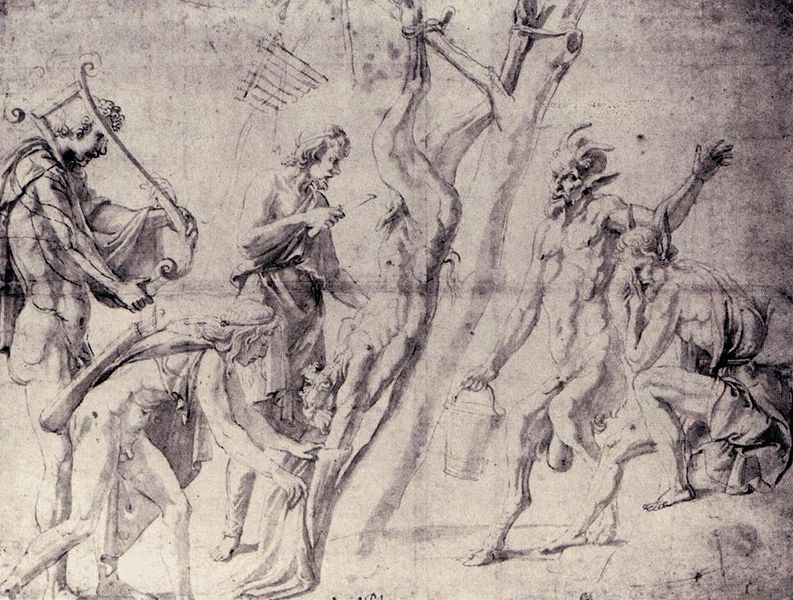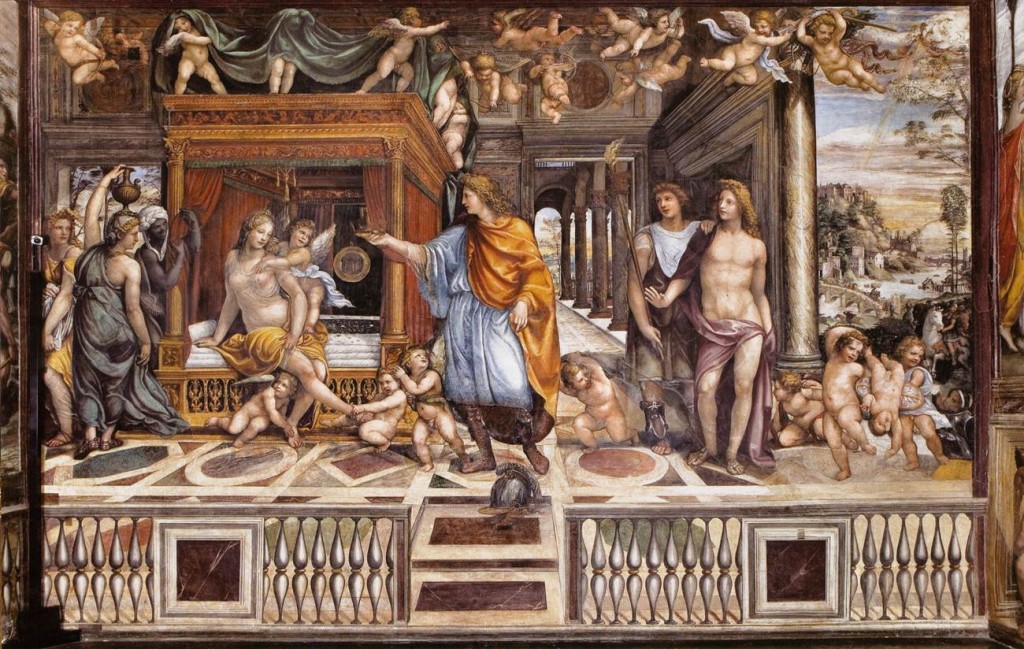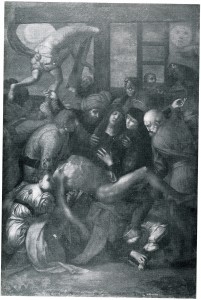Between the Fury engraved by Caraglio in 1524, that appeared in Rome following the fame of the Florentine Disputation of the Angel of Death and the Devil engraved by Agostino Veneziano in 1518, and the unfinished majestic Battle of the Romans and the Sabines begun by Caraglio early in 1527 in anticipation of the arrival of the armies of Charles V at the walls of Rome on 6 May 1527, Rosso composed twenty-nine disegni di stampe for one of the most exquisite collections of engravings ever made.1
Rosso was thirty-three when he fled the Sack probably when it reached a short reprieve during an outbreak of the plague in July that could have allowed Rosso to escape, meaning to reach Borgo Sansepolcre where Bishop Tournabuoi would receive him.
His stay in Rome had lasted a little over three years and had ended with as full an understanding of the possibilities of Roman art as that possessed by any of his contemporaries. The nature of that understanding, complete as it was, did not, however, require a full identification with it. Even as points were made in his art that he could be Michelangelesque or Raphaelesque, or antique in appearance, so, too, did the art show that his inventions were exclusively his own. For throughout his years in Rome the artistic formulations of his immediately preceding years in Florence maintained their value. He went to Rome like other Florentines to seek its benefits and learn from its artistic examples, but unlike others of comparable talent (but like the younger Florentine Perino del Vaga whose young Roman education significantly distinguished his early career from Rosso’s) he stayed because he thought he could and would hold his own against the authority of its art and its artistic milieu. In Florence he had learned by necessity to modify his unusual thoughts and feelings into what seem to have been acceptable but still very individual modes of expression. In Rome his abilities, both of self-evaluation and of accommodation, allowed the Romanization of his art, but prevented at the same time his complete surrender to the social manners and the artistic manners of that city. In several ways this Romanization was the maturation of manners of expression that had been well founded in Florence. In Rome he lost his first big commission and never recovered his reputation to those whose patronage might have offered significant success. Designing prints became his major occupation and the source of his income, and created fame beyond Rome and Italy.
PERUGIA
From Rome he first found his way to Perugia, a journey of about 170 kilometers. There he was cared for by Domenico Alfani whom he thanked by making “un cartone di una tavola de’ Magi”, the first of several works Rosso would do in the next three years for artists who gave him their help and their commissions. With many alternations the cartoon for Alfani was originally intended for the Adoration of the Magi formerly on the high altar of the Madonna dei Miracoli at Castel Rigone [Center in text medium size Fig.Alfani AS UNDER E.1].2
The composition of the lost cartoon is better preserved in an engraving by Cherubino Alberti done in 1574 [Center in text full size Fig.E.1]. Although reversed and likely generalized in small and distant details from what appeared in the original cartoon, Alberti’s print seems otherwise to be a good reproduction of Rosso’s design. Most details are specifically identifiable with those in the Marriage of the Virgin of 1523 and the Roman drawings of the life of Saint Roch. The print also seems to contain a couple of portraits.3
This gift to Alfani is one of the most remarkable inventions of Rosso’s career, coming after the years in Rome when he early on lost the opportunity to execute large narrative paintings. It is another of the several works, beginning with the Visitation drawing that he made for Lappoli in Arezzo on his way to Rome, that he continued to make for others in response to the help he received in the recovery of his career after his escape from the Sack of Rome. But he made this pursuit outside of Florence, which it now appears he had abandoned when he left it in 1524.
The number of figures in Rosso’s Adoration, the crowding of them especially at the left, and the disposition of them within a large architectural setting, bring to mind the just preceding Battle of the Romans and the Sabines. But the spatial organization of the Adoration is more closely related to that of the Saint Roch drawings, in particular the Saint Roch visiting the Plague-stricken (Fig.D.14B) with its diagonal open space leading from the foreground to the upper middle distance. In this drawing the woman bending over and seen from behind, derived from Pontormo’s Joseph sold to Potiphar (Fig.Pontormo,Potiphar), resembles the magus deeply bowing before Christ in Rosso’s composition for Alfani. This figure also resembles a magus in Pontormo’s Adoration in the Pitti (Fig.Pontormo,Adoration), a figure, however, that is not seen so much from behind, although somewhat more so than the old kneeling man he, in turn, resembles, in Pontormo’s Joseph in Egypt in London (Fig.Pontormo,Joseph in Egypt). Returning to the Joseph panel, that Rosso seems to have recalled when he did his Saint Roch Distributing his Father’s Worldly Goods (Fig.D.13), we have possibly also the source of the curving staircase in Rosso’s Adoration of the Magi and of the use of architecture to place figures high up in the scene. It is true that Rosso’s Adoration reflects none of the strange spatial relationships of Pontormo’s picture done almost ten years earlier. Instead, such relationships appear, as do similar references in the Saint Roch drawings, to have been reconsidered by a mode of invention that prefers the more normal appearance and relationships of what is described. The result in the Adoration is the most spacious composition of Rosso’s career up to this time. It is possible that both its normal aspect and its concern with space are what Rosso may have thought would please the Umbrian Domenico Alfani. However in painting his own picture from Rosso’s cartoon these characteristics were not especially heeded. This was mainly because the composition of the altarpiece was altered to give the Madonna and Child their central position in honor of the dedication of the church to the Madonna dei Miracoli and because Domenico Alfani’s talents limited his ability to appreciate the grand spatial arrangement of Rosso’s composition which instead the Umbrian artist filled with significantly more figures, including it seems several portraits than can be recognized in Alberti’s engraving.
Nevertheless, Rosso’s Adoration is more deeply understandable as an extension or elaboration of the aesthetic and expression of his Sposalizio of 1523. The Adoration is more complex and its figures may be more continuously plastic—there is no evidence in Alberti’s print of the faceting forms and surfaces in the altarpiece of 1523—but the proportions of the figures, their diversity, and the quiet but poignant drama of the scene, enriched by the light that rakes across it, are very much those of Rosso’s Marriage of the Virgin. Behind the Holy Family the architecture, partly in ruins, probably refers to the Old Testament, as the shed behind the camels at the right indicates the New. The placement of the Child on a raised block as though on an altar and being held reverently by both the Virgin and Saint Joseph, whose importance is almost equal to hers, conveys something of the same sacramental quality as the formality in the Sposalizio, with its extraordinary young and beautiful Joseph. Christ’s outstretched arms suggest his crucifixion. Looking back at Rosso’s Roman works, the Adoration seems hardly Romanized at all. Instead, one experiences what appears more like the enlargement of the possibilities of his Florentine art. In retrospect this seems, after the Loves of the Gods and the Romans and Sabines, a retreat from the demands of Roman art. At the same time, now out of Rome, the Adoration nevertheless reflects Rosso’s respect for the terms of that art as support for the more gentle aspects of his sensibility.4
The evidence of two good copies of two lost drawings, the originals probably made as independent nude studies that Rosso was accustomed to make almost every day, as Vasari relates, and then used in the Adoration, also points to Rosso’s reflecting upon the pre-Roman character of his art. Both drawings, in the Uffizi, of nude youths seen from the back, one standing (Fig.D.21) like the clothed young man in the foreground of the Adoration, the other seated (Fig. D.22) like one of the nude figures on top of the building in this composition, are very precisely rendered; the nuances of light and shade on the surfaces of the bodies have been very carefully observed and minutely recorded in a manner that recalls his study for the figure of Saint Sebastian in the Dei Altarpiece of 1522 (Fig.D.7). and the Seated Male Nude of around 1523 (Fig.D.9). While the poses of the two figures of 1527 may suggest the experience of Roman art, the easy bearing of these two nudes presents a relaxation of the strain apparent in so many of the works of the preceding three years. But, insofar as one can judge from these copies, they indicate a certain greater continuousness of light and shade and contour than is the case in the more patchy and static Florentine drawings. This change toward a greater plastic wholeness reflects again, however subtly, an aspect of his art in Rome.
Bishop Saint Resurrecting a Youth
Rosso’s career in the moment immediately following his flight from Rome is likely illustrated further by a drawing in the Louvre, possibly a damaged original than a fine copy of a lost drawing, for what could have been a fresco project for the back wall of a chapel surrounding its altar and what seems to be the profile of a small tabernacle. The composition of this scene, representing a Bishop Saint Resuscitating a Youth [Center in color Fig.D.23], with its asymmetrically placed architecture and loose arrangement of figures around a central diagonal projected back into space, resembles that of the Adoration, with which it shares also the same kinds of varied but in general normal appearing figures. The miracle scene is less spacious than the Adoration with the façade simply a planar backdrop, and the arrangement of its figures tends toward a slightly greater symmetry and formality, but these differences do not suggest a different artistic mode. Instead, one recognizes in these two compositions the extent to which Rosso brought back to mind the possibilities of the clear Florentine narrative art he knew before he went to Rome. His recollections are not in the nature of precise borrowings but the Bishop Saint Resuscitating a Youth reminds one, nevertheless, of the frescoes of Sarto and Franciabigio at SS. Annunziata. Rosso’s figures are more robust and his composition is denser but the effects of quotidian experience that surround the miracle, while not unprecedented in Roman art, as in Peruzzi’s Presentation of the Virgin in S. Maria della Pace (Fig.Peruzzi,Pace) appear more Florentine as recollections. Where these effects resemble aspects of Perino’s Roman frescoes (Fig.Perino,Visitation) they do so because both are Florentine in origin. Like the Adoration drawing for Domenico Alfani, the Lourve drawing may have been made for another artist to execute and Rosso’s drawing may in its clear narrative mode accommodate its style to this circumstance, perhaps still in Perugia where two of its three patron saints were bishops.
BORGO SANSEPOLCRO
Pietà
The composition of the Bishop Saint Resuscitating a Youth in the Louvre presents several similarities with Rosso’s Pietà in Borgo Sansepolcro, commissioned 23 September 1527 and probably completed by March of the following year [Fig.P.19a]. Rosso went to Borgo Sansepolcro probably in the late summer of 1527 to join Bishop Tornabuoni, for whom he had painted in Rome the Dead Christ in Boston. Given the similarity of the Louvre drawing to the Adoration designed for Alfani and to Rosso’s Pietà, it seems likely that the Bishop Saint resuscitating a Youth was done just a short while before the compositionally similar Pietà. But whereas the miracle scene is reasonably clear, formally and narratively, the Pietà appears extraordinarily complex, more so than any earlier work by Rosso.
The commission of this altarpiece for Santa Croce, compagnia di Battuti, according to Vasari, had been given for a small price to Raffaello da Colle, who, out of affection, now refused it wishing that it be given to Rosso so that a work by him would be in Borgo Sansepolcro. Here, however, it was not a matter of Rosso making a drawing that would be executed as an altarpiece by Raffaello, but a work solely by the newly arrived artist. Rosso was not, as with Alfani in Perugia, conceiving an altarpiece to accommodate another artist and his ambiance. Vasari named the altarpiece a Descent from the Cross as details in the background indicate, but the deeply pathetic appearance of Christ’s stretched out dark lavender body on the lap of the collapsed Virgin is what the worshiper first experiences as a Pietà. However it is in the moment in which Christ is still separated from his Mother to bear alone the meaning of the Eucharist. The Virgin, with long outstretched arms, the right arm held up at the wrist by Joseph of Arimathea wearing a bright red turban, his left arm in a black sleeve crossing his body and holding her arm lower down. The Virgin’s other is arm isolated in the dark at the far right behind the head of Saint John but is supported by Saint Scholastica, the twin sister of Saint Benedict,5 and one of the Maries whose left hand is pressed against the torso of the Mother of Christ. The Virgin’s arms are difficult to discover but are forcibly held back within the crowd of figures so that she cannot touch her Son, suggesting at first glance that Christ’s body is being taken from her lap. In the very center of the dark background rises the empty cross with extraordinarily wide horizontal arms, the top edges of which are not visible, hence suggesting a Tau cross as in the Deposition in Volterra. There, however, the chapel in which this painting was placed was dedicated to the Holy Cross. In Borgo Sansepolcro, the dedication was to the Corpus Christi and the cross was more darkly presented leaving Christ’s body as the primary focus of the altarpiece.
In its complexity it is not merely that the picture is dark “per avere osservato ne’ colori un certo che tenebroso, per lo eclisse che fu nella morte di Cristo,” but that the parts of the picture appear so tangled, even illegible such as that extended arm in black, the details so rich, and the highlights so scattered. It is true that there is much in the Pietà that recalls the Sposalizio of 1523, but that picture is largely legible (but for the crowd scenes in the shadowed background) as the later work is not. No earlier picture by Rosso is so complicated as this Pietà.
There is a figural denseness in the lower half of the Romans and Sabines composition but the compression of the forms and the spatial obscurities of the Pietà are not only so much greater than in the Roman composition, they also seem to rise from quite different aesthetic and expressive intentions. Suggestions for many of the elements in this altarpiece can be found throughout Rosso’s earlier oeuvre, from the Assumption at the Annunziata until after his flight from Rome. It is, therefore, possible also to see the Pietà of 1527–1528 as a composite of a large number of the terms of his earlier works brought together here to achieve, by their accumulation, a new kind of aesthetic and emotional significance.
It is likely that the impulse to shape a new artistic mode in the Pietà was stimulated by a visit to his native city from which he had been absent for over three years. We know from a document of 22 January 1528 (DOC. 11) that Rosso, in Borgo Sansepolcro, employed a Florentine attorney for any legal issues that might arise in Florence and elsewhere, suggesting, if nothing else, that he had recently the need to make arrangements in Florence.6 There is, furthermore, a drawing attributable to him done from Michelangelo’s David-Apollo [Fig.D.24] that could only have been executed in front of Michelangelo’s statue. The attribution of this drawing and the date of Michelangelo’s statue are controversial. But the point of view from which this statue was drawn has created an image the planarity of which across the viewer’s line of sight resembles the general disposition of forms in the Sansepolcro Pietà, and the handling of the drawing strongly indicates Rosso. It is likely also that Rosso’s Ideal Bust of a Woman in New York [Fig.D.25a] was done at this same time in Florence directly under the influence again of Michelangelo’s teste divine drawings7 or immediately thereafter in Sansepolcro when Rosso was working on the Pietà. The character of this head and the draftsmanship of it suggest that Rosso had access to Michelangelo’s drawings. The David-Apollo drawing would indicate that Rosso had access to his studio. It should also be recalled that Rosso’s pen drawing in the Albertina [Fig.D.26A] for the figure of Christ in the Sansepolcro Pietà is sufficiently Michelangelesque to have been seriously considered for a long time to be by Michelangelo himself. There is no earlier drawing by Rosso that appears as imitative of Michelangelo. Only the contemporary Ideal Bust of a Woman in New York appears comparably inspired, though by a different aspect of Michelangelo’s art.
While the pose of the figure of Christ in Rosso’s painting recalls Michelangelo’s Christ of his Pietà in Saint Peter’s,8 the emphasis on the anatomy of Rosso’s figure seems to owe more to the nudes of the Medici Chapel. The out spread pose of Rosso’s Christ recalls the Evening and Dawn. An imitation of these figures certainly is not to be recognized, but the significance of Christ’s body as conceived by Rosso in terms of an explicit description of its physical appearance resembles that aspect of Michelangelo’s Florentine figures more than the graceful body of Christ in Rome. In Rosso’s own art, such explicitness had been the case in many of his Roman works, and to some extent also, though more abstractly, in his Moses and Eliezer. The torso of the nude at the lower right of the latter painting resembles in fact Christ’s in Rosso’s Pietà altarpiece of 1527–1528. There is, however, a distinction here between the Sansepolcro Christ by Rosso and most of his earlier nude figures, including the nude Christ in his Roman Dead Christ: Christ’s anatomy in the Sansepolcro altarpiece, while carefully observed and finely described, appears objectified to an extent that almost prevents a sympathetic emotional response to it. The figures in his Disputation of 1517 come to mind. But there is also present something of the forbidding physicalness of Michelangelo’s Medici allegories. It is possible that both the appearance of Rosso’s Christ and the grand drama of his Pietà are also inspired by the grandness and the ethos of Michelangelo’s art. A wilfulness in the style of Rosso’s Pietà even suggests a response to the challenge of Michelangelo’s art, even though in Borgo Sansepolcro Rosso’s reaction would not have been recognized by many beyond Sansepolcro as an aspect of this achievement. Something similar had also been the situation in Volterra in 1521.
If Rosso’s picture is inspired by the grandness of Michelangelo’s art, it is simultaneously influenced by the small and exquisite ornament of his teste divine drawings. While in Michelangelo’s art fine detail is held in equilibrium with the large forms of his figures, in Rosso’s painting one senses an equivocal relationship between them. The skin-tight garment worn by the young man at the left in the Pietà, that recalls the garments worn by the men in Pontormo’s Entombment at S. Felicita of around 1526–1527 [Fig.Pontormo,Deposition], is, unlike Pontormo’s garments, covered with a pattern that tends to reduce the appearance of wholeness of the body of the figure. In the foreground the women, the posture of the Magdalen at the right resembling that of the simply dressed Magdalen in Fra Bartolommeo’s Pietà in the Pitti (Frate,Pietà), wear such elaborate dresses and have such complicatedly plaited hair that their larger formal significance, as well as their emotional value, are hard to appreciate dramatically. The bright highlights of the picture against a generally dark background, similar to those in Sarto’s slightly earlier and approximately contemporary works in Florence, are so scattered as again to disperse one’s attention from what might have been a more fully illuminated center of interest.
Vasari pointed out, writing at mid-century, how the picture was admired per avare osservato ne’colori un certo che tenebroso, per lo eclisse che fu nella morte di Cristo: per essere stata lavorata con grandissima diligenza. Rosso’s interest in an extaordinary kind of illumination in this Pietà recalls the moonlit Deposition in Volterra. In that picture the planarity of the figures bore, in its abstraction, a complementary relation to the unusual light in the picture. The light in the altarpiece at Borgo Sansepolcro is even more unusual. But the fine execution of the details in the picture, which belongs to the second part of Vasari’s praise, does not appear, in its brittle precision, to create a kind of equivalent to the strange illumination. Instead, in their artificiality, the details seem distant from any kind of natural phenomenon at all. On the one hand the painting effects one by its artificiality, on the other by its optical veracity to nature, which should be mutually exclusive. Here, however, they co-exist in a tense alliance with each other.
Looking back to the Volterra Deposition of 1521, details of which re-appear in the Sansepolcro altarpiece, it must strike the spectator how direct is the emotion of the earlier painting and how oblique, restrained, and concealed is that of the later altarpiece. In the Deposition the forms, while not large, are broadly and simply defined, in the Pietà everything is particularized. But this particularization instead of appearing, as it does in the Sposalizio of 1523, derived from the ways things can actually look when illuminated in a special way, is now of a kind that resembles finely wrought jewelry, such as that worn on the back of the woman at the lower left. The glittering details in the general darkness of the Pietà enhance its gem-like character, as does also the extraordinarily rich coloring of the picture. Unlike the Volterra Deposition, the Sansepolcro Pietà must be slowly observed, slowly discovered, and gradually absorbed as a presentation of the Christ as the Eucharist. Each detail complements another, their effect accumulating reciprocally around the head of the Virgin, and in sequences that move both inward and outward. The closed hand of Christ is set against the outspread hand immediately above it that supports the Virgin’s body. The two hands of Santa Scholastica, whose head is, to the viewer, at the right of the Virgin’s, support her under her arms, forming a triangle with the hands of one of the Maries beneath the Virgin’s breasts, but at the same time appearing as the thematic counterparts to the Virgin’s partly closed and raised hands farther out. However, the breadth of the gesture of the Virgin’s outstretched arms is obstructed by the heads of the two men—the one at the right probably Nicodemus9—who support Christ’s body so that it is only after careful investigation that one comes to understand the relationships of these details. At the far left and far right two pairs of hands, one, of a wailing woman, closed and held out, the other more open but placed against the face of the red-haired Saint John—as in the Volterra Deposition—respond, as it were, to the nearby hands of the Virgin. The larger gestures and postures of the figures similarly react across the height and breadth of the picture, and within its depth. As in the Sposalizio the symmetry of the Pietà gives cohesion to its detail. But the planarity of the Pietà and the elaboration of its details affect its symmetry to be less suggestive of actual emotion than of a ritualistic significance. This kind of meaning is part of every part of the altarpiece. It continuously enriches the picture at the same time, however, that it keeps the painting remote from us as the pictorial equivalent of an actual human event. Already in the Moses the emblematic premise of the Sansepolcro Pietà had been unequivocably defined. After his years in Rome the composition of this altarpiece could be even more elaborately and more complexly articulated, and yet also less exclusively as the sole artistic basis of his picture.
While the picture is very dark it is also very colorful but in a manner that lies deeply in the chiaroscuro context of the scene. In a black-and-white photograph the scattered highlights of the altarpiece so dominate that everything else in the picture seems to recede. In front of the picture, however, some of the colors in the shadows penetrate that obscurity to counterbalance the highlights. The large red-orange turban worn by Joseph of Arimathea10 to the viewer’s left of the Virgin is a very bright passage of color equal in its attraction to the light on the face and drapery of Saint Scholastica at the viewer’s right of the Virgin. For this red-orange turban is adjacent to the bright green of his garment and to the deep green dress of the Virgin. Furthermore, the most illuminated portions of the picture are not all brightly white. The drapery of the figure at the upper left is orange in the light, though dark olive-green in the shadow. Other highlighted areas are of colors that are not themselves intense. The youth behind Christ’s head wears a gray-cream garment with a tan pattern. The sleeves of the woman’s dress at the lower left are orange, but this color recedes into the shadow leaving her garment basically a monochromatic bluish green going white in the light and green in the shadows; the length of material falling over her thigh is a dark yellow-brown. The skirt of the Magdalen at the lower right is red-orange, but it is largely in shadow, and though the back of her blouse is yellow-white, the sleeves are gray, with orange bands. There is also a tendency for colors to change to other colors as the forms to which they belong turn from the light into shadow. Consequently, the color of the picture appears to have a kind of contrapuntal relationship to the chiaroscuro at the same time that it supports and is supported by its values. The over-all effects are of “un certo che tenebroso per l’eclisse the fu nella morte di Cristo” and of a circumstance in which a life has been spent.
The altarpiece was painted for the church of the Confraternity of S. Croce in Borgo Sansepolcro, called the Compagnia di Battuti by Vasari. Although a flagellant confraternity and one with a hospital that cared for plague victims,11 it cannot be said that the picture specifically addresses these interests. Christ body, while splayed out and lavender in tone, shows no signs of torture or disease. With the cross and the ladders in the background and one man still on the ladder at the left there are references to the Deposition from the Cross responding to the title of the confraternity and to the subject it requested.
“….on behalf of the said Society and its succeeding members, they [i.e., the officials listed previously] have supplied and leased a painting workshop and panel belonging to the said Society, which should be painted to decorate the larger altar of the aforesaid place, to Master Rubeo Iacopi Gasparis of the city of Florence, painter, respectfully present and receiving on contract, on his own behalf and that of his heirs, etc., the aforesaid panel for the said Society, for the purpose of painting it and creating a noble and appropriate picture. In the painting on this panel he should respectfully paint the body or image of our Lord, that is, when it was taken down from the Cross, together with other figures and forms that arrive and take part in the mystery and the aforesaid deposition, and the whole mystery should be painted with fine colors and other appropriate decorations.[fol. 182r]”12
The suggestion of a Deposition is also made by the support of Christ by two men at his head and foot who would have just lowered him upon the Virgin’s lap although the body, at once heavy in appearance and weightless at the same time, as yet barely touches her legs. The men who carry Christ seem not to strain against their load. The Virgin does not hold him as her arms are flung back in a gesture that tells of her agony and seems to reflect Christ’s arms on the cross, the horizontal bar of which is visible above her. She is dressed in green rather than the traditional blue, referring probably to the green of the cross on the garment worn by the members of the Confraternity of S. Croce.13 In the background and slightly to the right of center is a hideous figure with a spear resting on one shoulder and a shield held up at his other side. He has no nose, his eyes are crossed, and his mouth bears an expression, with the teeth visible, that could be interpreted as a cruel smile. His shield and spear would seem to indicate that he is one of the executioners. But the physiognomy that Rosso has given this figure is not required for the description of a Roman soldier. This figure may represent Satan whose ultimate success would seem to have been achieved with the death of Christ. The emphatically deathly depiction of Christ’s body, so unlike that in his earlier pictures in Volterra and Boston, reinforces, in an almost macabre manner, the finality of Christ’s life. But above Rosso’s altarpiece in a lunette [Fig.Raffaellino del Colle, God-the-Father and Angels AS IN P.19 AND PLACED ABOVE A FIG. OF ANOTHER IMAGE OF THE PIETÀ] painted by Raffaellino del Colle who had ceded the commission of the Pietà to Rosso when he came to Borgo Sansepolcro—”acciochè in quella città rimanesse qualche reliquia di suo“—there is a full-length figure of God the-Father looking down toward Christ. Beneath him is an angel holding open a book that bears a large alpha and a large omega. The design of this lunette, which is similar to that above Raffaellino’s Annunciation in the Pinacoteca in Città di Castello,14 is clearly Raffaellino’s and was either made to fit with Rosso’s picture or belongs to Raffaellino’s original commission, the subject and size of which Rosso had to accept, along with the newly designed altar and choir to which it belonged, that included the frame of the picture and its lunette, one would suppose. For if the devil of Rosso’s painting is about his supposed victory, the message of the lunette reveals to the worshipper the falseness of that supposition.15 The role of this startling figure in the Sansepolcro altarpiece is not unlike that of the young and handsome Saint Joseph in the Sposalizio of 1523. The youth of this bridegroom, as mentioned before, may have been intended to deceive the devil as to the paternity of Mary’s forthcoming child. A comparable kind of deception may be meant in the later Pietà, and therefore there may also be intended a meaning related, tangentially, to that of the Disputation of 1517. What is presented, in other words, is a significance that is by intention oblique and obscure, requiring for discovery an investigation into the appearance of things that tends to remove one from a too immediate experience of visual and emotional values. This had already been an aspect of Rosso’s somewhat difficult to comprehend Assumption of 1513–1514.
In several respects the Pietà reflects knowledge of Pontormo’s Deposition in S. Felicita in Florence at the same time that Rosso’s painting is conceived in fundamentally different stylistic terms [PAIR Fig.P.19a and Pontormo, Deposition]. The skintight garment of the young man at the left is new to Rosso’s art but is found, though undecorated, in Pontormo’s altarpiece. More important, however, is what appears to be a kind of correspondence in these two pictures, in spite of their slightly different subjects, of the thematic relationship between the Virgin and Christ’s body and between them and the attendant figures. One group of figures cares for and attends to Christ’s body; another group supports the swooning Virgin. Through this separation the figure of Christ, though still associated with the Virgin’s sorrow, maintains also an autonomous value for the spectator. Placed above the altar immediately before one at mass, that body is for the spectator the Corpus Christi of the Eucharist, that Corpus sive immago Domini nostri that the altarpiece was to honor. Here there is a similarity to the Roman Dead Christ, painted for Leonardo Tornabuoni, the bishop of Borgo Sansepoclcro, who would seem to have been influential upon Rosso receiving the confraternity’s commission, and who had a special interest in the Eucharist, in the administration of the sacraments, and in lay fraternities.16 But in the differences of the presentation of Christ’s body to us we can begin to know the almost opposite attitudes of Pontormo and Rosso. In the S. Felicita Deposition Christ’s body is brought toward us, to the altar;17 in Rosso’s Pietà the body is inert and stretched out in front of us, above the altar for this moment of the drama. Its forms are particularized and angular. Pontormo’s Christ is supple, even sensual, and appears as though he could be merely asleep. This too had been his appearance in Rosso’s Deposition of 1521. But in the Pietà he is decidedly dead. Pontormo’s figures are broadly and consistently rotund and they are so turned within the composition as to generate a sense of all-pervading feeling of numbness and of a suspension of actual mass by the figures’ grief.
Several of the major figures in Rosso’s altarpiece are seen in profile and almost all are so clearly balanced one across from the other such that the scene appears static and emblematic rather than immediately moving. The complicatedness and darkness of the Pietà are also opposed to the clarity of Pontormo’s Deposition. It is as though the two pictures presented two poles of artistic expression in Tuscany in the middle of the 152os. This is not wholly true only because Rosso’s picture is to some extent dependent upon Pontormo’s, but because they both also share an interest, albeit of different kinds, in Michelangelo’s art. Furthermore, there is the relationship of Rosso’s picture to Sarto’s contemporary style with its steadfast adherence to the terms of his earlier art carried to a point that might almost be considered dogmatic. While this aspect of Sarto’s art, as represented by the Gambassi Altar [Fig.Gambassi Altar] and the Passerini Assunta [Fig.Passerini Assunta MAKE A PAIR OF THESE TWO PAINTINGS], is not obviously related to Pontormo’s, it is reflected in Rosso’s. The Sansepolcro Pietà has the severe symmetry and hard brilliance of Sarto’s paintings but at the same time it exhibits remarkable elaborations upon them. The extent to which these elaborations carry Rosso’s image beyond Andrea’s matter-of-factness can be identified with the extraordinariness of Pontormo’s Deposition. But Pontormo’s expression is deeply about human feeling, suffering, loss; Rosso’s largely is not. For him there is a kind of meaning that is other than that conveyed by the representation of emotion alone. There is the fact of death itself, and in his Pietà, the ritualistic attendance to it. In the background of this scene, immediately to the left of the cross, appears Rosso himself [Fig.P.19e,Pietà,Self-portrait ADD ALSO TO CAT. P.19] 18 as Pontormo appears in his altarpiece in S. Felicita. Also, Rosso’s Christ has bright red hair and beard, brighter than in the Volterra Deposition. Although the appearance of Christ with reddish hair is not uniquely Rosso’s conception, the degree to which it is red in this picture is unusual. One cannot avoid the suggestion, made also by Darragon in 1983, that Rosso identified himself with his dead Christ.
The Michelangelesque pen drawing in the Albertina for the figure of Christ in the Borgo Sanspolcro altarpiece [CENTER Fig.D.26 REPLACE IN COLOR] was carefully drawn from life and from a slender, broad-chested model of a type frequently found in Rosso’s art. His torso and right leg have been propped up, and this pose has been almost exactly repeated in the painting although the body there appears supported by two figures. However, the placement of the old man’s hand under Christ’s right thigh in the painting seems little more than a gesture. For the right leg of Christ seems to have no weight, and the fall of the lower half of the leg does not accord with the support described in the painting. Consequently, while the figure from one aspect looks explicitly realistic, from another, in terms of its functioning as a dead body, it is not. The pose in the drawing has been slightly altered in the painting so that the forms are more nearly parallel to each other. Similarly the anatomy of the figure has been regularized from its more natural appearance in the drawing. To some extent the same was true of the transfer of the red chalk drawing of a nude in the Uffizi [Fig.D.7] into the figure of Saint Sebastian of the Dei Altarpiece. But the underlying anatomy of the figure of Christ is emphatically exposed like that of the Roman Fury and it is similarly patterned to make of its realistic data a spectacle that goes beyond mere verisimilitude.19
Given when the Sanspolcro altarpiece was done and the extensive literature on it, only Franklin mentioned the Sack of Rome in relation to Rosso’s painting by commenting that the simian-like soldier holding a shield perhaps personifies the artist’s attitude toward soldiers following his brutal treatment by them during that horrendous catastrophe that the artist has personally experienced. The evil aspect of this figure has often been noted by others but only in relation to the content of the picture. Chastel wrote of the picture in his extensive account of the Sack, and yet without mentioning this monstrous figure: “A simple, almost rudimentary symbolism has been used here to blend a personal view of bereavement or actual melancholy into a traditional and pious representation of death,” writing of all of Rosso’s works of these years as “disjointed and muddled to the point of revealing an uncontrolled nervousness and a strange lack of technique.” This is hardly the only way that the Sansepolcro altarpiece can be experienced as Rosso’s first painting begun only two months after his flight from that hell that Rome had become. And “lack of technique” seems a strange observation of a picture that is masterfully painted.
The scene takes place on Golgotha in a darkness that Vasari noted as the tenebroso of an eclipse of the sun, leaving the light of the moon to shine upon the foreground figures. All the major figures of a deposition are there but the lowering of Christ’s body, that is the event of the Volterra altarpiece, has already taken place and the somber gray-lavender corpse appears at the moment of its placement upon the Virgin’s lap. She has fainted and her arms are held widely open to accommodate her son’s body. Within its gloom the scene becomes remarkably splendid around the dark body, such that the historical narrative is itself displaced by the presentation of Christ’s body, dead but not disfigured, and without the expression that he has in the earlier Deposition. The elaborateness of the costumes and coiffures, the variety of the colors, the fine execution of the details, are all in the service of the presentation of that sacred body and appropriate to the mystery of the deposition that the artist was charged to create. That mystery here approaches the aspect of a relic in a splendid reliquary. It should be recalled that the picture would be set in the design of a new altar and choir, replacing a Crucifix that had been on the high altar.
It is possible that the central image of death and of the collapse of the Virgin, set against the gloom of the background that penetrates the spaces between the closely placed figures in the foreground, in which that monstrous simian face of evil is a detail, is, as the altarpiece it also was, Rosso’s votive to the miracle of his surviving the Sack of Rome. There is no other picture by Rosso that matches the brilliance of this altarpiece until the Pietà in the Lourve [CENTER MEDIUM SIZE Fig.P.23a], painted for the chapel of the Connétable Anne de Montmorency at Écouen, that shows a concentrated recollection of the Sansepolcro painting. The posture of Christ and the depiction of eaglettes on the pillows under him approximate the coat-of-arms of Montmorency that appears several times on the vaults of the chapel, indicating a personal identity with the Connétable. Here, in the Louvre painting, the site is not Golgotha but the area before the cave in which Christ’s body would be placed. Again, however, it is not clear that this body had just been placed on the Virgin’s lap or that it is about to be removed for burial. The open wide and entirely visible arms of the Virgin make both interpretations possible.
Rosso’s Ideal Bust of a Woman in New York [ CENTER LARGE Fig.D.25a] shows the influence of Michelangelo’s teste divine drawings to be largely one of motif than of structure. The kind of headdress with a pair of ram’s horns worn by Rosso’s woman, suggesting that she is Venus, is very similar to that of Michelangelo’s testa divina drawing in the British Museum, the fine but almost impersonal handling of which closely resembles Rosso’s [CENTER MEDIUM SIZE Fig.Michelangelo, Testa Divina].20 The handling of the waves over the forehead is so similar in both drawings as virtually to document Rosso’s closest study of Michelangelo’s drawings. This seems also indicated by the pen drawing in the Albertina for the figure of Christ in the Sanspolcro altarpiece, but there it is the study of another kind of Michelangelo’s draftsmanship. Compared, however, to Michelangelo’s bold and integral conception, Rosso’s ornamental head seems merely the summation of its decorative details. Unlike Michelangelo’s head, Rosso’s Ideal Woman, seen partly from the back but with her head turned slightly forward beyond a strict profile, appears, however anachronistic, merely fashionable and almost coy. The austere richness of Michelangelo’s head has been replaced by what seems more like decoration in Rosso’s art. The head, however, recalls Rosso’s earlier flirtatious Phylira, but hardly at all his Roman Head of a Woman in the Fogg Art Museum.
If the Sansepolcro Pietà presents a dogmatic tightening of Rosso’s style in terms both of the composition of the picture as well as the explicit description of its details, then the next work we have by him indicates a broadening of this manner. It is not an autograph painting nor even a good copy in the ordinary sense. It is rather a damaged but recently finely restored altarpiece of the Adoration of the Magi by Giovanni Antonio Lappoli for which Rosso provided the design (L.21), probably early in 1528 when the Aretine artist visited Rosso in Borgo Sansepolcro. The picture was painted for the high altar of the church of S. Francesco in Arezzo.
[CENTER LARGE see COLOR L.21 Fig. Lappoli Magi b]
Except for a few similar motifs, and a similar importance given to Joseph, Lappoli’s Adoration differs significantly from the composition of the same subject that Rosso designed less than a year earlier for Domenico Alfani in Perugia. Lappoli’s picture is not simply a narrative scene, for with the appearance of Saint Francis and Saint Anthony of Padua in the foreground it takes on also something of the character of a sacra conversazione. There is, therefore, a certain correspondence between this altarpiece and Rosso’s Marriage of the Virgin of 1523 as well as his design of Lappoli’s Visitation of 1524 where Mary Magdalen and King David appear in the foreground [CENTER MEDIUM SIZE COLOR Fig.Lappoli,Visitation]. But the later Adoration for Lappoli is much grander and more formal in its conception than is either of these earlier altarpieces. Its greater formality suggests the composition of the Sansepolcro Pietà and yet with significant changes to the plan of that picture. The Pietà is very densely composed with the figures placed very close to each other, both side by side and in layers within the depth of the picture. The Adoration has fewer figures, and also far fewer than in the very fully populated composition designed for Alfani. The figures are relatively widely spaced so that most of them overlap very little, and they are arranged not so much in layers back into space but rather with one figure above the other and matched with its varied counterpart across from it. The figures are broadly defined and although this is undoubtedly partly due to Lappoli’s limited abilities as a painter it also accords with the broader compositional properties of the picture. The two saints in the foreground and the Virgin in the center form a very clear pyramid; the other figures are arranged symmetrically at either side in postures that indicate their roles as magi and attendants. But even the deeply bowed posture of the magus at the right or the reciprocating Child and Joseph to the left do not hinder the large formal effect of the picture. One is reminded of the severe order of Sarto’s approximately contemporary Gambassi Altarpiece. But in the postures and placement of some of the figures and in the degree and ease of variation within its pyramidal formality Rosso’s design also recalls Leonardo’s Adoration of the Magi of 1481. Rosso had studied this picture earlier, as shown by his Disputation drawing of 1517, but it is possible that he studied it again in Florence late in 1527. But now Leonardo’s Adoration was not seen so much in terms of the multiplicity of effects within its composition but in terms of the larger components of the design itself.
As with the cartoon for Alfani, that Rosso seems to have used for his drawing for Lappoli, figure studies were made independently of any composition in mind. A copy in Rennes shows very detailed studies of feet and a left hand [Fig.D.26] that were utilized by Rosso for the figure of Saint Francis, giving some idea of how specific the lost drawing for Alfani’s altarpiece was. It is possible that Lappoli also knew Rosso’s other individual studies that were used for this altarpiece drawing.
AREZZO
At some time between late March and 20 April 1528 Rosso went to Arezzo.21 There is some likelihood that this visit was only a stop on another trip to or from Florence, the experiences of which may be reflected in his immediately subsequent works. When he was in Arezzo he met the young Vasari and obtained for him the commission of a Resurrection from the Aretine Canon Lorenzo Gamurrini on 20 April. He also supplied Vasari with a drawing for it that has been lost (L.22), as has Vasari’s painting. While the specific nature of this contact between Rosso and Vasari cannot be judged, there is no doubt that this early work like most of Vasari’s earliest surviving works showed the unmistakable imprint of Rosso’s style.
CITTÀ DI CASTELLO
Possibly through the aid of Bishop Leonardo Tornabuoni, who was appointed governor of Città di Castello in 1527, Rosso received on 1 July 1528 the commission for an altarpiece from the Compagnia del Corpus Domini of that city (Fig.P.20a). Not painted until the end of 1529 and the early months of 1530 it was, however, first planned in the summer of 1528 in Città del Castello. From that time three drawings, an original and two copies, indicate that the painting was at first conceived somewhat differently from its final appearance. The evidence of these drawings also suggests very recent contact with Florentine art and a response to it noticeably different from what seems to have been the response earlier in the Sansepolcro Pietà and in the drawings approximately contemporary with that altarpiece.
The contract of 1528 called for an altarpiece con la figura de uno Cristo resuscitato e glorioso con la figura de la Nostra Donna a con la figura de Sancta Anna, con la figura de Sancta Maria Madalena e con la figura de Sancta Maria Emptiana [Egiziaca], a de basso in dicta tavola più e diverse figure che denotino e representino el populo, con quelli Angeli che a lui parera de acomodarre; … Here is prescribed the composition on two levels of the executed painting, as well as the saints and populo that appear there without, however, the Angeli that were requested. Basically the first composition of this altarpiece was the same as that of the finished altarpiece with an upper and lower part, but the postures, disposition and garments of some of the figures were changed, giving to the bottom half of the picture, at least, a slightly less rigid and formal appearance than that of the completed painting. The four female saints at the top seem all to have been originally thought of as less clothed.
A poor and altered copy of a drawing by Rosso in the Louvre [Center Fig.D.27A] gives his early conception of these four female saints, showing the central two directly facing each other. The space between this pair that would show the figure of the risen Christ has been eliminated (although we do not know the placement of these figures in relationship to Christ in the lost original drawing). While this omission is confusing it is very likely that the drawing is otherwise a fairly accurate record of the appearance of these four women in the lost drawing. Two of the four women, one of them occupying the position of the Virgin in the painting, are nude above the waist. Saint Anne, whose head and shoulders are covered, has bare arms and possibly a bare torso. Only the fourth saint at the far left is amply covered, although her nipples are indicated through her dress. Both of the Virgin’s arms and hands are clearly visible in the drawing while in the painting her left arm is only barely seen and her left hand not at all. The folds of all the drapery of the figures are less complex than in the painting.
The early composition of the bottom of the picture is represented by two drawings, one a spirited copy in the Uffizi [Fig.D.28], the other a fine drawing in the Gabinetto Nazionale in Rome [Fig.D.29] PLACE THESE TWO IMAGES LARGE ABOVE EACH OTHER IN THE CENTER. The drawing in Florence must copy an earlier drawing, and like the drawing in the Louvre it shows some of the figures less clothed than they are in the painting. The drawing in Rome and the Uffizi drawing indicate that originally the center of the lower scene was conceived to show a seated or kneeling woman facing forward and looking up and gesturing with her right hand toward a man who stands before her. He was turned away from the spectator but with his arms extended toward the viewer and downward in the direction of a child with a dog seated on a step at the lower right. This child and dog are identical, though reversed, to the group at the lower left of the Bishop Resuscitating a Youth. Three men are at the right instead of two as in the altarpiece. At the left is a man, behind the seated women, facing forward and holding a bundle of drapery. He is the figure who wears a helmet in the very center of the finished picture. The drawing in Rome shows the same figures, but only two men at the right and not the man to the left holding a bundle of drapery although a vacant space appears where he could be placed. The standing man in the center is more fully clothed and the position of his arms is slightly changed so that they are not seen directed toward the child, who is here only lightly sketched, but rather toward the viewer. All of the figures are also broader and more robust in appearance. Furthermore, in the drawing in Rome there appears the woman and child at the left who are almost identical to those in the finished altarpiece. This group is similar to one in the foreground of the Romans and Sabines engraving.
From the two drawings in Rome and Florence it is possible to have a rather clear picture of what Rosso originally intended for the lower half of the altarpiece. If the drawing in Rome presents the full breadth of the composition, which seems to be the case, then it was flanked by a standing figure at each side and had a playful child in each corner. The center was occupied by three figures, a seated woman nude from the waist up, a standing man before her with his back toward us, and behind the woman, a man leaning forward, also nude from the waist up, as he is in the painting, clutching a bundle of drapery. It seems also that the outward diagonal gesture of the foremost man continued the similar recommending gesture of the Virgin at the top of the picture.
This remarkably mobile arrangement of plastic forms in space, including the way they relate the top of the picture to the bottom, recalls Raphael’s Transfiguration, the subject of which is similar to that of Rosso’s picture. But if Raphael’s painting was recalled by Rosso it was only in the most general terms as no specific motifs suggest any greater dependence. What Rosso’s design more clearly indicates is the study of Pontormo’s recent paintings and a more profound concern with them than is suggested by the merely Pontormesque incidents in the Sansepolcro Pietà. The heads of the two women in the Rome drawing are very much like the two immediately to the left of the Virgin’s head in Pontormo’s Entombment in S. Felicita, and the smooth and full forms of Rosso’s figures resemble Pontormo’s. But in addition to these specific similarities there is also the compositional relation of Rosso’s central figures that is Pontormesque. As in Pontormo’s Entombment Rosso’s figures turn obliquely into the space of the picture and in a revolving contrapuntal manner in respect to each other. No one figure fixes the center of the composition of the lower half of Rosso’s early conception for his picture as none does in Pontormo’s altarpiece. The figure with his back to us may have been inspired by the woman turning toward the Virgin in Pontormo’s Entombment, although the swing of his body and limbs looks even more like that of the foremost figure in Pontormo’s Legend of the Ten Thousand Martyrs in the Pitti [Fig.Pontormo,Legend]. If this association between Rosso’s drawings and Pontormo’s small picture in the Pitti is true then the latter would have to have been designed by mid-1528. The painting itself is generally dated a year or two and even three years later on the basis partly of Vasari’s testimony, although it has also been dated around 1528–1529.22 What, however, is also likely, rather than any specific dependence of Rosso’s design upon Pontormo’s Legend of the Ten Thousand Martyrs, is Rosso’s independent renewed exploration of Michelangelo’s art stimulated by Pontormo’s Michelangelism in his Entombment. Rosso’s figure turning into the composition is actually a more evolved version of a similar Michelangelesque figure that appears, clothed, in his early Assumption, and as Adam in his Roman Temptation of Adam and Eve of 1524. But there is no earlier figure that is so rhythmically complex and supple as the one in the foreground of the drawing in Rome. While Rosso seems to have studied Michelangelo’s Medici Chapel figures, or drawings from them, as suggested by the poses of the two outer saints in the Louvre copy of a lost drawing for the Christ in Glory, it is very probable that he also gave serious attention once again to the Battle of Cascina, or to a copy of it. The poses of the three central figures of the lower half of the early projected Christ in Glory suggest individually, and in relation to each other, those of several figures in that grand composition by Michelangelo. The static density of the Sansepolcro Pietà has been replaced by an openness in the relationship of forms, as already appeared in Rosso’s design for Lappoli’s Adoration, and by the most knowing, flexible, and controlled movement of the human body thus far visible in Rosso’s art. This kind of Michelangelesque movement and grand corporealness was to a large extent abandoned when the Christ in Glory was re-designed and executed a year later. But Rosso’s concern with these qualities was not immediately given up as can be seen in his next few works.
BORGO SAN SEPOLCRO & PIEVE SANTO STEFANO
The accident—the collapse of a roof, according to Vasari—that destroyed the first panel for Rosso’s altarpiece was, it seems, followed by “un mal di febbre sì bestiale, che [Rosso] ne fu quasi per morire,” whereupon he left Città di Castello for Borgo Sansepolcro. Vasari came to visit him there, accompanied by Cristofano Gherardi to whom Rosso gave some of his beautiful drawings that the sixteen year old artist carefully studied.23 “Seguitando quel male con la quartana, [Rosso] si transferì poi alla Pieve a Santo Stefano a pigliare aria;…” This would probably have taken place late in the summer or in the early autumn of 1528. No work is known to have been done at this particular time but it is possible that the Stoning of Saint Stephen engraved in reverse by Cherubino Alberti in 1575 and inscribed with Rosso’s name [CENTER LARGE Fig, E.2] was designed while Rosso was recuperating only a short distance from Borgo Sansepolcro at Pieve di S. Stefano. As elsewhere at other times he created drawings in gratitude for the help he received although in this instance no artist is mentioned who might have done a painting from Rosso’s drawing. The setting, showing early Christian Rome with the Castel Sant’Angelo and Old Saint Peter’s and foreground details of imperial Rome, were added by Alberti to accompany this first century martyr whose execution, however, took place in Jerusalem (Acts 6:5–15 and Acts 7:55–60).
The composition of the figures in this scene bears the closest resemblance to the central part of the lower half of the early project of the Christ in Glory for the Città di Castello. [CENTER FULL SIZE Fig. E.2c NEW CROPPED SCENE OF FIGURES ONLY (ALSO ADDED TO THE CATALOGUE ENTRY) & here in text below it SMALLER Fig.D.29] As in the drawing in Rome for the Christ in Glory, the muscular and freely moving figures in the Stoning of Saint Stephen are Michelangelesque in their inspiration. The figures in the drawing recall to some extent those in Sebastiano del Piombo’s Flagellation in S. Pietro in Montorio [Fig. Sebastiano del Piombo, Flagellation,Rome]; a resemblance is even closer to the figures in the copy attributed to Giulio Clovio, at Windsor Castle, of Michelangelo’s lost drawing for this painting [Fig.Flagellation,Windsor Castle].24 Not only does the placement of Rosso’s figures define the space of this composition the postures and gestures of the figures also elaborate the drama of the event in a continuous spatial manner. The upraised arm, lowered shoulder, and downward glance of the executioner at the right is complemented by the supplicating pose of the saint set against the swinging pose of the forward facing stoner at the back. The line of his left arm is continued by the line of the left arm of the figure at the left, whose torso, right leg, and glance reciprocate those of the figure at the right. Each form in Rosso’s design has its precise spatial relationship to the other forms in the composition, and each posture and gesture finds its counterpart in some other posture or gesture. But the order of this picture is not that dense, almost suffocating, symmetry of the Sansepolcro Pietà, nor the rigid system of Sarto’s contemporary works mentioned above. Rosso’s order strikes one as that of an earlier moment in the history of Central Italian painting, recalling the order of Sebastiano’s Flagellation and Raphael’s Galatea [Fig.Raphael,Galatea], however without their spatial amplitude. Looking at Alberti’s print in conjunction with Rosso’s drawing in Rome for the Christ in Glory the precise description of Rosso’s figures—their anatomy, their wavy hair and their drapery—and the nature of their poses that suggest, though only slightly, a strain beyond what would be natural postures, differentiate Rosso’s figures from Sebastiano’s and Raphael’s. This may well be independent of the effect of Alberti’s translation of Rosso’s lost drawing. But Rosso’s figures are not so different from Michelangelo’s contemporary figures in the Medici Chapel. Even the correspondences of Rosso’s figures in the Stoning of Saint Stephen suggest the manner of the design of the Medici tombs.
The correspondences of the figures in Rosso’s scene are, however, sufficiently emphasized to suggest something of the ritualistic quality of the Sansepolcro Pietà. In spite of the physical activity that is depicted, Rosso’s scene of Saint Stephen’s martyrdom does not possess the feeling of exalted, even heroic, passions of Raphael’s tapestry of the same subject [Fig.Raphael,Saint Stephen]. Nor is the characterization of Rosso’s saint of the kind of Giulio Romano’s in his altarpiece of the same subject in Genoa [Fig.Giulio Romano,Saint Stephen]. In Raphael’s and Giulio’s scenes the saint looks up toward Christ and God-the-Father. Neither appears in Rosso’s Stoning of Saint Stephen. Athough Alberti could have altered Rosso’s figural composition the print seems in all its details—note especially the wavy hair of two of the flagellators—a faithful reproduction of Rosso’s conception of that part of the scene. The fallen saint, who supports himself with his right hand upon a book, the Bible, looks up and gestures with his left hand (the right in Rosso’s lost drawing), seems to be directing his attention upward in the direction of his raised hand as though in supplication to something beyond the limits of the area between the two executioners at the right and beyond the limits of the scene of the killing. In the Acts of the Apostles (7: 60) it is written that at his stoning Saint Stephen “kneeled down, and cried with a loud voice, ‘Lord, lay not this sin to their charge.’ ” Rosso may show Saint Stephen praying for the deliverance of his persecutors.
AREZZO
After his stay at Pieve di Santo Stefano, Rosso moved to Arezzo “dove fu tenuto in casa da Benedetto Spadari,” the pupil of Guglielmo da Marcilla as reported by Vasari. He had settled in Arezzo certainly by 24 November 1528, the day that he received the commission to do a series of frescoes for the church of the Compagnia della S. Maria delle Lagrime, of which Benedetto Spadari was a member and a witness to the contract. This series included an Allegory of the Immaculate Conception, which will be discussed later. The same subject was represented somewhat differently twice again by Rosso in the couple of years before he left for France. It is likely that one of them known from a drawing in the Galerie Hans in Hamburg (D.30) was created at just about the time as the first design for the Christ in Glory and the Stoning of Saint Stephen, or, more likely, only slightly later at the beginning of his work on the Lagrime frescoes in Arezzo.
PLACE CENTER LARGE [Fig.D.30]
The allegory of Franciscan origin, newly elaborated out of sources that have a long tradition, shows God-the-Father touching the Virgin with a scepter as Ahasuerus had touched Esther saying: “This law was made for all human beings but not for you.” The Virgin stands with her foot on the head of Satan, as prescribed in Genesis. At her sides are David with his harp and Moses with the Tablets of the Law. Below Adam and Eve stand before the Tree of the Knowledge of Good and Evil, Eve holding a piece of fruit in her right hand while she gestures toward the tree as Adam reacts to what she is saying to him. They are flanked by three bishops, two the Latin Fathers, Saint Ambrose and Saint Augustine, the third, one of the Doctors of the Church, Saint Anselm, and by the largely nude Saint Jerome, another Latin Father, as a penitent.25 The design of this altarpiece could have been intended for the church of San Francesco in Arezzo, either as a commission Rosso sought or possibly to be executed by another artist, perhaps an alternative to Lappoli’s Adoration of the Magi.
The composition is related to the symmetrical positioning of the figures in the Adoration of the Magi that Rosso made for Lappoli’s altarpiece for the high altar of S. Francesco in Arezzo, which similarly has its figures clearly presented in shallow space across the height and breadth of the composition. At the same time the Allegory also appears related to his early design for the Christ in Glory. The two seated figures of David and Moses with their Michelangelesque postures are quite like the seated female saints represented in the Louvre drawing related to the upper part of the the Città di Castello picture. It is probable that the relation of these women to Christ, who is not copied in the Louvre drawing, was originally more or less as it is in the finished altarpiece and this arrangement is similar to that of the standing Virgin and the seated figures flanking her in the Hamburg drawing. But in spite of its grand formality, the symmetry of Rosso’s Immaculate Conception is remarkably flexible, and again in a Michelangelesque manner, suggesting the figures of the Medici tombs. The sideward slung figure of God-the-Father, adapted from Rosso’s Creation of Eve in S. Maria delle Pace but made much more supple in its pose, balances the postures of Adam and Saint Jerome which are inclined in the other direction; God-the-Father’s outstretched left arm matches Eve’s. In the center of the drawing the relatively informal and spatially complex relationships of Adam and Eve resemble those of the central figures in the lower half of the design for the Christ in Glory. Both of these compositions appear, even as one must know them in fragmentary and not altogether autograph terms, to be concerned with very similar artistic issues that introduce into Rosso’s art not simply a new kind of heroic order but also at this particular time a new kind of Michelangelesque involvement of forms that stems from what, it seems, Rosso had recently seen in Florence.
The basic theme of the Allegory is the same as that of one of the compositions for a half-lunette fresco that Rosso planned for the church of S. Maria delle Lagrime, and as they also share certain stylistic features it is very probable that they were both invented about the same time. The subject of these compositions and those of the other Lagrime designs will occupy us later, but it has to be recognized from the start that, traditional as their iconographical sources are, they are also unusually treated, revealing new modes of expression in Rosso’s art. The S. Maria delle Lagrime Allegory of the Immaculate Conception, known from a copy of a lost drawing in the Louvre (D.31) and from an original drawing in the Uffizi (D.32), is simpler in its iconographical program than the Hamburg drawing, in part, no doubt, because it was planned as part of a series of frescoes rather than as an altarpiece. But it is also more unusual in showing the pagan Apollo and Diana as allegorical attributes of the Virgin dressed in the Sun and the Moon. There is also a grand expansiveness to this composition that distinguishes it from the more compact designs of the other Allegory of the Immaculate Conception and the earlier Christ in Glory and that makes the fresco design one of the most profoundly Michelangelesque invention of Rosso’s career.
The only earlier work by Rosso comparable to the Allegory of the Immaculate Conception that he designed for the S. Maria delle Lagrime is the pair of frescoes above the entrance to the Cesi Chapel in Rome. Here, too, the picture areas are each a half lunette, and the subjects of these frescoes also deal with the nude figures of Adam and Eve. It is clear from the poses and gestures of the Michelangelesque nudes in the Immaculate Conception drawings that Rosso brought his Roman frescoes to mind here. Given the subject of the later composition and the shape of the area to be frescoed in Arezzo this recollection, one might have to assume, was inevitable. But no other Roman design by Rosso appears reflected in this allegorical composition nor does any other later Roman work by him suggest the modifications of Rosso’s Michelangelesque manner of the Cesi Chapel frescoes that might significantly account for the different Michelangelesque manner of the Aretine work. The huge, lumbering bodies of the Roman frescoes, that were so ambitiously derived from the nudes of the Sistine Ceiling, have been reconsidered in the light of Michelangelo’s later Florentine figures, and with a concern with Michelangelo’s conceptions that is more fully and deeply understood by Rosso. In the earlier drawing in the Louvre knowledge of Michelangelo’s conception for his Night is evident. Anatomically Rosso’s figures in his allegory, as seen especially in the later of the two drawings in the Uffizi are more finely described than those of the Cesi Chapel and recall more precisely his Florentine figures. But the anatomy of the later figures done in Arezzo appears now more functional and at the same time more imaginatively explored. The Eve of the second drawing moves expansively beyond the compactness of the earlier Michelangelesque figure. The poses and gestures of his figures express states of being and feelings that are complex but at the same time are not idiosyncratic or bizzare as are many of his earlier figures. They are emotionally moving in a grand manner as they slowly turn, fall, rise and float in the narrow space around the straight-standing Virgin. The figures of Adam and Eve convey something of the same feeling of drifting loss as do the figures in Pontormo’s Entombment. There is also in Rosso’s scene an accomodation of the figures to the half-lunette shape in which they are placed that is both eloquent and graceful, evoking a quality of meaning that is beyond mere representation. In spite of its thematic dogma, the allegorical aspects of Rosso’s composition are carried stylistically by forms that are not rigid. They are rich and complex, but in a manner appropriate to the nature and value of the religious idea they illustrate without, however, over defining them.
Vasari declared that the iconography of this Allegory of the Immaculate Conception was devised by the “bello ingegno di messer Giovanni Pollastra, canonico aretino ed amico del Rosso,” along with that of the other frescoes planned for S. Maria delle Lagrime. In spite of some of the unusual subjects of Rosso’s earlier works none of them, with the exception of the Christ in Glory before Rosso settled in Arezzo and the similar Allegory drawing in Hamburg that is elaborated with the figures of God-the-Father, David, Moses, three Fathers of the Church, and Saint Anselm, is iconographically so oblique as the scenes planned for S. Maria della Lagrime. This is not simply a case of Rosso’s very individual depiction of the subjects given to him, or of the receipt or use by him of a very special aspect of his subjects. Bizarre as the early Florentine Disputation (Fig.D.1b) appears to be, its references are directly to death and what is represented is a straightforward discussion. The personification of Fury (Fig.E.18a) surrounded by symbolic animals and other details in the Roman print of 1524 is also, both intellectually and visually, immediate in its horrifying effect. In Rosso’s Sposalizio and in the Visitation and Adoration of the Magi that he designed for Lappoli, the principle subjects of the pictures are contemplated or acknowledged by particular figures in the foreground that do not belong to the narratives. Such witnesses, suggesting the context of the sacra conversazione, are not new here to Italian art. There is, however, a demonstrativeness about these figures in the pictures that Rosso designed for Lappoli, beyond what appears in the Sposalizio, that makes a point of the subjects of these pictures as having some special theological meaning. Nevertheless, the narratives themselves are easily understood. In Rosso’s Moses and Eliezer the narrative subjects of the pictures appear transformed into grand emblematic statements without, however, overtly employing symbolic material.
The Christ in Glory, commissioned on 1 July 1528 and first designed immediately thereafter, is the earliest work by Rosso the iconography of which has the aspect of a fabrication that mystifies. Rosso was commissioned to paint not a narrative subject but the figure of Christ “resuscitato a glorioso” with the Virgin, Saint Anne, the Magdalen, and Saint Mary the Egyptian, with, below, “più e diverse figure the denotino e representino el populo,” and “con quelli Angelic che a lui [Rosso] parerà de accomodarre.” In the finished picture, and most probably in the first version of it as well, the Virgin to Christ’s right recommends the “populo” to him who looks at the figures below with both his arms raised. The difficulty or remoteness of this large image lies in the reticence of the Virgin’s gesture that retards our recognition of the dramatic possibilities of the subjects of this picture, and in the hieratic appearance of the picture, as known from the finished altarpiece at least, that one senses holds meaning in symbolic terms beyond the picture’s implied narrative suggestions. The figure of Christ above his people can be seen as the symbol of life after death as well as the benevolent Pantocrator. We do not know if Rosso took any role in the original formulation of the iconography of this picture but he did not included any angels that the contract allowed. It was, in any case, the first time that he had to give pictorial form to such a largely symbolic scheme as this and left to choose the members of the populo.
We also do not know if Rosso had any part in the only slightly later iconographical scheme of the frescoes planned for the new atrium of S. Maria dells Lagrime in Arezzo (also dedicated to the SS. Annunziata), the program of which was devised by the humanist Giovanni Pollastra, according to Vasari as noted above. The document of 24 November 1528 commissioning this work called for the painting of the “voltam … super altare prefate Marie Virginis gloriose” with “tres mezi tondi con tre finestre in dicti mezi tondi, et cum imaginibus Beate Marie semper et eius istoriis.” What the subjects of the pictures were to be is not dictated in this document. The commission to fresco the vault and upper wails of the atrium, the construction of which had been completed in 1523, first went to Niccolo Soggi on 24 May 1527 with subjects that were to be supplied by the syndics of the Compagnia della Madonna delle Lagrime. After the completion of one scene Soggi’s work was to be judged and the remainder of the project granted or denied to him on the basis of this judgment. Soggi’s Augustus and the Tiburtine Sibyl [Center above each other Fig.Soggi,Arezzo & Soggi,Arezzo,Lunette] was deemed unsatisfactory on 22 March 1528 and the remainder of the project was taken from him. About this time, after 1 March but before 24 April, Rosso was briefly in Arezzo, where he designed a Resurrection for Vasari. It is possible, as suggested much later by Vasari, that Rosso’s presence in Arezzo may have been partly responsible for Soggi losing the commission recalling Rosso’s commission of the Borgo Sanseplocro Pietà that was given up by Raffaello da Colle. The commission to Rosso in November of 1528 was for the same wall areas that Soggi would have painted. Vasari said that Rosso was to complete the project begun by Soggi which would seem to indicate that his fresco was not to be destroyed. It is therefore possible that the iconographical program for Rosso’s frescoes had already been devised by Pollastra for Soggi’s project. What, however, we can be sure of is that Rosso’s handling of the thematic material supplied by Pollastra would give to it meanings quite different from what Soggi could have invented for it, as evident in the stiff, matter-of-fact, and uninspired depiction of his Augustus and the Sibyl.26
Although Rosso made a model of the entire project (L.23) Vasari said he completed only four cartoons “in una stanza che gli avevano consegnata in un luogo detto Murello“. He described, however, only three, and visual evidence for three survives for the areas of “mezi tondi”. “In uno fece i primi parenti legati allo albero del peccato, a la Nostra Donna the cava il peccato, di bocca, figurato per quel pomo, e sotto i piedi il serpente, e nell’aria (volendo figurare ch’era vestita del sole a della luna) fece Febo a Diana ignudi.” This is the Allegory of the Immaculate Conception known from a partially unfinished original drawing in the Uffizi (D.32) and a copy of another slightly earlier drawing in the Louvre (D.31) [PLACE ABOVE EACH OTHER, LARGE, CENTER: Fig.D.31 & Fig.D.32].
“Nell’altra, quando l’Arca foederis è portata da Mosè, figurata per la Nostra Donna da cinque Virtù circondata.” The five virtues mentioned in this description may make it possible to identify this composition with a drawing clearly copying Rosso’s drawing style in the British Museum [CENTER Fig.D.33A], provided one interprets the drawing as showing the stairway leading to the Ark of the Covenant rather than the ark itself. “In un altro è il trono di Salamone, pure figurato per la medesima, a cui si porgono voti, per significaro quei che ricorrono a lei per grazie.” Rosso’s drawing in Bayonne [CENTER Fig.D.34] is specifically related to this description. Vasari also said that in addition to “un bellissimo modello di tutta l’opera” (see above) Rosso made “uno studio d’ignudi per quell’opera, che è cosa rarissima (L.25).” But “andò temporeggiando in fare i cartoni per farla finire a Raffaello dal Borgo ed altri, tanto ch’ella non si fece.” Rosso’s model is lost as well as his “studio d’ignudi,” but his project can be partially known from the drawings that survive. Raffaello dal Borgo was the same artist who gave up his commission so that Rosso could paint the Borgo San Selpolcro Pietà.
Vasari’s descriptions of the three scenes suggest that he knew the nature of their subjects not only from Rosso’s drawings and cartoons but also from verbal or written account of them. For none of the three scenes, although theologically canonical, is of a common subject, and the one subject that is less unusual, the Allegory of the Immaculate Conception, is depicted in an unprecedented manner. The subject of the Throne of Solomon would not have been immediately recognizable by many. And the allegory of the Virgin in terms of the Ark of the Covenant, as detailed by Vasari and visualized by Rosso, is even more recondite at this time. Lettering on the plaques and the banderole in it would have clarified its meaning. In the context of these scenes Soggi’s fresco looks simple indeed, although its subject is also not a common one.
[CENTERED: PHOTOGRAPH(S) OF ATRIUM]
The new atrium of SS. Annunziata was was set before the older Oratory where the fifteenth-century statue of the Madonna delle Lagrime was venerated. However, a month before Rosso received his commission it was decided not to move this statue from the Oratory into the atrium of church. Nevertheless, it was altogether appropriate that this atrium be decorated with scenes related to the Virgin Mary. On the entablatures of the two internal lateral windows of the atrium are carved in abbreviated form HANC URBEM QUAESO PROTEGE VIRGO PIA (Holy Virgin I ask that you protect this city) and PRO NOBIS NATO FUNDE MARIA PRECES (Mary pour forth prayers to your Son on our behalf). In the document of Rosso’s commission it is stated that he was to paint the “voltam existentum in ecclesia Sancto Marie Lacrimarum de Arretino super altare preface Marie Virginus gloriose,” a designation that suggests an association with the altar of the venerated statue. On 29 December 1528 it was decided to have Andrea Sansovino make a marble enclosure for the Cappella della Madonna, which could refer to the atrium, but on 25 November of the same year, after the decision not to move the statue, a marble altar was instead to be made for the Oratory.27 Rosso had received his commission to do scenes related to the Virgin just the day before. The most usual episodes of her life, however, had already been utilized as the subjects of the stained glass windows of the church designed by Guglielmo de Marcillat: the Annunciation, now lost, in the Palladian window in the oculus of the tribune, the Marriage of the Virgin in the round window at the end of the right nave, and the Visitation above the organ.28 About the same time Soggi painted a Nativity for one of the chapels in the church.29 It was therefore necessary to devise a series of different scenes for the lunettes of the atrium. Soggi’s Augustus and the Tiburtine Sibyl presented already an unusual Marian subject. The other three that we know from Vasari were selected by Giovanni Pollastra, as earlier the subject of Soggi’s fresco may have been, introduced an even more unusual series of subjects for Rosso to paint.
As suggested earlier, in certain respects the program of Rosso’s Allegory of the Immaculate Conception [CENTER, PAIR Fig.D.31 & Fig.D.32] for S. Maria delle Lagrime is very unusual for this subject in 1528–1529. Some of the individual terms of this visual presentation of the abstract issue of Mary’s immaculacy are, it is true, not new here: the Virgin as the Apocalyptic Woman standing on the serpent, her association with the sun, with Adam and Eve, and with the Tree of the Knowledge of Good and Evil were already features, though not necessarily in Italian art, of the iconography of the Immaculate Conception.30 But the appearance in this context of Apollo and Diana as the equivalent of the metaphoric great sign that appeared in heaven of “a woman clothed with the sun, with the moon under her feet” of Apocalypse 12, 1, is unique.
The figure of Apollo has the grandness of Rosso’s radiant Apollo in a Niche of 1526 [Fig.E.36] while Diana with equally arching movement departs from the mere beauty of Diana in a Niche (Fig.E.37) to become the celestial partner to her heavenly mate. Who is responsible for this pagan conceit of John’s apocalyptic vision, Rosso or the learned Giovanni Pollastra, is not discoverable for the artist has already taken on the gods of antiquity in Rome well before he arrived in Arezzo. But he had joined them to the Christian world only once in the appearance of the young Saint John the Baptist wearing a Bacchic wreath of grape leaves in the Holy Family (Fig.P.7a) in Baltimore before he came to work with Pollastra on the Lagrime project, and perhaps a second time in his small Saint John the Baptist in the Wilderness (Fig.P.11a) where the saint wears a spotted fur garment. In Rome he would have found help from learned humanists for his Challenge of the Pierides and for the Battle of the Romans and the Sabines, but the presentation of the most beautiful god and goddess of the Greek and Roman worlds to evoke the splendor of the Virgin Mary is a conception of a kind that does not enter Rosso’s Roman antique scenes. It is possible that Diana, or Artemis, and Apollo are both shown shooting arrows connecting their appearance to the death of Niobe’s children. In Rosso’s drawing and in its copy in the Ècole des Beaux-Arts the center of the goddess’s bow is clear in her left hand and her right arm and hand indicate the drawing back of the string. Apollo, facing forward, has his right hand in the position of holding the string of his bow, a very small angle of which is visible, while his left arm and any indication of his bow are cut off by the edge of the sheet. The killing of the children of Niobe, who boasted of the number of her offspring with those of Leto, the mother of Apollo and Diana (Artemis), was the classic example of hubris (excessive pride) that led to the two children of Leto to kill all the children of Niobe. Here, then, is the fuller meaning of the appearance of Diana and Apollo in Rosso’s Allegory of the Immaculate Conception, beyond the suggestion that they indicate that the Virgin was clothed with the sun, with the moon beneath her feet. The pride of Niobe is as the original sin of Adam and Eve and death was also its consequence.
Also unprecedented are the figures of Adam and Eve bound to the tree (although they do appear in front of the tree unbound in a German drawing I failed to record), with Mary removing the forbidden fruit from Adam’s mouth. The conceit of this Lagrime program, that relates the Virgin, the Old and New Testaments, and the pagan world, presents, and with a certain poignancy, the eternal aspect of Mary’s immaculate conception together with the immediacy of her role as Virgo Mediatrix in man’s salvation. The particular terms of this iconography by Pollastra were imaginatively met by Rosso just at the time that his art was most articulately Michelangelesque. Rosso’s second drawing for this scene in the Uffizi is graphically very similar to his study for the Christ in Glory in Rome, that shows more pentimenti of in this earlier stage of its creation. His heroic and agonized figures of Adam and Eve, turning complexly in the space before the tree and the Virgin, are contrasted to the suavely arched bodies of Diana and Apollo. In the midst of these four nude figures stands the Immaculata, serene and beautiful, and beautifully dressed, upon the screaming serpent. This sophisticated, even arcane, iconography is visualized by a style that is equally sophisticated and sympathetic to the terms of the iconography. The image that is created is one of remarkable force. The abstract idea of the Immaculate Conception has been dramatized into a fantastical but also moving actuality. In the probably slightly earlier drawing for an altarpiece, in Hamburg, of the same subject a similar vitality is brought about by the plasticity and movement of the figures surrounding the very still and composed Virgin. But the conception of this symmetrical composition for an altarpiece has not the grandeur of conception of this subject made for S. Maria delle Lagrime.
The other two drawings related to the S. Maria delle Lagrime frescoes are stylistically, if not in the kind of iconography they exhibit, different from the Allegory of the Immaculate Conception. Rosso’s original drawing in Bayonne [CENTER Fig.D.34] shows the Throne of Solomon set high upon a simple flight of stairs. Both the steps and the throne are decorated with small lions that somewhat resemble Pekinese dogs. Only a small portion of the elaborate throne (of oriental design?), cut off by the edge of the scene, is visible, the largest part of the drawing being filled with the stepped platform leading to the throne and by the people who have come to worship in front of this symbol of the Virgin, the sedes sapientiae. These are the people who, in Vasari’s words, “ricorrono a lei per grazie.” A priest offers incense before the throne, a thin and nude old man is about to doff his hat, two youths behind him pray, an old man below holds up a votive praying doll, the youth to the left of him presents a staff supporting a small votive picture, a kneeling woman has brought her ill child for aid, and a woman at the far left supports a large and simply decorated urn as a gift (of oil?). Again the subject of this scene demands an uncommon iconographical frame of reference on the part of the spectator, the Throne of Solomon having more or less disappeared as a symbol over a hundred years before.31 Rosso has enlivened the pictorialization of this symbol by devoting most of his invention to the figures who worship before it. However, although these figures and the throne are seen from below and occupy approximately the same amount of space as the figures in the Allegory of the Immaculate Conception, the Throne of Solomon is a flatter and more static composition. Its drama is not so much of the figures in the scene as it is in the pictorial symbolization of them.
The Throne of Solomon is the earliest surviving autograph drawing by Rosso executed in pen and ink and in washes that are applied broadly and with the point of the brush. The handling of these media is such as to produce effects that are almost identical to those of the Woman Seated in a Niche of 1524 (Fig.D.11), executed in red chalk, and also to those of the Study for an Altarpiece of around 1519 (Fig.D.4), done in black chalk. This manner of drawing resembles as well the painted planar and faceted definition of forms of some of Rosso’s pictures such as the Volterra Deposition, the Dei Altarpiece, and the Sposalizio. What, however, it does not resemble is the kind of draftsmanship recorded in the drawing in Rome for the Christ in Glory and in the copies of the Uffizi Allegory of the Immaculate Conception drawing for S. Maria delle Lagrime. The plasticity and continuity of forms in these drawings and the qualities of Michelangelesque substance and vigor that they convey are eclipsed in the Throne of Solomon by line and broken surfaces that make a sharp aesthetic spectacle out of what is represented.32 The figures in this scene do not suggest real, impassioned worshipers but rather costumed mannequins posed in a variety of worshipful attitudes. They do not appear so much actually and directly seen as carefully and subtly diagrammed to give them a meaning beyond their narrative function. This is not new to Rosso’s art but in the Throne of Solomon this manner of representation is used for the first time, so far as we know, to visualize a theme that is itself wholly symbolic. Furthermore, the style of this drawing, as recognized in the dimension of its figures and in the brilliance of its patterns, presents a grand and masterful complement and alternative to that of the Allegory of the Immaculate Conception. The relationship of the styles of these two drawings is similar to that between the style of the Woman Seated in a Niche and that of the study in Edinburgh (Fig.D.10) for the figure of Eve in the Cesi Chapel frescoes, both datable 1524. Since that time Rosso’s art had undergone the fuller experience of his subsequent years in Rome and the acquaintance of the most recent Florentine art. The increased sophistication of his Michelangelesque manner over that of the Edinburgh drawing is very evident in the Allegory of the Immaculate Conception made for S. Maria delle Lagrime. In the Throne of Solomon the change of the manner of Rosso’s art that it presents compared to what it had been is less immediately apparent for the history of this manner is more continuous, going back to well before he went to Rome. Nevertheless, compared to the Woman Seated in a Niche the Throne of Solomon is more extensive in its range of effects and more concentrated in its arrangement of forms and patterns. In the Roman drawing a Michelangelesque aspect of form and gesture is associated with an equally grand and expansive sense of pattern of drapery folds and of light and shadow. These characteristics can be experienced as contradictory, and for all her delicate beauty the Woman Seated in a Niche, with her huge arms and very large claw-like hands, can also be seen as somewhat monstrous. The figures in the Throne of Solomon are not so grand or so delicate, and they do not pretend to any large emotions. At least we do not experience their gestures and expressions with any special depth of feeling. It is rather a ritual that is observed and the mode of representing it is sympathetically formal in its graphic signs. How different this kind of abstraction is from Rosso’s passionate Study for an Altarpiece of about ten years before, or even from that of his energetic Moses killing the Egyptian and Defending the Daughters of Jethro! But how dependent it is as well on these earlier modes of abstraction, and how much less remarkable is the departure of this later abstraction from the norms of realistic representation still evident in them. One might even recognize in the Throne of Solomon the beginnings of a kind of formulaic art approaching the academic.
The third cartoon for S. Maria delle Lagrime that Vasari knew he described in 1568 as representing “quando l’Arca foederis è portato da Mosè, figurata per la Nostra Donna da cinque Virtù circondata”; in 1550 he wrote only “…che le virtù la cingono.” The number of Virtues mentioned in the later description would seem to identify this description with a drawing in the British Museum [CENTER Fig.D.33] the quarter circle shape of which also relates it to the S. Maria delle Lagrime project. However, the subject of this drawing, actually a very good copy of a lost drawing, seems neither to show precisely nor only what Vasari thought was represented. The Marian symbolism of this drawing may refer to the “scala coeli” (coelestis) and to the ladder that Jacob saw in his dream, at the same time that it may indicate the stairway that led to the Ark of the Covenant.33 The five Virtues, identical in appearance and all, it would seem, representative of the virtues of the Virgin, are placed upon the stairs. It is possible that these five women are five representations of the Virgin, each accompanied by a putto, four holding plaques, one a long banderole, each of which would have shown an inscription. The dove of the Holy Spirit descends in a blaze of light from the upper left, from the direction of the interior window in the center of the lunette where this scene would have been painted. At the lower right and in the background is a bearded male figure, perhaps cross-eyed, who is somewhat wild and sinister in appearance bringing to mind the evil apparition in the background of the Sansepolcro Pietà.
Iconographically the meaning of this drawing is even less immediately recognizable than that of the Throne of Solomon although it is probable that it would have been clarified by inscriptions on the banderole and the four plaques held by the five putti who accompany the five young women. Twenty years after it was done it is quite understandable that Vasari might not have known entirely what was depicted here.
Rosso made of what could have seemed an intractable theme a visually and implicitly dramatic subject in the manner of his Marriage of the Virgin. The five maidens, Maries and Virtue, are seen in five different reverential or meditative poses, two of them seated, another two kneeling, and one standing, the latter three facing to the left as in a procession up the stairs. The bright light from above strongly illuminates these figures along with the others in this scene giving to them the dove’s divine radiance. In its grandness and importance the staircase responds to that in the Throne of Solomon but the Scala coeli curves into the scene in a stately and slowly dramatic manner. Behind it can be seen two pyramids, one with its apex broken, and further to the right a series of three arches with ruined vaults, symbolizing probably the old order before the incarnation of Christ. Compared to the five maidens the putti have been given dramatic postures and the intent expressions of children taking their tasks seriously. Each one holds a differently designed plaque or ribbon. The strange adult man in the background is set apart from the rest of the scene perhaps to suggest by opposition the virtues of the five women on the Scala coeli. Only the blank forward side of this staircase seems ill considered although a ribbon and part of a plaque break its otherwise undifferentiated and monotonous surface.
The evidence of the copy in the British Museum, and of rough and partial copy in Turin (Fig.D.33B), indicates that Rosso’s lost original drawing was graphically identical to the Throne of Solomon. This precisely calculated mode of drawing from which the pressures of momentary feelings are reduced to the smallest range of variation of the marks of Rosso’s pen and brush again changes forms into shapes and patterns, and movement into stilled poses. It is possible that this Allegory of the Virgin was to occupy the same wall as the Throne of Solomon, on the south side of the atrium, the first at the right, the second at the left of the internal window but both showing light falling from the direction of the window in the façade of the church.34
As a pair these compositions appear iconographically and visually to support each other, the scala coeli rising in the direction of the flight of stairs that supports Solomon’s throne. It is likely that both, designed together, were done after the Michelangelesque Allegory of the Immaculate Conception which would have occupied, if the placement of that pair is correct, the space to the left of Soggi’s fresco on the north wall. The change in style marked by the differences between that of the apparently earlier allegory and that of the two pen and ink drawings indicates a direction that Rosso’s art would take during his last year in Central Italy before his departure for Venice and France.
The S. Maria delle Lagrime project was abandoned when Rosso fled from the invasion of Arezzo probably in September 1529. But the incompletion of this series of frescoes, which was one of the major assignments of Rosso’s career, was also explained by Vasari in his remark that Rosso “fu sempre nemico del lavorare in fresco, e però si andò temporeggiando in fare i cartoni per farla finire a Raffaello dal Borgo ed altri, tanto ch’ella non si fece.”35 Only the decoration of the Cesi Chapel was a comparable commission and it was also left incomplete after two frescoes were painted, but then because the commission had been taken from Rosso. These earlier frescoes were no less ambitious than the Aretine compositions, but the latter, from the evidence we have, are stylistically much more complex and diverse. They are more ingenious, too, in the ways that they deal with the abstract conceptions that are their subjects. The program of these projected frescoes was, on this scale, unlike anything that Rosso had done earlier. What the other subjects would have been we do not know. If Soggi’s fresco was to be removed the same subject could have been repeated by Rosso, or possibly replaced by another allegory of the Virgin. The slightly smaller half lunettes of the façade wall could have been filled with symbolic representation similar to those of the other four. But as the Palladian window between the half-lunettes contained a representation of the Annunciation designed by Marcillat it can be questioned that two scenes as complex as the others Rosso had designed would have been invented for these façade areas. While not impossible, it might rather be supposed that something else was intended here, such as single figures. In an inventory of Rosso’s possessions left behind when he departed from Arezzo (DOC. 13) there were, in addition to several cartoons for the atrium, also groups of drawings. The inventory specifically mentions “Doi Sibille in carta verda.” In the context of the subject of Soggi’s fresco and of the figures of Diana and Apollo in Rosso’s Allegory of the Immaculate Conception two sibyls might well have found their places. However, the sibyls, if they were intended for the S. Maria delle Lagrime project, could rather have been for two of the vaults of this bay for which no visual evidence is known.
After describing the Lagrime project Vasari went on to say that “In quel medesimo tempo, essendo [Rosso] persona cortese, fece molti disegni in Arezzo e fuori, per pitture e fabriche…”36 One of these is specifically described by Vasari, the Madonna della Misericordia now in the Louvre [CENTER Fig.D.35a]. In the inventory of 1532 (DOC.13) mentioned above there are listed, in addition to “doi desegnatti in carta in uno guluppo per la Cappella magiore” which must be related to the S. Maria Lagrime commission, a large number of other drawings are described simply as “doi desegni in assi, overo in tavole”, “Ventiotto carte de desegni ignudi”, “otto carte de desegni”, “uno desegno in carte verde”, the “Doi Sibille in carta verde” referred to above, and “Un altro ignudo rosso”. Some of these may have been the drawings for paintings and “fabriche” to which Vasari made reference. Others, however, can probably be related to another passage by Vasari that follows shortly thereafter: “E nel vero, era il Rosso studiosissimo delle cose dell’arte, e pochi giorni passavano che non disegnasse qualche nudo di naturale.”37 The surviving material also indicates to what extent drawing was a major activity for Rosso, including studies from the nude that were then used in compositions he made for Alfani in 1527 and for Lappoli in 1528 (Fig.D.21; Fig.D.22; Fig.D.26B). Most of the drawings that have come down to us, like the Throne of Solomon, are fully worked out and executed compositions and not studies made in preparation for such compositions. It is these drawings, or copies of them, as drawings and prints, that largely constitute the oeuvre of Rosso’s last years in Italy. While they do not displace in importance the accomplishment of his few pictures made during the same period these drawings are, nevertheless, significant inventions without which the accumulating possibilities of Rosso’s art could not be assessed. They also document more extensively what is indicated by his paintings.
The earliest of this group, done in 1529 in the period of his activity in Arezzo is an Agony in the Garden known only from an engraving by Cherubino Alberti [CENTER Fig.E.3] that seems, however, closely to reproduce the composition of a lost drawing by Rosso, although in reverse. The expansiveness of Christ’s extended arms, the daring foreshortening of the angel that recalls the angel in Piero della Francesca’s also visionary Dream of Constantine in the choir of San Francesco in Arezzo [Fig.Piero,Dream], and the Michelangelesque anatomy and postures of the three apostles all resemble aspects of the Allegory of the Immaculate Conception designed for S. Maria delle Lagrime (Fig.D.32). As in the Allegory of the Virgin as the “Arca foederis ” or “scala coeli” a brilliant light appears in the sky (Fig.D.33A). Like Piero’s fresco the Agony in the Garden is a night scene and while this scene is generally lit by a light source entering from the upper right and from outside the picture, presumably the moon, from the translucent host in the engraving radiates a brighter light that is the dramatic center of the scene. The chalice would be a reference to Christ’s words on the Mount of Olives—”My Father, if this chalice may not pass away, but I must drink it, thy will be done” (Matthew 26: 42)—with the host the chalice more specifically refers to the institution of the Eucharist at the Last Supper, which is narrated in the Gospels immediately before the Agony in the Garden.38 Below, the three apostles are seen deeply asleep, the first bent forward from the stump of a tree with his hair falling over his forehead, the second turned forward against a rock with his legs extended to the right and seen in profile, and the third slumped against a rock in the other direction. The invention of the upper part of this scene has a clarity and precision, with the foreshortened angel seen from behind as a dramatic foil to the poignantly exposed and accepting figure of Christ that is in contrast to the design of the three apostles. Their poses, at least those of the first two, appear complex to emphasize, one might suppose, their physicality. But the one apostle slumped forward from the tree stump is an awkward image of sleep, and the rather extravagant bundle of drapery clumped against the second apostle’s knees confuses our understanding of his posture and the relation of his limbs to the apostle behind him. At the same time, their extraordinary postures, like those of Adam and Eve in relation to the Virgin in the Lagrime Allegory of the Immaculate Conception, give, as it were by contrast, a sense of internal significance to the simple figure of Christ and the shining host. One still feels, if only slightly in this Agony in the Garden, some of the strained complexity of the Sansepolcro Pietà but now shaped by the Michelangelesque articulateness of a slightly later moment in Rosso’s career. There is also the remarkable landscape required by the subject and elaborated from what appeared in the Challenge of the Pierides. The blast of light has a precedent in the Apollo in a Niche. Perhaps the contrasts of light and shade in the print of 1572 are emphasized over what Rosso’s drawing showed but their effect seems what was originally intended. Behind the first apostle appears a small cave that may hold the statue of a draped figure without a head and to the left perhaps the head of a dog. And does that stump of a tree that shows a newly grown branch not show what appears like a wide open screaming mouth [Fig.E.3, detail]?
From the history of Rosso’s activity as we know it from the work already considered, there is no evidence of a single position that would, even recognizing considerable variation, seem inevitably to shape his art and therefore make possible a concise definition of his intentions over any extended period of time. Certain groups of works, such as the two paintings of 1521, the slightly later Moses and Eliezer, and the sets of Roman prints and drawings, exhibited each at their moment a sustained artistic attitude of a particular kind. But never has the identity of two works been so close as that between Rosso’s Throne of Solomon and his Madonna della Misericordia where several figures and their relationships are identical. At the same time their very likeness seems to point out differences between them that suggest real changes of artistic attitude.
After mentioning that Rosso made many drawings for “pitture e fabbriche” in and around Arezzo, Vasari went on to give an example: “come ai rettori della Fraternita quello della cappella che è a piè di piazza, dove è oggi it Volto Santo: per i quali aveva disegnato una tavola che s’aveva a porre di sua mano nel medisimo luogo, dentrovi una Nostra Donna che ha sotto il manto un popolo; il quale disegno, che non fu messo in opera, è nel nostro Libro…” The drawing of the Madonna della Misericordia [Fig.D.35] was made for the altarpiece of a chapel che è à pie di piazza that was once attached to the Tribune of the Pieve in Arezzo [Fig.Pieve,Arezzo].
First very finely drawn in black chalk, the composition was built up with red chalk and heightened in white that has now almost entirely disappeared. An ethereal poignancy is conveyed by the exquisite draftsmanship of this drawing that complements but also defines the ecstasy of the figures protected by the Virgin. There is no earlier drawing by Rosso that is quite so visionary in effect or quite so sweetly mystical in its expression although as early as around 1519, in the Study for an Altarpiece, this high tempered emotion had been suggested, and by similar graphic means [Fig.D.4]. The wholeness of feeling in Rosso’s Aretine drawing also brings to mind his Disputation of 1517 and its sources in Leonardo’s Adoration of the Magi. More immediately related to it is the densely filled and very chiaroscural Pietà in Borgo Sansepolcro, and in certain details also the Allegory of the Immaculate Conception in a Hamburg (Fig.D.30).
But Rosso’s Madonna della Misericordia also reveals the memory of the grandest image of this subject that he would have known, Fra Bartolommeo’s altarpiece of 1515 in Lucca [Fig.Frate,Misericordia]. The emphasis on children in the foreground, the grouping of an old man and a young woman with a child (or children), the nude figure seen from the back, although much older in the drawing, as well as the gestures pointing toward the Virgin all indicate recollections of the Frate’s picture that Rosso may not have seen for fourteen years. There are the groups of figures in shadow that unify the congregation in the background as does the consistent scale of the figure but with the figures in the crowd kneeling and the Virgin on the top of several steps or on a pedestal. Most earlier images of this subject show the Virgin larger that those who come under her cloak, as in Piero della Francesca’s famous altarpiece painted for the Compagnia della Misericordia in Borgo San Sepolcro that Rosso would have known (Fig.Piero,Misericordia). Rosso may have known the Frate’s altarpiece as a young man while it was being executed in Florence. And he may have known drawings made for it, perhaps even the cartoon that he could have possibly seen on a recent trip to Florence when he already had the commission from the Aretine Fraternity. Since the Frate’s altarpiece had been painted Rosso had been to Rome, an experience Fra Bartolommeo had undertaken just before he painted his Madonna della Misericordia. But while the lessons of this trip may have led the Frate to an overextension of the possibilities of his art, his picture and Rosso’s education in Rome led the latter, because of the nature of his sensibility, to create an image that is both grand and at the same time intimate. The Virgin rises above the popolo but the bend of her outstretched arms, their closeness to the throng beneath them, the inclination of her head, her bare breasts—mentioned by Penny in 1994, suggesting the nurture of a Madonna del Latte, and her smile, possibly even a Leonardesque smile—describe her as a very personal, even intimate, protector of those under her mantle. These figures, some large and quite demonstrative in their actions, making public, as it were, their appeal to the Virgin, are also described with the finest nuances of thin and thickening lines and of flickering light and dark and accumulating shadow in such a way that the image seems predicated not so much on its large compositional order as on the seamless web of its record of subtle feelings and impressions. These signs of Rosso’s sensibility have all but eroded the substance of the representation, making of it something marvelous, evanescent, and tenderly joyous, and a premonition of the art of Federico Barocci, in particular his Madonna del Popolo painted for the same Aretine confraternity [Fig.Barocci] and possibly even of Jacques Bellange’s prints.
Four figures in the Madonna dells Misericordia, the kneeling woman and child at the lower left and the nude old man and the young man in front of him at the right, are almost but not quite like these four in Rosso’s Throne of Solomon. Even the size and placement of these figures are almost exactly the same in both drawings. Thematically the two scenes are related as figures are gathered together in each to worship and beseech the Virgin. Both drawings are also rounded at the top that can be related to the inward bending poses of some of the figures. It is also possible to relate the red chalk draftsmanship of the Louvre drawing to the pen and ink and wash technique of the other, though the latter is actually more similar to the handling of the red chalk of Rosso’s Woman Seated in a Niche, about which more will be said below. Similar as a few earlier and approximately contemporary works by Rosso have been, none, as stated above, have been so closely related as these two drawings in which one is partly derived from the other.
In spite of the fact that the Throne of Solomon was made for a large and important cycle of frescoes, Rosso’s major commission during his years in Arezzo, it is likely that it is this drawing that follows from the Madonna della Misericordia. Compositionally the figures in the red chalk drawing are far more subtly related to each other and to the shape of the drawing as well. Although a similar compositional and chiaroscural context is provided for them in the Throne of Solomon, the figures in this drawing, by comparison with those in the other, tend to be seen slightly more isolated. This may have been a necessary change in a drawing intended for a large fresco as distinct from one for a large altarpiece executed in oil where it would have been more possible to recreate the subtleties of the Madonna della Misericordia drawing. But other factors must also be taken into account, not the least of which is Rosso’s decision in the first place to make such explicit reuse of the parts of an earlier invention.
There is evidence in Vasari’s account of the S. Maria delle Lagrime project that Rosso held off work on it because of his general dislike of fresco painting. It is quite possible to gather from this circumstance that after an initial moment of enthusiasm, as seen in the remarkable Michelangelesque Allegory of the Immaculate Conception, there was a falling off of interest in this series of frescoes. In using for the Throne of Solomon figures invented for the Madonna della Misericordia, it was not that just anything would do to meet the terms of the Lagrime contract—although Rosso’s lack of interest in the project may be indicated by the fact that later he ran out on the contract leaving Lappoli responsible for the money that had been promised as payment—but that Rosso thought the reuse of still relatively fresh material would serve, with adjustments, the requirements of another project adequately well. In other words, it would seem that Rosso did not deem it essential to consider fully the implications of a new project if the matter at hand could easily serve partially, at least, the exigencies of the new situation. This does not mean that the Throne of Solomon is without its excellent qualities. The worship of that throne with its puppy dog lions by such a group of diverse people is not without a certain fascination. And yet it turns out in comparison to the figures in the Louvre drawing that the three figures at the lower left of the Throne of Solomon, two of whom are also in the Louvre drawing, are not precisely comprehensible in the context of what seems to be the drama of the scene. They are isolatable, filling as they do so nicely the blank side of the stairway, as none of the figures in the Madonna dela Misericordia need to be used. Furthermore, the draftsmanship of the Throne of Solomon has a steeliness of line and deliberateness in the application of the washes that remind one of the precision of the red chalk Woman Seated in a Niche that has become, however, formulized. Or one might say the same thing if one reads it as the approximation in another medium of the draftsmanship of the Madonna della Misericordia. In any case it can be seen that the lines and washes of the Bayonne drawing have, as it were, fixed or stiffened the image depriving it of the emotionally frenetic quality of the other drawing. In other respects, too, the Throne of Solomon is more staid. The figures are less ecstatic in their adoration as can be seen especially in the youth at the base of the steps as compared to his wild-eyed counterpart in the other drawing, a difference of feeling that is not merely due to the difference of media. The Allegory of the Virgin as the “Arca `foederis’ “ has some of the same ritualistic detachment from direct emotion. This is not the first time that Rosso had, in a sense, made an art more of symbol than of substance, and these drawings are not even very dramatic examples of such a change in attitude. But it seems necessary to recognize how slight the shift can be that marks the difference between an inspired work by Rosso at this time, such as the Madonna della Misericordia, and a fine and interesting, though merely fine and interesting, invention as the Throne of Solomon.
The transformation of the manner of the Madonna della Misericordia into a mode slightly different from it can again be seen in Rosso’s Standing Apostle in the British Museum [CENTRAL Fig.D.36], a red chalk drawing in the British Museum also probably of 1529, although later than the Louvre drawing. It looks very much like a drawing that Rosso could have done in France, but a version of the figure attributed to Vasari in the Uffizi would seem to indicate its Italian origin. In the more obvious terms of its style and draftsmanship the drawing in London is very much like the drawing in Paris. Yet compared to the Virgin in that drawing the Apostle appears to press and distend, though ever so subtly, the descriptive shapes, forms, lines, and shadows of the former into increasingly abstract terms. It is true that the Louvre drawing is diaphanous and intangible in its effect but these qualities are of the nature of an actuality that one feels is not confined to the experience of the drawing as only a work of art; also experienced are matters of emotion and existence. The shifting planes of the apostle’s drapery have little to do with what would be the body of this figure. Rather he seems composed of firm but slightly ruffled and bent shapes of paper, the relationships of which are very explicit. But they are not suggestive of any significantly more meaningful, although elusive, reality. The elegance of the figure and the perfection of its draftsmanship lead one beyond the exquisiteness of feeling of the Madonna della Misericordia to what might be thought of as an extraordinary decorative substitute for it. In this regard it resembles very much the Throne of Solomon, especially such figures in it as the woman seen from the back and the nude old man.
Three other drawings can probably be related to Vasari`s comment that Rosso made many drawings in and around Arezzo, and perhaps also later at Borgo Sansepocro and its environs, for pictures and “fabriche,” for projects, that is, that were not actually commissioned to Rosso, and which, like the Madonna della Misericordia, would have been executed by someone else, as, it turns out, was also going to be the case with the Lagrime frescoes which were in fact contracted to him. All three drawings show the seriousness with which Rosso took his role as inventor. Exhibiting their own originality these inventions also have about them a somewhat unprecedented stylistic severity as well as iconographic correctness.
The Design for a Chapel [CENTERED Fig.D.37a] of 1528–1529 is executed in pen and ink and wash, heightened with white, over traces of black chalk, on light gray-green tinted paper. This last detail brings to mind the description of two items in the inventory of 1532 of Rosso’s possessions left in Arezzo: “uno desegno in carta verde” and the already mentioned “Doi Sibille in carta verde.” The Design for a Chapel is the earliest surviving architectural project by Rosso that can be connected to Vasari’s praise that Rosso “Nell’architettura fu eccellentissimo e straordinario,”39 and to Vasari’s comment that Rosso made drawings for “fabriche” in and around Arezzo. In 1515 Rosso had already designed a triumphal arch in Florence for the entry of Leo X into the city, and around 1520, it seems, he created a “cappelluccia” for the Lord of Piombino. He also, again according to Vasari, designed a chapel for the Fraternita di S. Maria di Misericordia of Arezzo (L.33) that would have contained Rosso’s altarpiece of the Madonna della Misericordia. Rosso’s serious interest in architecture is indicated by his acquisition around the time of the Design for a Chapel of a copy of Vitruvius’ treatise on architecture that he left behind in Arezzo in 1529 (see DOC. 13).
The architecture of the chapel suggests the influence of Andrea Sansovino. Assuming that the scenes of the Last Supper and the Supper at Emmaus at the top of the chapel are to be seen as reliefs, and that the figures of Saint Dominic and Saint Thomas Aquinas are to be viewed as statues, the chapel is similar to Sansovino’s altar in S. Spirito in Florence [CENTRAL Fig.Sanovino,Santo Spirito], and to the tombs by him in S. Maria del Popolo in Rome [CENTRAL PAIR Fig.Sansovino,Ascano Sforza] & Fig.Sansovino,Basso della Rovere]. The greater massiveness of the architecture of Rosso’s drawing suggests also knowledge of Sansovino’s later artistic ideas from a time after he had begun to work on the Casa Santa in Loreto.40 However, the appearance of stylistic references both to the early and late styles of Andrea and the composition of the upper part of the chapel, in particular the awkwardly designed and placed niche (tabernacle?) under the central arch, argue against Andrea having designed it for Rosso, although he was probably in the position to do so. For in September 1528 Andrea Sansovino was commissioned by the church of S. Maria delle Lagrime in Arezzo to design the marble ornament for the chapel of its miraculous statue of the Madonna.41 He died, however, in March or April 1529, before the work was done. But it is very likely that Rosso, who began working for the same church late in 1528, came into contact with Sansovino at this time.
Derivative and old-fashioned as the architecture of the chapel is in 1529–1530, it reveals, nevertheless, a degree of sophistication beyond the sources on which it may depend. The architectural vocabulary is consistent and is used to build the chapel outward from the wall toward a greater plasticity and even a greater plasticity around the lower center section that frames the altarpiece representing the Collecting of Manna. The structure is conceived not merely as an altar and a frame for its altarpiece but as an entire chapel for a location or a circumstance that does not allow for the construction of a fully three-dimensional work of architecture that could actually be entered. Such chapels with a painted altarpiece designed for placement against a wall were used in the sixteenth century, often in old churches, but they tended to be less elaborate and resemble more an enlarged picture frame with an altar placed before it. Such may have been the destroyed chapel in the old Badia of S. Flora designed by Simone Mosca in Arezzo, for which the patron wanted an altarpiece by Rosso.42 Rosso’s chapel in the British Museum drawing is designed architecturally and appears to be transformed from the designs of wall tombs, especially those like Andrea Sansovino’s, with the central area that in the tombs contains the sarcophagus and effigy now filled with a large painting. The conception could be called a wall chapel, or a relief chapel, and comparable chapels have also been called relief chapels.
Although the architecture of the chapel is carefully thought-out, it is not especially inspired. This is also true of the statues of the saints that alone could hardly be identified as Rosso’s. The two reliefs are more inventive but probably because of the unfamiliar composition of the Last Supper, with only ten apostles, that shows Christ putting bread into the mouth of one of his disciples, while another reaches for a jug of wine on the floor under the table, and because of the rarity of the subject of the Supper at Emmaus. The two reliefs are thematically related to the central painting and the objects decorating the frieze are all related to the mass. They are very similar to the objects in relief that decorate the outer pilasters of Sansovino’s Altar of the Sacrament in S. Spirito. The iconography of Rosso’s chapel indicates that it is also dedicated to the Sacrament of the Eucharist and that it was probably intended for a Dominican church.43
CENTER IMAGE Fig.D.37c, Gathering of Manna
The pictorial central image of the chapel is, of course, more in keeping with what is known of Rosso’s abilities and appears significantly more lively and interesting than the architecture of the chapel. It has a degree of inventiveness that recalls slightly the Allegory of the Immaculate Conception in Hamburg (Fig.D.30) and the half-lunette composition of the same subject made for S. Maria delle Lagrime (Fig.D.32). The Stoning of Saint Stephen also comes to mind (E.2c). But the expressiveness of the Gathering of Manna is rather superficial; one need only compare its God-the-Father with that in the drawing in Hamburg. Furthermore, the composition of the Gathering of Manna is less open and more rigid, with one figure almost too closely balancing another. The relationships of the figures in the Madonna della Misericordia, which in a general way is very similar to the altarpiece of the chapel, are much more varied. The latter picture has a degree of symmetry that gives to its subject a somewhat ritualistic quality without, however, exhibiting the brittleness of the Sansepolcro Pietà.
Nevertheless, there is a measure of grandeur and centrality in the Gathering of Manna that imbues and transforms its potentially discursive narrative subject into an image that seems appropriately focused for an altarpiece of a chapel. The figures of Aaron, wearing a mitre at the left, and Moses, with horns, next to him, are placed to the side in order, it would seem, to preserve the importance of God above and of the whole assembly of figures below. Consequently the Gathering of Manna is depicted not so much for its story as for its analogy to the congregation’s receipt of the Eucharist before this chapel. A certain emphasis is given to the receptacles into which the manna is placed; one of them is so situated that it appears to extend into the actual space above the actual altar on which the Eucharist would rest. One is reminded of the detail of the story of the gift of manna in Exodus 16 that God directed Moses to preserve a vessel filled with it for future generations and that Aaron put the vessel into the tabernacle to be kept. It may be that this tabernacle is what is indicated by the small structure under the arch at the top of the chapel.
While the iconographical program of the chapel is consistent and, given the subject and invention of its altarpiece, even somewhat imaginative, stylistically the Gathering of the Manna is at variance with most of what surrounds it. The architecture and the statues are unremarkable although at the same time, had the chapel been built, it would have been impressive with its combination of architecture, reliefs, statues, and painted altarpiece. This altarpiece is more elaborated and emphasized by the greater amount of white heightening used to describe it, which is possibly a means to indicate in a drawing without color the difference of the altarpiece as a painting from the monochromatic aspect of the rest of the chapel meant to be realized in sculpture.44 But in spite of its stylistic diversity as an ensemble the chapel is novel for Rosso and prescribes what later would be stylistically more elaborate and more coherent even in all the diversity of the decoration of the Gallery of Francis I at Fontainebleau. One might also note the strapwork of the vessel held by the kneeling woman at the bottom of the altarpiece, a motif frequently employed in France.
The media and draftsmanship of the Design for a Chapel are almost identical to what appears in Rosso’s Design for an Altar in London [CENTRAL PLACMEMENT Fig.D.38a]. This altar seems to have been planned in 1529 to house the miraculous polychrome terra-cotta image of the Madonna and Child, the Madonna della Lagrime, for the same church in Arezzo for which Rosso was already designing a series of frescoes. The differences between the altar and the relief chapel indicate the extent to which Rosso was serious about his architectural projects, for what seems to be the later drawing clearly shows the result of intensive study beyond what was necessary to design the chapel. The use of caryatids may be dependent upon Rosso’s study of Vitruvius and his discussion of them in the first of The Ten Books on Architecture, with illustrations in Renaissance editions.45 As already noted from the inventory of Rosso possessions (DOC.13) we know that he owned a copy of Vitruvius in Arezzo by 1529. Used as personifications Rosso’s caryatids recall Raphael’s grisaille caryatids decorating the dado of the Stanza d’Eliodoro.46 As discussed above, the architecture of Rosso’s chapel design is Sansovinesque, and more or less canonical in its use of architectural elements richly decorated with relief sculpture. The architecture of the altar is more severe in its lack of relief decoration, more unusual in plan, and much more complex in its use of full sculpture in the architectural design. Wholly architectural and sculptural, it takes its design from its intent to serve as the setting for a statue, not a painting as in the Design for a Chapel. The Annunciation above the area where the niche for the Madonna delle Lagrime would have been placed—it is cut from the drawing—must be seen as a relief set into the curved center of the upper part of the structure. It should be noted that prior to 1490, when the statue miraculously wept tears, the church, or rather small oratory, which housed the image was called SS. Annunziata, as the enlarged church still is.
The lower level of the altar is composed of six caryatids, one on each side facing left and right, and four facing forward across the front, all standing on socles. As supports they personify the Virtues, appearing in the drawing from left to right: Fortitude, with a seated lion on the socle; Prudence, holding a mirror and with a coiled snake below; Faith, holding a cross and with a dog on the socle; Hope, with her hands held together in prayer and looking up, and with a phoenix rising above flaming logs below; Temperance, holding a bridle and with a rearing horse on the socle; and Justice, with crossed palm fronds surmounted by a crown beneath her. Charity, the Virtue that is thought to contain all the others, appeared at the top of the altar, as seen in Alberti’s reverse engraving of Rosso’s drawing [Fig.E.4a] and in a drawing of this figure in Edinburgh (see under D.38, Fig.Edinburgh,D826). In the niches set slightly back are two statues: one of an old, bald and long bearded man, the other much younger, with hair and a short beard, both holding books. These figures probably represent two of the Evangelists, the younger one Saint Joh, and the other two, again bald and with long beards, appearing above.47 The caryatids hold up a projecting cornice, with volutes alternating with the heads of winged cherubs, set back in the middle over the arch of what was a niche below for the miraculous statue.
At the upper level, the main body of which is slightly less tall, the altar is turned back from the center at a wide angle by two projecting aediculae composed of columns and pilasters with Ionic (or possibly Composite) capitals and straight entablatures. Within them are seated the other two Evangelists. Between these two aediculae the center of the altar curves convexly and has set upon its face the curved relief of the Annunciation already mentioned. Above a high entablature, of cornices framing a blank frieze, that brings together the aediculae and the central section of the structure, there rises a drum, curved forward in the center above the relief and flat at the sides above the aediculae. The center of the drum is occupied by a roundel in relief, presumably, showing the head of Christ—he looks different from God-the-Father in the Annuciation—with rows of balusters at both sides. A shallow dome decorated with rib-like strips curled at their lower ends covers the structure. On the head of Charity above is a flaming lamp that concludes, as it were, the motifs of the flaming torches held by the four cherubs standing on top of the aediculae and the high flaming lamps placed lower down at the ends of the central cornice alongside the aediculae.
The lower half of the altar gives the appearance of being mainly sculptural because of the use of the large caryatids and their placement so close to the seated Evangelists. This sculptural density would have been increased by the statue of the Madonna placed in the central niche. At the second level the altar appears composed more of architectural forms, and it seems lighter here because the forms are rather small and are arranged so that the structure turns back from the center. A lightness is also achieved by the extension of the flaming lamps and the standing cherubs into the space surrounding the upper level of the structure, and then, originally, by the tall statue at the top, as seen in Alberti’s engraving. Because of the turning back of the altar to either side of the Annunciation and because of the channel of space that runs along the center of the altar through the recessed center of the lower cornice, a certain formal drama unfolds from the bottom of the structure and inward to where the statue of the Madonna would have been placed, and then upward to the top. Thematically also the altar is densest at the bottom around the central statue and then becomes clearer and in a sense dramatically more revealing as one’s attention moves up the center to the scene of the Annunciation, to the head of Christ, and then to the figure of Charity.
As suggested by Berenson and Tolnay, the two levels of the altar and the interrelation of its architectural forms and sculpture, including seated and standing figures and a relief, bring to mind Michelangelo’s projects for the tomb of Julius II. But architecturally the upper half of the structure is rather awkwardly related to the bottom half in a way that is unlike what appears in Michelangelo’s designs for the Julius tomb. For the upper aediculae of Rosso’s altar are set at an angle to those below, which destroys the alignment of the supporting members of the structure. But an architectural drama is thereby achieved that could not otherwise be obtained. Also the caryatids are so slender, and so tapered at their feet, that they appear unable to support what is above them, quite unlike those illustrated in Renaissance editions of Vitruvius’ treatise and those of the Stanza dell’Eliodoro. The Design for an Altar, which is more like a façade than a building, exhibits the marks of being by an inexperienced architect. But compared to what Rosso had done earlier in the Design for a Chapel it also shows artistically and iconographically a certain adventuresomeness, inspired by Michelangelo, beyond ordinary architectural practice.
The regularity of the draughtsmanship of the altar drawing is shared by the damaged Allegory of the Immaculate Conception, in Leningrad [CENTERED Fig.D.39], which is datable to around 1529–1530. It is clearly a reconsideration of the invention of the earlier drawing in Hamburg and repeats its iconographical program almost exactly but shapes it in quite a different manner, and without any glimpse of architecture in the background. However, the first design has become in the second more rigid and decorous. It has also become more pietistic, bringing to mind the Design for an Altar. In the Leningrad drawing, where God-the-Father holds an open book, the Virgin’s obvious gesture of prayer, like that of Hope in the altar drawing, has replaced the more compassionate but less demonstrative placement of the Virgin’s arms against her body in the German drawing. The figures of Adam and Eve have been reduced in importance by losing the full physicalness and expansive gestures they have in the earlier drawing. They also in the later drawing conceal their nudity and shame with their arms and legs tightly held in. No longer a nude penitent as in the earlier composition, the figure of Saint Jerome at the lower right now wears his cardinal’s robes. Although this drawing is very damaged, from a photograph it appears that is could be autograph in spite of its rather monotonous and weak penmanship. This draftsmanship may be related to the somewhat regularized aspect of the image itself, similar in this respect to that of the Design for an Altar. It may be possible to recognize here the reflection of a new and more dogmatic mode of thinking about its subject than was the case earlier.
BORGO SANSEPOLCRO
Vasari is probably mistaken in indicating that Rosso fled from Arezzo in 1530 after the defeat of the Florentines in the fortress of that city. It is more likely that he left in September of 1529, possibly even before the advancing troops of the Prince of Orange arrived at the gates of Arezzo on the 18th of that month.48 Rosso was still under contract to paint the Christ in Glory for Città di Castello that had been commissioned on 1 July 1528. But because of his earlier misfortune in that town he refused to return there, so Vasari related, and went instead to Borgo Sansepolcro to execute this altarpiece. It was completed by Maunday Thursday, 14 April 1530.
The support for this altarpiece appears to have been constructed in the summer of 1528, but while it was being gessoed the roof of Rosso’s studio collapsed and destroyed, or rather badly damaged, parts of its nine panels. The three drawings that have already been discussed indicate a composition, planned in 1528, that is significantly different, especially the lower half of it, from that of the picture as executed in 1529–1530. It is true that no complete compositional drawing from 1528 is known and it is possible that a complete design was not actually arrived at before the accident of that year. Nevertheless, it is likely that the changes that were made in the composition and which we see in the finished altarpiece were made after Rosso returned to this project. The differences of his two conceptions are similar to those between his two designs for altarpieces depicting the Allegory of the Immaculate Conception in Germany and Saint Petersburg. A drawing in Amsterdam (see under P.20; Fig.P.20 Copy, Amsterdam) is possibly related to a study made for the second version of the altarpiece.
The program for the picture as stated in the commission of 1528 does not seem to have been changed. In the center at the top of the picture (Fig.P.20a) is prescribed “la figura de uno Cristo resuscitato a glorioso” with the Virgin at the left (at Christ’s right), Saint Anne at the right next to Christ, and beyond them, the two former courtesans, Saint Mary Magdalen in red at the left and Saint Mary the Egyptian at the right. Below are those “più e diverse figure che denotino e representino el populo” also as indicated in the document of 1528. Vasari did not know the subject of the picture but described it as representing “un populo e un Cristo in aria adorato da quattro figure; a quivi [Rosso] fece mori, zingani, e le più strane cose del mondo.” This group of people consists of a seated black man wearing a turban-like headdress; a figure standing behind him (and possibly two or a woman carrying a child); a standing woman holding a distaff and a spindle with a nude child at her side holding onto her finger and straddling a stick; a bare-chested man wearing a helmet and holding a bundle of drapery; a seated woman, with a basket of chickens and roosters at her side, looking up and to the right at a standing woman seen from the back and holding a clothed child; an old bearded man wearing a hat; and a curly-headed standing youth at the far right. The Virgin above recommends these diverse people to Christ with her outstretched hand, and he, floating in an aureole of light above a bank of clouds, and with his arms raised, looks downward. Saint Anne looks at him; the two other saints have lowered their heads. However, none of the figures below looks up in supplication to Christ or the saints. Whatever is Christ’s beneficence in this altarpiece, made for the chapel of the Compagnia del Corpus Domini to the “honore, laude e reverentia de Dio e de la Vergine Maria,” it is bestowed upon a people unaware of what is above and available to them.
This is all the evidence there is concerning the subject of the picture. But it may be possible to surmise something more about its intention. Christ floating before a white radiance is shown after the ascension “unambiguously triumphant,” as indicated in the document that records the commission that specifies showing him “resucitato e gloriso.”49 (Above the altarpiece there may originally have been a lunette with God-the-Father and angels, the latter indicated in the commission, to enlarge upon the nature of that triumph.)50 Although clothed, Christ’s drapery is arranged to show his bare torso and all of the wounds of his crucifixion, which his raised hands emphasize, an appropriated image for a Compagnia del Corpus Domini. As the Virgin, the principal patron of the people of Città di Castello,51 looks at her son she gestures to the figures below, toward which Christ directs his glance. Saint Anne, in whom the Virgin was immaculately conceived, looks at Christ in reverence with her arms crossed on her chest. Demurely the other two female saints, former courtesans, look down, not so much in recognition of the figures below as to indicate the humility of their responses to Christ’s forgiveness of their sins in the company of the sinless Virgin and Saint Anne. The appearance of the Magdalen and Saint Mary the Egyptian may give some indication of the identity of some of the diverse figures of “el populo” below. While the old bearded man at the right wearing what could be a mitre, hence indicating a priest, and the youth in a green tunic next to him seem to be persons of a certain elevated status, the other figures are quite different. They may present, as Parronchi suggested, the poor, the disinherited, those whom Christ loved most,52 those, that is, who, like the Magdalen and Saint Mary the Egyptian, would least expect to be forgiven. At the left is a black man, perhaps meant to be a Muslim. In the center is a soldier, whom Darragon thought might be the centurion at the crucifixion who recognized Christ’s divinity,53 but who, with his bundle, could also be one of the soldiers who gambled for Christ’s clothing. The old man to the left of him wears barbarian trousers or Gallic breeches, indicating again a kind of foreigner. The woman—poor woman—selling chickens would be another of the disinherited. Before her the woman wearing a cloak fastened at her shoulder could be a gypsy.54 The woman with distaff and spindle—suggesting one of the Fates—may also be intended to appear exotic, one of Vasari’s “piu stane cose del mondo,” but it is not clear what kind of person specifically she represents. But as she is closely related to a woman with a child riding a stick in the same position in the foreground of the Roman Battle of the Romans and the Sabines it is possible that she is supposed to suggest the gentile pagan world. While the contract called for diverse people it does not specify the nature of this diversity, which was left to Rosso. Here, then, Rosso presented all the peoples of the world who, as recommended here by the Virgin, can receive Christ’s forgiveness and blessing through faith in the Corpus Domini.
The early drawings for this altarpiece do not suggest that there was ever planned a direct response of the figures below to those above. But a more dramatic situation was originally planned for the lower half of the picture that would have offered a greater contrast to the figures above. In its first conception the standing woman with the child was, as it appears from the drawing in Rome, at the far left where the seated black man added later now appears. At the far right were three, and then two, standing men with a seated child holding a small dog. Between these two groups were the three very active figures that can be seen in the Rome and Florence drawings. It is not exactly clear, however, what their relationships are. The man in the background with a bundle of drapery could be read in the Uffizi copy as rushing forward in the direction of the other two figures. The seated woman in the drawings looks up at the man in front of her, raising to him her right hand that is hidden by his body. This man, in profile to the right, turns his head to her but gestures with both arms in the direction of the spectator but also possibly at the child seated at the lower right. Whatever precisely may be meant here it is presented with a certain physical and psychological urgency that is similar to what is presented by the figures of Adam and Eve in the Allegory of the Immaculate Conception in Hamburg.
With a minimum of further consideration this early design was transformed into a much more static image resembling that of the allegorical drawing in Leningrad that was probably executed just before the Christ in Glory was redesigned. The whole earlier arrangement of the lower half of the composition was shifted to the right, creating an area at the left which was filled with the figure of the black man and reducing the area and breadth of the figures at the right. The man in the drawings seen in profile has been changed into a woman who walks into the picture with her back to us, becoming in the painting the equivalent at the right of the woman with the child at the left. In the altarpiece as executed the child that was seated at the lower right is now held by the woman seen from the back. The design of this altarpiece has become static, fixed by a more obvious symmetry than was originally intended. One feels also that the whole scene has become more planar in relation to the picture’s surface, not in absolute contrast to Rosso’s earlier design but more as the result of a stronger inclination to arrange or emphasize forms across the height and breadth of the panel rather than into the depth of the picture. Depth is largely appreciable through the increasing darkness of the scene and by the appearance of brightly lit areas visible in front of it. In its planarity and symmetry the altarpiece resembles the Saint Petersburg Allegory of the Immaculate Conception rather than the earlier version of this theme in Hamburg with its fuller forms and more varied postures.
The Christ in Glory nevertheless maintains some of the plastic robustness of its first design. And in its final form it has an heroic order that makes an effect of grand meaning more impressive than that made by the rather overwrought design of the Sansepolcro Pietà. What in the Saint Petersburg drawing seemed, partly at least, a matter of the relaxation of Rosso’s artistic powers, appears in the painting in Città di Castello an attitude projecting a magnificent gravity of feeling. Its drama now is not of an activity depicted within it, as in the earlier drawings, but of an emblematic vision, rigid but at the same time mysterious and sumptuous. The picture is unfortunately badly damaged: its corners were cut off in the seventeenth century and the surface of the painting is much abraded. But in its recently cleaned state the picture is very luminous. The figures appear to become visible out of the darkness one stratum of them after another as a strong raking light falls from the right across the most forward and salient forms. At the upper left the bright red-orange of the skirt of Mary Magdalen sweeping diagonally downward to the left and the equally bright rose and bleached white skirt of Saint Mary the Egyptian across from her falling also diagonally downward to the left are the most luminous and coloristically most dramatic passages in the painting. The beauty of these two women, the one at the right with half her back bare, is of a courtly aspect and worldly splendor that is modestly swept to the sides by their turned bodies and downward glances. It is as though their richness must give way to, even as it frames them, the darker and more soberly dressed figures that are seen between them. The figure of Christ is visible against a light gray over brown bank of clouds so that it is his silhouette that most impresses us. The darker clouds behind the four upper women and beneath all of them, including Christ, moves downward to become a general deep darkness from which the lower figures emerge and against which they are seen. The figure or figures behind the black man and the bearded man at the far right are almost completely hidden by this deep penumbra. The woman and the nude child beside her are the most brightly illuminated figures in the lower half of the picture. Her upper overgarment is yellow tan, her skirt, brownish violet. The bluish green of the cloak of the woman seem from the back is close to the dark (blue) green of the Virgin’s mantle. The latter’s dark red head drapery coloristically corresponds in some degree to the red orange skirt of the seated woman in the lower half of the picture. These and other diagonal references of strong color and illumination create a visual excitement arising out of the darkness of the picture, but an excitement that is held in check by the firm symmetry of the altarpiece. Vasari’s reference to “mori, zingani, e le più strane cose del mondo,” while not totally irrelevant is not especially indicative of the character of this picture. The Christ in Glory in not nearly so strange as some of Rosso’s earlier images; its intentions do not seem to be even as novel or bizarre as those of the Sansepolcro Pietà. The strangeness of the altarpiece in Città di Castello is soberly reverent and remote. The charm, delight, wit, and sensual immediacy of the Marriage of the Virgin of 1523, to mention one earlier painting that the Christ in Glory resembles in several respects, has given way to a weighty thoughtfulness, and to a broader, denser, more regularized, and more abstract decorative richness. The art that once bore a spontaneity of feeling and of design now appears more firmly deliberate and guarded in its expression of individual emotions. Still, it continues to show its relationship to the symmetrical and subtly shadowed Madonna dell Misericordia where another diversity of figures finds protection but here under the Virgin’s broad cloak.
GIORIO VASARI
The accurate copy of the Madonna della Misericordia, that is likely by the young Vasari who had Rosso’s original drawing in his Libro de’disegni, shows very well how, for all of its accuracy, it belies the emotion felt through the ambient light and shade that gathers the figures together into a common religious fervor in the original drawing [Fig.D.35a & Fig.D.35 Copy, Paris, color]. An even greater of reduction of original intention is visible in Vasari’s use of Rosso’s Standing Apostle for his figure of Saint Paul [Fig.D.36a & Vasari, Saint Paul, Florence 7061F detail] where the change of proportions and the appearance and use of the hands deprives Rosso’s figure of its eccentric pathos. The head, hair and beard, other details, and the proportions of Vasari’s figure return the image to what the Aretine had learned in Florence from Sarto well before he met Rosso Fiorentino in 1528.
From 1524, when he was 13, Vasari, taken to Florence by the Cardinal of Cortona, studied drawing there for three years with Michelangelo, Andrea del Sarto, and others until the expulsion of the Medici in 1527 and the plague led to his being taken from the city by his uncle and returned to Arezzo. He practiced fresco painting in the countryside to avoid the plague that was still contagious in the city in 1527. According to the telling of his own story, he returned to the city the following year and painted his first picture, at 17, a small panel painting for the Servite Church of San Piero in Arezzo, that was hung on a pilaster and showed the three plague saints, Saint Agatha, S. Rocco, and Saint Sebastian. “Having been seen by the very famous painter Rosso, who had just come to Arezzo and who recognized something so well made from nature, wished to see me,” Vasari continues, “and helped me in drawing and with advice.” This simple story of Vasari’s good fortune in having the famous Rosso serve the young Vasari’s artistic interests and ambitions at the very beginning of his career in his native town may seem almost too fortuitous to be believed written so many years later to serve the intentions of his autobiography. In his Libro delle Ricordanze Vasari records his first commission in the Servite church on 1 March 1528. Rosso could have been in Arezzo by the end of the month by which time this small painting could have been completed and hanging in San Piero. It may well have been no accident that Rosso visited this Servite church as he himself had been extensively educated at the Servite Church of the Annunziata in Florence where he may also have received the simple orders of a priest as suggested in later documents of his life (see D.31-34, letter of 20 May 1535). It was in this Florentine Servite church that one of Rosso’s brothers, Fra’ Filippo Maria, was a fully ordained priest (see Chapter 1).
“Nor was it long before by his means M. Lorenzo Gamurrini gave me an altar-picture to execute, for which Rosso made me the design; and I then painted it with all the study, labour, and diligence that were possible to me, in order to learn and acquire something of a name. And if my powers had equaled my good will, I would have soon become a passing good painter, so much I studied and labored at the things of art; but I found the difficulties much greater than I had judged at the beginning.” Again in his Libro delle Ricordanze Vasari notes the commissioning of this work on 20 April 1528 and its subject Nostro Signore Jesu cristo che resuscita del Sepolco (L.22). From the price he was paid, 28 grossi, it was about the size of his first small painting done for the church of San Piero for which he was paid 25 grossi. It is also lost as is the drawing that Rosso made for it.
Short as is the story that Vasari tells of his own professional beginnings it has the famous painter Rosso recognize his talent for working from nature in the first picture he was commissioned. For the second the young artist, still 16, received a drawing from the famous 34 year old painter. Earlier Rosso had helped Domenico Alfani with a drawing in Perugia for the care that was given him after his flight from Rome, and before and after his stay in Rome he made drawings for Lappoli in Arezzo related to the professional contacts the Aretine artist made available to the Florentine painter. But only with Vasari was the contact with Rosso an aspect of the early career of the artist.
There is no record that Rosso made other drawings for Vasari, and the two paintings by the young Vasari that are most frequently identified as closely connected to Rosso’s style were made after the departure of the Florentine from Arezzo in 1529. These are the medium size Entombment in the Casa Vasari in Arezzo (Fig.Vasari,Christ carried to his Tomb), painted in 1532 for Cardinal Ippolito de’Medici55 and the much larger altarpiece of the Deposition commissioned for the high altar of the church of S. Domenico in Arezzo in 1535 and now, much damaged and with parts of the painted surface missing, in the church of SS. Annunziata in Arezzo (Fig.Vasari,Deposition). It was begun in Florence in 1536 while the artist was in the service of Duke Alessandro, and after the duke’s death it was finished in Arezzo in 1537.56 In the Entombment the dead nude body of Christ should be seen as derived from the same figure in Rosso’s Sansepolcro Pietà even if the anatomy of the corpse has little that can be matched to the brutal but also refined detail of Rosso’s figure. Some of the angular drapery patterns and their color set against a dark background have a correspondence with what Rosso devised in the same Sansepolcro altarpiece, along with the close arrangement of the foreground figures across the scene with another set of figures behind, including the similar figure on a horse pointing at an angle downward from the upper right corner. Still, Vasari’s painting has little of the extraordinary fineness of Rosso painting and almost none of its pathos. It imitates Rosso’s style in a hard manner of imitation that may go back more to the artist’s earlier training in Florence under Bandinelli’s sculpturesque instruction. The Deposition attempts more by its subject and its size, and achieves more largely by using the overall penumbra of Rosso’s Sansepolcro altarpiece to give its parts a unity that otherwise would appear as an assemblage of episodes.
In 1540 Vasari would have had examples of Rosso’s drawings, original and/or copies, those now in Florence (Fig.D.32), in Saint Petersburg (Fig.D.39) and Hamburg (Fig.D.30) that were left behind by Rosso in Arezzo in 1529 and also perhaps further theological doctrine from Giovanni Lappoli or a counterpart in Florence to compose his Allegory of the Immaculate Conception in 1540–1541 for the chapel of Bindo di Antonio Altoviti in SS. Apostoli in Florence (Fig.Vasari,Conception). Vasari’s invention and full composition have distanced themselves from the particulars of Rosso’s pictures that Vasari knew best, but which were in Arezzo while he was in Florence, and in the drawings, especially Rosso’s Allegory of the Immaculate Conception of the Lagrime project in Florence, found the source of his own inspiration for the figures of Adam and Eve and from them the major compositional drama of his painting. In its gentle sweetness the Virgin, however, suggests a source in Vasari’s recollection of Raphael art possibly through Perino del Vaga’s interpretation of it.
| |
|
| |
It was in this decade that Vasari began seriously to consider the writing of what would become The Lives of the Artists. He recorded that already as a boy he made notes and wrote memoranda of artists he knew, and these he began to put together into what seemed a relevant account of his fellow artists. If this is the manner of the initial work on the Lives then it would have been at the age that he knew Rosso in Arezzo that he began to keep these ricordi and scritti of his friendship with this artist with the red hair and beard that would find their places in the Vita of Rosso. It could have been one of the first Vite written and while Vasari knew Rosso only briefly it was at the right time in the young and impressionable life of this young artist for the experience to be deeply affecting. May it not have been then that the young Giorgio learned directly from Rosso that he would study art with but few masters, having a certain opinion of his own that conflicted with their manners? May he not then also have heard from the Florentine himself the story of the pet ape that he kept when he lived with his assistant on Borgo de’Tintori that occupies such a large section of the Vita of Rosso, and is perhaps one of those ricordi kept by the Aretine of his friendship with this famous painter.
The memory of Rosso continued for the rest of Vasari’s life and was recalled around 1568 for his composition of the Madonna del Rosario (here cropped) in S. Maria Novella that was executed by Jacopo Zucchi in 1570 [Fig.Vasari,Rosario]. Raised upon a step to have the same general size as the other figures in the scene the Madonna and some other figures, such as the mother and children at the lower left, are taken from the drawing of the Madonna della Misericordia that Rosso did in Arezzo forty years earlier and that Vasari acquired and apparently copied, putting the original into his Libro de’Disegni. To the left of the Virgin—our right—appears a bearded head with a high forehead and a slightly receding hairline [Fig.Vasari,Rosario, detail]. However, the long thick beard and hair are gray. But the profile looks very much like Rosso’s in the 1568 Vite. Rosso died twenty-eight years earlier. If this head is his then Vasari out of respect for the artist he revered would have required that Rosso’s hair and beard now appear gray in this portrait.
It was in these last years of Vasari’s life, following the publication of the second edition of The Lives in 1568, that he decorated, with assistance, his house in Borgo Santa Croce in Florence. Here the two artists would meet for the last time in the Sala delle Arti. [FIG. EASTERN WALL]
On the eastern wall, the main wall of the room with a fireplace set just to the right of center, there appears above the mantel the painted bust of Vasari flanked by his coats-of-arm [FIG EASTERN WALL DETAIL FIG. VASARI BUST WITH COATS-OF-ARMS]. At the ends of a feigned carved swag and volutes are painted pedestals with urns, the whole arrangement set before a red curtain raised at the left to show the scene of The Origin of Pittura. Above, as on the other walls of this room, runs a frieze with medallions of busts of four of Vasari’s recent predecessors: Perino del Vaga, Giulio Romano, Rosso Fiorentino, and Francesco Salviati. Only Rosso is seen in profile, taken from the portrait in the 1568 edition of The Lives but in color that shows his red hair and beard [CENTER Fig.Vasari, Rosso]. He appears in the center of the arrangement although not in the precise chronological position of the four artists that would be his as the youngest of them. Instead Vasari placed the famous painter he knew when a young man immediately above his self-portrait. It may be possible to see this juxtaposition of Vasari with Rosso, his early mentor in Arezzo, also in relation to the depiction of The Origin of Pittura on this wall.
In addition to drawing from nude models almost every day—”pochi giorni passavano che non disegnasse qualche nudo di naturale”57—Vasari tells us that while in Borgo Sansepolcro to paint the Christ in Glory Rosso “diotterò de’ morti nel Vescovado, ove stava, a fece una bellissima notomia.” Nothing of this study of anatomy (L.34), made while he was staying again with Bishop Tournabuoni, has survived, but interest in it was revived in France (L.75). Immediately after mentioning these activities in Borgo Sansepolcro Vasari related how Rosso, having always wished to spend the rest of his life in France, fled to Venice, going there by way of Pesaro.58 As this flight is connected to a fight with a priest over the irreverent behavior of “un giovinetto aretino suo [Rosso’s] creato”59 at mass on Maundy Thursday of 1530, we may assume that Rosso left that evening, 14 April 1530, or only shortly thereafter. Whether or not he knew that he was actually on his way to France at this time is a matter of conjecture that will be discussed later. He could not yet have returned to Arezzo as the war with the Florentines in the Aretine fortress was not concluded until 21 May 1530.60 It is likely, in any case, that he had no intentions of returning to Arezzo and to the S. Maria delle Lagrime project. Instead he went in the other direction, northeast, to Pesaro, believing perhaps that employment would be available to him at the Villa Imperiale, the decoration of which may have been begun around that time,61 although there is no record of Rosso ever having done any work there.
It is possible that Rosso was in Venice by the end of April. He seems to have remained there through the summer of 1530. He was in France by November of that year.
VENICE
In Venice for six months Rosso was the guest of Pietro Aretino62 in his house, the small and shabby Palazzo Bolani on the Grand Canal at the Rio di San Giovanni Crisostomo near the Rialto Bridge [TRIAD CENTER Grand Canal with the Palazzo Bolani at the top; Palazzo Bolani at Rio; Roof]. 63 Rosso may have met Aretino in the few years that they both lived in Rome. In 1527 Aretino settled in Venice from which he could again have been in contact with Rosso in Arezzo or in Sansepolcro or Città di Castello. Correspondence between Aretino and Rosso would soon have had to begin to arrange for the Florentine painter’s position in France. In Venice Aretino would have had the opportunity to go over the new position that Rosso might receive as the principal painter to King Francis of France, and for which Aretino would become the benefactor of the monarch’s largesse, according to Adhémar’s 1954 attentive reconstruction of this episode (see D.42).
To this short period in Venice can probably be assigned to Rosso the Last Supper in the Biblioteca Marucelliana in Florence [CENTER Fig.D.40A], likely an autograph drawing in spite of its somewhat careless conception and execution, and the Christ in Limbo [CENTER Fig.D.40B] in the Victoria and Albert Museum, a clumsy copy but still very possibly of a lost original of Rosso’s invention and draftsmanship.
The Last Supper is drawn on tan paper with pen and ink, gray-brown washes and white washed highlights. The handling of it resembles the draftsmanship of the Throne of Solomon but with the addition of a dark ground and white highlights that enrich the drawing and give it some of the pictorial density of his Design for an Altar (Fig.D.38a) and the Design for a Chapel (Fig.D.37a) apparently done in Arezzo. From the appearance of the Christ in Limbo the draftsmanship of the lost original may well have resembled that the Last Supper.
Both drawings recall Dürer’s prints of the same subjects, the Christ in Limbo closer to the work of the German artist than the Last Supper. This inspiration is more likely to have taken place in Venice rather than in Arezzo or Borgo Sansepolcro, or in Florence at this moment where other artistic possibilities interested Rosso more. His art earlier, in his Disputation of 1517, had been touched by aspects of Northern prints. But neither of the later drawings betrays any serious probing of Dürer’s art in order to understand its particular insights and hence extend Rosso’s own. The drama of the Last Supper appears incoherent to the extent that it is not clear to what the apostles are reacting and the description and characterization of the figures verge on caricature completely ignoring the intensity of Dürer’s woodcuts of this subject of the Large Passion and the Small Passion (Fig.Dürer,Last Supper). The apostle at the far left of Rosso’s Last Supper is slumped into his chair but like the other apostles seems intended to register an individualized reaction to Christ’s words. With John asleep against Christ’s breast, as in John 13:23 (One of them, the disciple whom Jesus loved, was reclining next to him.), the words here may be those of John 13:34–35 (A new commandment I give to you: Love one another. As I have loved you, so you must love one another.). Still, like most of the apostles the slumping disciple is almost too comical to be taken seriously. One apostle pets a small dog under the table and while his bent over pose opens up a view across the top of the table to where Christ sits with Saint John asleep against him, his action in the foreground cannot be easily understood as very meaningful at the Last Supper. He recalls the apostle reaching for a jug of wine under the table in the small Last Supper at the top of the Design for a Chapel [Fig.D.37d]. The pose of this figure also bears a resemblance to Christ’s in Rosso’s Christ in Limbo where the face of the Saviour is almost entirely hidden. Here, too, the seriousness of Dürer’s versions of Christ in Limbo, of the Large Passion (Fig,Dürer,Limbo) and the Small Passion, with their heroic and yet very personal attitudes toward salvation have been displaced by a degree of capriciousness. There was, it is true, an excessive inventiveness in the poses of the apostles in Rosso’s Aretine Agony in the Garden engraved by Cherubino Alberti (Fig.E.3) but not to such an extent or so dominating in its effect to thwart significantly the value of Christ’s importance. In both the Last Supper and the Christ in Limbo there is a sense of limited concern toward the themes that the artist is representing. If done in Venice then they may reflect a certain indifference that Rosso felt while biding his time awaiting the possible fulfillment of his appointment elsewhere, as it turned out soon to be the case. The large sleeves worn by most of the figures appear also in the Agony in the Garden engraved by Alberti although probably invented just before Rosso went to Venice. However, that scene maintains a seriousness that is no longer an aspect of Rosso’s Last Supper.
Before considering two remarkable autograph Venetian drawings and all that they indicate about Rosso’s art and career on the threshold of his departure for France, it is in our interest to look at one painting by Rosso that may well have also been done in Venice. There is unfortunately no guarantee of a Venetian date for his Portrait of a Seated Young Man in Naples [Center Large Fig.P.21a] but stylistically it resembles the Mars and Venus drawing (Fig.42b) more closely than any other work by Rosso and the one Venetian work authenticated by Vasari in his Vita of Rosso. Furthermore, the Naples painting resembles a kind of Venetian portraiture that Rosso may not have known outside of Venice, not even from Sebastiano del Piombino’s portraits in Rome. Rosso’s portrait could have been done in Pesaro where he could possibly have learned of Venetian art, or it could have been executed in France soon after his arrival with the conceptions of Venetian art still in mind. The tapestry in the background in Rosso’s portrait could indicate its French origin. Nevertheless, the invention for this portrait is sufficiently inspired by Venetian art and is so similar to Rosso’s own Mars and Venus done in Venice that it seems reasonable to consider it in the context of this moment in his career.
In the Naples portrait the remoteness of the young man from us resembles the distancing of Rosso’s sitters in the Washington and Liverpool portraits. The breadth of the figures in those pictures is extended beyond the side edges of the paintings, whereas in the later portrait the young man is given more space in which to exist. While also broad shouldered with full sleeves that narrow along his lower arm much like some of the costumes in Rosso’s venetian Last Supper, the figure in the Naples picture appears more slender because of the vertical emphasis of the inner edges of his garment and the narrow wedge of his exposed shirt front. The strong contrast of light and shade on his face gives the impression of elongation as well. He sits up very straight, with his left leg turned sharply to the side and his right arm and hand coming forward in front of that leg, creating an arrangement that recalls the torsion of Michelangelo’s Night and Day. These statues are also suggested by the arrangement of the young man’s leg and arm balanced against the forward projection of his left arm. Difficult as it is to read sections of Rosso’s portrait because of its damaged and/or unfinished state it may, nevertheless, be possible to recognize that what is seen as physical torsion in Michelangelo’s figures has become a tense and static posture in Rosso’s portrait. The intentions of Rosso’s composition are indeed spatially complex, as can be seen in the manner in which drapery (?) at the lower right is thrust forward from the top of the table immediately in front of the very oblique perspective of the bed at the far right. This forward projection, as though through the picture plane, has precedent in some of the Hercules prints and in the more recent Gathering of Manna of the Design for a Chapel. However, the spatial elements of the picture are not related to the density of what is represented in it. Consequently the pose of the figure is seen more as a mode of presentation than as a factor that tells us of his corporealness and mortality in any Michelangelesque sense. This is all the more brought to our attention by his being seated upon the corner of a table and not at it. There seems to be no precedent for the use of the table in this manner that gives the figure a secure position before us but also one detached from any activity that might normally be associated with this piece of furniture.
The table, covered with a “small pattern Holbein” Turkish carpet, is part of an extensive interior setting which includes a bed at the right, with a striped canopy and pomegranate finial, a small picture of the Madonna and Child, with shutters, that seems to be Byzantine in style, placed behind the sitter and before a late fifteenth- or early sixteenth-century Flemish tapestry; a door at the left is flanked by an old and ugly herm supporting an ionic volute. Through this door appears another room containing what seems to be a baldachin and some rumpled drapery. Although the completeness of this environment is related to that in the Portrait of Doña Isabel de requeses (formerly Portrait of Giovanna d’Aragona ) in the Louvre, that Rosso could have known in France (Fig.Doña Isabel) it is much more specifically like the interiors in a few of Lotto’s portraits, such as the Young Man in his Study in the Accademia in Venice (Fig.Lotto, Man in Study), and the drawing of a Young Prelate in his Study in the British Museum (Fig.Lotto Young Prelate).64 Both of these portraits by Lotto have a bed and table and the general appearance of a room that could actually have existed. The drawing even has an altarpiece with shutters placed against the back wall as in Rosso’s portrait. Interiors such as these, especially the one in Lotto’s drawing, remind one of those in Carpaccio’s paintings.
Rosso’s figure, however, does not appear so much to be in the environment of the room as set in front of it. The luxury of the setting enhances the elegance of young man’s appearance. A certain contrast between him and the room seems intended not only by the distinction of foreground light and background darkness but also by the physical and psychological juxtaposition of the old, bearded, and ugly sculptured head of the herm and the youthful face of the sitter. Given these relationships it might be felt that the young man is only a guest in the room and not its owner. The intimacy that is suggested by Lotto’s and Carpaccio’s interiors, that surround their figures like aspects of their minds, is not what is suggested by the room in Rosso’s portrait. The bedroom in which this young man is seated presents instead an ambiance of wealth and possessions that suggest alone the social exclusiveness and seclusion that they make possible. Perhaps there can be sensed a degree of amorous possession of this ephebe in an ambience that is not his but one invented here for him. The beds, the old and ugly satyr-like head perhaps suggesting Socrates, the pomegranate finial with any symbolic sexual allusions that it may suggest are all a pretext to enhance the importance of the young man. He probably held a pair of gloves in his right hand in which case his recent arrival or imminent departure may be indicated. However, the poignancy of the momentary disturbance of an activity that characterizes Lotto’s portraits—and Rosso’s portrait of 1518—is not an issue in the painting in Naples. In spite of the specification of his environment the portrait is austere; the room in which the young man is seated is as much a confinement as an elaboration of his existence.
Nevertheless, the austerity of the portrait should not be over-emphasized. Though badly effaced in certain areas and very possibly also incomplete in others the portrait seems not to have been conceived with the hard and severe descriptive intention of Bronzino’s only slightly later portraits. The face and the Turkish carpet appear finished and well preserved and in their texture, color and illumination present a sensitive sensuousness, the pale flesh and bright lips of the youth and the soft blues, brownish red-orange, and yellow-tan of the rug describing a special foreign beauty. In the darkness of the scene the tapestry, small picture, and the sculptured doorway are also optically luxurious. The portrait, though austere, is not forbiddingly guarded and enigmatic in its psychology although there is a suggestion of concealment. Compared to Rosso’s other portraits, the Portrait of a Seated Young Man in Naples approaches for the first time in portraiture the fullness of Rosso’s powers of invention seen in his religious paintings, his drawings, and the Roman prints.
For the short time that Rosso was in Venice the painting of a portrait could have been a source of income needed to supplant the generosity of Pietro Aretino as the guest in his small palazzo. During this period of intimacy there would have been serious discussions not only about the negotiations that would have taken place to secure Rosso’s position as painter to the king of France but also about what would be expected of the painter once he arrived at the French court. Rosso had acquired a copy of Castiglione’s Il Cortegiano very soon after its publication in 1528 by the Aldine Press in Venice while he was still working in and near Arezzo and Borgo Sansepolcro (see DOC.13). Was it Aretino who sent it to him? His intention for reading it (and Aretino’s for him?) could first have been in preparation for a better life at an Italian court that had so far not been available to him. An Italian site that may have crossed his mind was the court of Francesco Maria I della Rovere, the Duke of Urbino, at Pesaro where he stopped on the way to Venice, according to Vasari, who, however, wrote of Rosso’s other ambitions.
“He has always had the idea of finishing his life in France,” Vasari writes of Rosso, “and of thus delivering his self from that misery and poverty which are the lot of men who work in Tuscany, or in the country where they are born; and he resolved to depart. And with a view to appearing more competent in all matters, and to being ignorant of none, he had just learned the Latin tongue; when there came upon him a reason for further hastening his departure.” There follows the story of evening mass on Holy Thursday told above. The consequences of this flight would reappear when Rosso was already two years in France.
It was his association and correspondence with Pietro Aretino while he was still in Aretino’s hometown that would very soon take Rosso to France where Vasari says he aspired to go. He would be preceded by a drawing sent to Francis I that would be made on a theme chosen by Aretino’s. But another drawing might first have been considered to serve this end. Alternatively and more likely, however, this drawing may have been made for Aretino and of Rosso’s own invention. It is the Apollo Proclaiming His Victory to the Gods in a German private collection [CENTER Fig.D.41a].
Stylistically this vertical drawing with a subject indebted to that pagan world that had occupied Rosso’s talent first in Rome five and six years earlier draws stylistically upon his two closely related versions of the Allegory of the Immaculate Conception now in Saint Petersburg and in Hamburg [D.39 AND D.30]. A tall slender figure, the principal subject of each composition, occupies the center of each drawing, the Virgin Mary in two of the drawings, Apollo in the Venetian drawing. Around each in a shallow space is arranged a dense array of figures important to the meaning of the central person. The Christian allegories do not present stories but an arrangement of figures that authenticate at various levels of thought the dogmatic significance of the Immaculate Conception of the Virgin. In spite of their apparent visual complications the two Christian allegories are quite simply read, from Adam and Eve below to God-the-Father above, with Old Testament figures and Fathers of the Church at the right and left as witnesses to the truth of the Immaculate Conception of the Virgin found in the various books and on plaques that would bear inscriptions that accompany all the figures.
The Apollo drawing has an arrangement of figures that suggests stories in which this god was the major protagonist, most important the story of the contest between Apollo and Marsyas as told by Ovid. Midas with asse’s ears seated at the left should indicate the contest of Apollo and Pan, also narrated by Ovid. However the absence of Pan in the scene suggests that Rosso introduced Midas into the contest of Apollo and Marsyas from precedents of the conflation of these two contests. Such is Fulgentius’ telling of The Fable of Apollo and Marsyas where King Midas appears as the umpire.65 The most recent pictorial version of the story of Apollo and Marsyas showing Midas with his long ears is Giulio’s fresco of 1527, the Flaying of Marsyas,66 in the Sala di Ovidio of the Palazzo del Te in Mantua. Giulio’s drawing of the identical composition is in the Louvre (Fig.Giulio,Midas & Fig.Giulio,Midas,Louvre). Shearman suggested that Rosso may have stopped at Mantua on the way to Venice, accounting for much of the character of Rosso’s decorative inventions at Fontainebleau in the very next years.
Rosso’s interpretation of the contest of Marysas and Apollo may be unique in depicting the god’s less than fully successful attempt to win the favor of the gods of Olympus for his victory over Marsyas. While Apollo in the center of the drawing holds high the skin of Marsyas to the assembly of the gods in the upper left corner, Marsyas is seen stripped of his skin and hanging by his hair from a large gnarled tree just to the right of center. Above his head attached to the branch of this tree are three wind instruments by which he lost the contest with Apollo. Marsyas is shown as a human, not a satyr, as he appears in Ovid, and is the same full size as Apollo. Hanging high up in the composition his face is directly across from a group of the gods, including Saturn with a scythe, Jupiter holding the frightened Olympus, the pupil of Marsyas (not Ganymede who would be identified by the eagle that brought him to Mount Olympus or by a cup as the cup bearer of Zeus). It is the boy Olympus who is nearest to the high held skin of Marsyas. Behind Zeus’s muscular arm is probably Hera, with her hand on her husband’s knee. Alone she looks down at the skin of Marsyas than Apollo holds up. Above her is the helmeted head of Minerva. In the upper left corner is the head of another goddess facing away from the others. None of these gods and goddess, except Hera, pays attention to Apollo but instead give their sympathies to Olympus and Marsyas. In his left arm Apollo carries a harp decorated with the head of a lion, the string instrument favored by the Muses who judged Apollo the winner of the contest with Marsyas.
Below the gods sits Midas with his eyes closed so he cannot see Apollo or the skin of Marsyas. At the far left, overlapping the edge of the picture, is probably Venus, wearing only a breast-band. Another female head with large eyes looks up at Midas, crowned and with the huge ears of an ass, and sees that his eyes are closed. Below is a personification of the River Marsyas holding a large upturned urn with a female face as decoration. From it trickles the water of the clearest river in Phrygia. In the lower right corner is Neptune in a sea chariot pulled by three large sea horses in a churning sea; one paddle has gotten caught in the tail of a sea horse and is stepped upon by another of the horses. The crossed-eyed god seems perplexed by the situation.
The drawing raises the question of the justice of Apollo’s victory and of Marsyas’s cruel punishment. Midas, who is presented as having chosen Marsyas as the winner, will also not give his attention to Apollo. The bare anatomy of Marsyas, first drawn with a stylus and thus transferred from a preliminary anatomical study, is seen in contrast to Apollo’s smooth body. For Rosso the contest was itself unjust as Marsyas’s wind instruments were no less worthy than the string instrument played by Apollo. This is a judgment related to Rosso’s own interpretation of the Challenge of the Pierides where Apollo, who by tradition presides over the Muses, may be seen as the judge of the contest instead of the local nymphs on Mount Helicon. Ambiguity may exist in the nature of the god’s decision as he points toward the Pierides. As earlier I wrote: “It may be that Apollo’s less than emphatic gesture may be meant to indicate not a judgment of victory for the Pierides but a degree of invitation to join the Muses in this conciliation” indicated by the two female figures depicted on the drum surface of the tambourine in the center of the composition, the two female figures depicted upon it “facing each other with outstretched arms and clasped hands.” The subject of the magpies in Ovid’s tale may only be suggested by the few birds at the very top of the scene but that six Pierides have become them is not is not described.
Rosso’s Venetian drawing does not depict the contest between Apollo and Marsyas but is instead an image set after the contest that challenges the original judgment of the Muses. The gods shun Apollo’s display of the human skin of Marsyas and Zeus protects the young Olympus from the fright of the cruel fate of his teacher and protector. Instead of triumphing with the playing of the divine harp over the pipes of Athena’s invention, Rosso shows what might be seen as his approval not only of the string instrument of Apollo but also of the wind instruments played by Marysas. While the scene is about music it is possible that what was intended is an allegory on the triumph of the arts over the “prejudice” of the Muses under the sway of Apollo.
In Rosso’s sense of the contexts of Apollo’s appearances, he first appears in the Apollo in a Niche of the Roman twenty Gods in Niches of 1526 where he holds the central position in the series. He is an image of “sight” with an inscription taken directly from Ovid. Apollo rides in a splendid chariot of light that defines his position as the means through which all the world has sight. In the Aretine drawing in the Uffizi for S. Maria delle Lagrime Apollo and his twin sister Diana spread themselves across the sky with bows (only partially drawn) in their hands to represent the Virgin as clothed in the sun in the moon, introducing into the allegory of the Christian dogma of the Immaculate Conception the antecedent of the killing of the children of Niobe. Visually the figures of Adam and Eve here have the same ideal appearance as these twin pagan deities high above them and thus possibly indicating the Immaculate Conception as having its origins even before the creation of Adam and Eve and even farther back to the time of the creation of the world. Again Rosso depicts Apollo as the same splendid god as the Apollo in his Niche. He remains so in the Challenge of the Pierides where with Athena he usurps the position of judge from the nine nymphs of the local streams. Then his position is questioned in the aftermath of the Contest of Apollo and Marsyas as he loses his stature among the gods and goddesses of Olympus in Rosso’s Apollo Proclaiming His Victory to the Gods. He is no longer in this drawing the supreme leader of the Muses and head of the arts on Parnassus. If this work was entertained as the gift to Francis I to win his favor and hire Rosso to bring Italian art to France it is no wonder that Aretino would have dismissed the idea. In equating Marsyas with Apollo in the contest they fought and that both of them lost and won there may be a suggestion of what Rosso meant by the Fury he invented soon after his arrival in Rome. Aretino could also have dismissed the Apollo drawing, to be seen perhaps as a preliminary sketch for a finished work that so far as we know was never made, as a work to be sent to the king of France. Aretino would not choose to include any aspect of Rosso’s interpretation of the subject Apollo and Marsyas around 1544–1545 in the story of Apollo and Marsyas that Tintoretto painted for the ceiling of Aretino “camera” in Venice and now in Wadsworth Atheneum in Hartford [Tintoretto,Apollo and Marsyas].
Mars and Venus
Vasari mentions only one work of art done by Rosso in Venice, a drawing said to have been made for Pietro Aretino representing un marte che dorme con Venere, e gli amori e le Grazie che lo spogliano e gli traggono la corazza. [Fig.42b] The drawing, in the Louvre, measures 42 by 33.8 centimeters only slightly larger that the Apollo drawing of 35.2 by 25 centimeters. The Mars and Venus drawing was in 1954 related by Adhémar to the marriage of Francis I to Eleanor of Austria that took place early in July of 1530—while Rosso was in Venice—and therefore would probably have been sent to the king, upon Aretino’s advice, as a pictorial epithalamium in praise of the groom. Following Adhémar, however, the drawing seems also to suggest that the king, as Mars, has decided to give up war—against Eleanor’s brother Charles V—to devote himself to the peaceful pursuit of the love of Venus, attended here by the three Graces. Adhémar, and Barolsky in 1978, suggested that the conception is due to Aretino, whose inventions on the subject of the ways of love were known from, among other creations, the poems he wrote to accompany the obscene engravings of Marcantonio designed by Giulio Romano in Rome. The possibility of Aretino’s assistance is strengthened by Smith’s observations in 1978 that Rosso’s composition is related to the fresco of the Marriage of Roxana and Alexander by Aretino’s friend, Sodoma, in the Farnesina (formerly the Villa Chigi) in Rome, painted in 1516–1517 for Agostino Chigi, whose villa Aretino would later frequent.67 [Fig.Sodoma, Marriage] Thus Rosso’s composition would, as Smith also pointed out, be related to Lucian’s description of a painting by Aëtion of the Marriage of Roxana and Alexander and to Raphael’s reconstruction of this lost ancient painting.68
In Rosso’s drawing Venus and Mars are being undressed, she by the Graces, he by Cupid, and are about to enter Venus’ splendid canopied bed, the upper corners of which are decorated with seated satyrs, while the head and breasts of a nude woman and the head of a ram, probably referring to Venus, ornament the bottom of it. Above, three amorini strew the roses of Venus and the lilies of France down upon the couple while three other amorini shoot their arrows out beyond the limits of the scene as though extending the significance of the occasion to the world at large. As pointed out by Cox-Rearick in 1984, in the center of the circle made by the flying figures appears the band of the Zodiac passing over the bed with the fully visible and “rising” scales of Libra, diurnal house of Venus, followed by the scorpion, the sign of Scorpio, diurnal house of Mars, “descending,” indicating, as suggested by Davidson in her 1954 dissertation in regard to the same arrangement in a print by Marcantonio, the ascent of balanced judgment and reason over passion and violence. Born 12 September Francis I had Libra as his sign, which is placed above Mars’ head. Here might also be suggested Harmony who will be born of the union of Mars and Venus.69 Mars seems to be entering into this alliance with a certain amount of reluctance, and such it might have been thought was Francis I’s feeling, perhaps reflecting humorously also the king’s already known lack of sexual enthusiasm for Eleanor.70 But Mars’ attitude can be seen, along with the expressions of the Graces and Cupid, as indicative as well of the seriousness of this venture, the harmony between Francis I and Charles V. The amorini are thoroughly enjoying the occasion, including the three below that play with Mars’ sword, helmet, and shield.
Whether or not the drawing iconographically also refers to Francis I’s pursuit of the arts, as could be indicated by the presence of the Graces attending Venus, the drawing itself, especially as a gift to the king, would have indicated to him that his interests in this direction were widely unknown. Hence, again following Adhémar, the drawing would have served Aretino as his introduction of Rosso to Francis I. That this was very much one of the intentions of this drawing, the subsequent known provenance of which is entirely French, as is, in origin, the subsequent history of the repetition of this image, in drawings and prints (see under D.42, and E.130–E.132, with Figs.) is strongly suggested by Rosso’s appearance in France as the painter to the king already in the autumn of 1530, immediately after his stay with Pietro Aretino in Venice.71 The extraordinary finish and elaborateness of this drawing, that give it almost the appearance of a small painting, must in part be related to the fine and explicite impression it was intended to make. This finish is quite different from the draftsmanship of the Apollo Proclaiming His Victory to the Gods that has the usual appearance of studies for paintings rather than of a final work of art itself.
What, however, would have appeared remarkable to the French king, who probably knew no other works by Rosso, unless some of the prints designed by him in Rome had been brought to his attention, should be seen by us as having had a fairly long history in Rosso’s earlier art. The tall, slender women in the Mars and Venus go back to the three female nudes in the background of Rosso’s Hercules overpowering the River Achelous and to the Saturn and Philyra, both done in Rome. The women in the Venetian drawing appear even taller, their proportions closer to those of the caryatids in the Aretine Design for an Altar and of the Virgin in the Leningrad Allegory of the Immaculate Conception. Venus compares very well with Diana in the other version of this allegory designed for S. Maria delle Lagrime. These proportions are also those of the standing woman with her back to us in the Christ in Glory in Città di Castello. The head of the central Grace is virtually identical to that of the woman in the study in Rome for this altarpiece. Even so early a work as the Assumption at SS. Annunziata is recalled by the tumbling amorini in the Mars and Venus, and the depiction of them as flying over the upper limit of the scene brings to mind the drapery of one of the apostles in that fresco. This illusionistic wit also recalls the positions of some of the limbs of a few figures and animals in the Roman Labors and Adventures of Hercules, and the vase in the foreground of the Collecting of Manna of the chapel drawing done in Arezzo. Furthermore, the general darkness of the Louvre drawing, its brilliant and broken illumination, its sharp, almost metallic details, and its overall richness of invention are all characteristic, too, of the Sansepolcro Pietà.
While the graphic technique of the Mars and Venus is not new here—it is very similar to that of the Design for a Chapel—the virtuoso handling of the Louvre drawing approximates the extraordinary finesse of Rosso’s paintings, and especially that of the Sansepolcro picture, as just indicated. The line of the drawing is steely and precise and the brightest opaque white washes are most deftly applied, some as fine cross-hatching, others as broad but variously shaped planes, both of which are executed with the point of the brush. These highlights mark the most salient forms and details of the drawing as they arise from the general darkness of the scene defined by the gray-brown wash of the paper and by additional slightly darker washes of the same hue. Intermediate highlights are created by thin semitransparent washes of white pigment. Such fineness of execution had always been an aspect of Rosso’s drawings, and in his own day he was famous for it, as noted earlier in Vasari’s report about the fame of Rosso’s draftsmanship and its “gran pulitezza” that preceded him to Rome. But no earlier drawing by him is technically so impressive, or makes a point so much on the basis of artistic performance per se, by what Shearman referred to as a tour de force demonstration of artistic capacity.
The Mars and Venus drawing is so serious in the interpretation of its theme and yet so arch and artificial in style that its intention could seem equivocal. It may be for this reason that the drawing has been thought a copy. Perhaps for this reason, too, it has been interpreted as a mockery.72 The allegories of his Florentine and Roman years, such as the Allegory of 1517 and the Fury of 1524, are so passionate in the projection of their themes as almost to consume their intellectual content by their emotional expression. These allegories have the appearance of real, strongly felt and passionate experiences. The slightly later Challenge of the Pierides is of a theme that requires less passion to project its allegory of divine and profane music, but even its reserve suggests a certain deeply felt seriousness. Nor in its evocation of love and sexual encounter is the Mars and Venus like the robust Pluto and Proserpina or the lyrical and amusing Saturn and Philyra. The Mars and Venus might rather be seen as an accomplished example of the use of the artifices of style and allegory to satisfy the requirements of the feelings and attitudes of others—Pietro Aretino’s and those supposed of Francis I—to the exclusion of the direct expression of Rosso’s own emotions. But this new kind of intention is very focused and results in a work of art that is just as seriously devised as his earlier work had been. But it provides an experience of a different order of seriousness, similar to that of the Leningrad Allegory of the Immaculate Conception. In both drawings the allegories are presented as though their significance did not need to be authenticated by the witness of Rosso’s close emotional attachment to them. It is the finesse of his artfulness that validates them.
Called on to perform with the utmost artistic inventiveness and technical brilliance, Rosso focused his finest talents of these kinds upon the making of the Mars and Venus. His exertion of graphic exactitude is apparent in every painstaking stroke of the pen and brush. The proportions and varied poses of the four female figures, with their small heads and long evocative thighs, while suggesting what might have been thought fashionable in France and sexually attractive to the king, seem equally calculated to emphasize their artful and stylish perfection and to demonstrate Rosso’s talents. The pose of the Grace at the far right with her right hand covering her pudenda may intend to remind us of the ancient statue of the Aphrodite of Cnidus by Praxiteles. Shearman also pointed the variations on Michelangelo’s teste divine drawings, which had earlier interested Rosso on several occasions.73 Rosso’s ability to draw foreshortened figures and to render depth through linear perspective are admirably presented by the description of the flying amorini and of Venus’ magnificent bed.
In all aspects of its artfulness the Mars and Venus drawing is an extraordinary creation. But when we look back to Rosso’s earlier accomplishments, of the time before his flight from Rome and even more so of the years before he left Florence, we cannot fail to recognize that the Mars and Venus drawing does not give us all that we might once have expected from him. The drawing attracts our attention without, however, deeply involving our interest. Its invention, aesthetic, and elegance seem so bound by the circumstances of the moment of its creation that the drawing may never have stimulated more than a superficial emotional response from the viewer, no more, that is, than was probably thought to be desired of Francis I around 1530. In this last Italian work by Rosso the qualities of his art appear calculated to please and impress an audience that would also be flattered by them. They reflect a keen intelligence, but one that is self-conscious of being directed to serve largely the desires of others. This is said with the knowledge of what followed in France. But is this not also an awareness toward which the Mars and Venus is directed, an awareness of a kind of artistic endeavor that might more than ever eclipse certain other artistic interests that were once Rosso’s before he considered to serve Francis I and set off for France?
What remains most remarkable, however, is Rosso’s extraordinary intuition to create a style that would serve the taste of the king and a court that he had not yet met. Had he found in the first book of Castiglione’s Courtier, in the few remarks about Monseigneur d’Angoulême, what was necessary to stimulate his imagination to that end as it appears in his Mars and Venus, not as it might have been, similar to what Sodoma created within the aura of Raphael, but from what he read as more refined, more elegant, more artistic for the taste of a king that had still to be fully defined.74 What is almost be beyond our understanding is that for a long while the Louvre drawing was thought a copy where what was disliked was a transformation from a supposed lost original that had been more appropriate. It was the very genius of Rosso that was not recognized by modern art historians here where the Florentine artist laid out his ambitions for a style that would serve a different culture from the one he could have known in Italy.
2 Guardabassi, Mariano, Indici-Guida dei Monumenti Pagani e Cristiani reguardanti l’istoria e l’arte esistenti nella provincia dell’Umbria, Estratto dalla prima statistica della Provincia dell’Umbria, Perugia, G. Boncompagni, 1872, 243. The altarpiece was taken by Fredinando II de’Medici in 1643.
3 The mature male face looking straight out at the top of the foreground group at the right looks individual enough to be a portrait, perhaps Domenico Alfani who was around forty-seven in 1527. This head may also appear in the painting with a slightly different look. At the far left the handsome mature man with a high forehead and long moustaches and beard bears a resemblance to Pietro Aretino whom Rosso may have met in Rome and whose help he would seek very soon when he arrived in Arezzo.
4 Shearman, 1966, 171, n. 37, thought that Rosso’s Adoration was somewhat indebted to the ideas of Polidoro, but he did not indicate where he saw this.
5 On Saint Scholastica, see Falciani, ‘Intorno all committenza,’ 1996, 272, 278, n. 73, and Badino, Deposizione della croce, 2014, 284.
The saint was tentatively identified as Saint Clare by Franklin, 1989, 824, and n. 41, who noted that there were at least three convents of Poor Clares in or near Sanseplocro at the time that Rosso painted the altarpiece. Franklin pointed out that the nun saint must have been important to the confraternity that ordered the altarpiece. While nothing is known of any identification with Saint Clare, it is recorded that the confraternity gave special veneration to Saint Catherine of Siena, whose feast day they celebrated (see Banker, 1988, 158, and 218, no. 34 of the 1364 statutes of the confraternity, where the feast of “Santa Caterina” is mentioned, meaning, it would seem, the Sienese saint, and not Saint Catherine of Alexandria). Her black and white habit could be what is shown in the painting in the headdress of Saint Scholastica while the rest of her habit is green. The confraternity also celebrated the feast day of the Magdalen, who also appears in the painting, but this is not unusual.
6 Franklin, 1988, 821, n. 27, thought “if anything the document implies the opposite” adding that “Rosso may well have visited Florence in this period but as yet there is no conclusive proof that he did.” He saw no influence of contemporary Florentine art on the Sansepolcro altarpiece. After an absence of three years from Florence it seems to me likely that the document of 1528 may well acknowledge direct contact with Florence that required legal attention when he returned to Sansepolcro. As indicated below, I believe the Pietà painted in that town owes much to what Rosso had seen recently in Florence.
7 Most specifically the Ideal Head of a Woman in the British Museum that Wilde (1953, 78, no. 42 recto, Pl. LXXVII) dated 1525–1528. The attribution of this drawing has been questioned, wrongly I believe, but it has recently again been attributed to Michelangelo by Hartt (1970, 259–260, no. 365, and Pl.) who, however, suggested that it was done around 1532–1534. Hirst, 1988, 117, also recognized it as Michelangelo’s, and as possibly made for Cavalieri, like the Casa Buonarroti Cleopatra (Hirst, 1988, 116–117, Pl. 235, and Hirst, Michelangelo, 1988, 116–117, with Pl.). This would date the London drawing after Rosso’s departure from Italy. I think Rosso’s drawing reflects teste divine drawings by Michelangelo later than those he did for Perini in Florence before Rosso went to Rome. The London drawing is so similar to Rosso’s that he would seem to have known it or one very much like it.
8 See Costamagna, 1992, who recognized Rosso’s Pietà as an elaboration of Michelangelo’s statue possibly suggested by Michelangelo himself as may also have been the case with Pontormo’s S. Felicita altarpiece.
9 As most probably correctly identified by Franklin, 1989, 823. Franklin, and Darragon, 1983, 44, identified the figure at the head of Christ as Saint John the Evangelist, which may not be the case. I am inclined to think that Saint John is at the far right with his hands over his face, as in the Volterra Deposition.
10 As identified by Franklin, 1989, 824. Wolgang Stechow (“Joseph of Arimathea or Nicodemus?,” Studien sur toskanischen Kunst, Festschrift fur Ludwig Heydenreich sum 23. März 1963, Munich, 1964, 290, 296) noted that in most Depositions Joseph of Arimathea is at the head of Christ and Nicodemus at the feet, and that most frequently the turban is worn by Nicodemus. In Rosso’s picture an unidentified youth is at the head of Christ and the man at his feet is not wearing a turban. So it is not absolutely knowable which is which in the Sansepolcro altarpiece. On the roles of these two men in images related to the Deposition and Entombment, see Schiller, II, 1972, 164–184.
11 On the hospital as serving plague victims, see Coleschi, 1886, 156; Franklin, 1989, 817, mentioned that the confraternity offered hospitality to poor and sick pilgrims. On the confraternity, see Banker, 1988, 150–151, 154–160.
12 The translation of this section of the document, given in its entirety in P.19, was kindly made for me by Professor Robert Brown of Vassar College. Franklin, 1989, 820, 823, thought that the confraternity may have expected a more traditional Deposition, like Signorelli’s in nearby Ubertide. Consequently, by showing a later moment in Christ’s Passion, Rosso “effectively invented a second version of the subject” without precedent. However, I am not sure that the request that appears in the document recording the commission necessarily requirred a traditional Deposition, nor does it specify anything else, as Franklin seems to imply it does; except for Christ, it mentions none of the figures that appear in the painting. In any case, the confraternity seems not to have insisted on getting the usual Deposition.
13 As suggested by Franklin, 1989, 821, and n. 22.
14 Venturi, IX, 5, 1932, 611, 612, Fig. 342. It might be appropriate to recall here that Raphael’s Entombment in the Borghese was originally surmounted by a picture, painted by Domenico Alfani, showing God-the-Father looking down upon Christ (see Dussler, 1971, 24, and John Shearman, Pontormo’s Altarpiece in S. Felicita, Newcastle upon Tyne, 1971, Fig. 5).
15 See Henry Ansgar Kelly, The Devil at Baptism. Ritual, Theology, and Drama, Ithaca and London, 1985, 11: “Christ…by dying incognito deceived Satan into forfeiting his rights to tyrannize over the human race.” On the hiddenness of Christ’s divine nature, see also Steinberg, 1983, 71 and n. 74: “The working of the redemptive plan required that the devil be tricked into thinking Jesus mere man, hence deserving of death.”
16 See Darragon, 1983, 41, with reference to E. Agnoletti, I vescovi di Sansepolcro, Sansepolcro, 1972, I, 22–29.
17 For a discussion of this picture, with references to the earlier interpretations of Shearman and Steinberg, see Craig Harbison, “Pontormo, Baldung, and the Early Reformation,” AB, LXVI, 2, 1984, 324–327.
18 A red moustache seems visible on this figure, which, however, does not show up in color reproductions of it. Darragon, 1983, 43–44, also recognized this head as a self-portrait. The self-portrait is more visible in the black and white reproduction of the copy of this altarpiece in the Pinacoteca in Sansepolcro (Fig.P.19 Copy, Sanspolcro).
19 Stefaniak, 1992, 722, thought that the figure of Christ was based on the dead Meleager of a Roman sarchophagus in Florence that she did not specify. This figure, that also appears on a sarcophagus in Rome (Bober and Rubenstein, 1986, 147, no. 118, Fig. 118ii) bears some relation to Rosso’s. The artist could have recalled it when he posed his model as he appears in the Vienna drawing. But the anatomy of Rosso’s figure and the position of his legs are quite different from those of Meleager.
20 Wilde, 1953, 79, thought Michelangelo’s drawing might represent Venus; see also Turner, 1986, 118–119, no. 83, with Fig.
22 See Cox-Rearick, 1964, I, 277–278.
23 See Vasari-Milanesi, VI, 216; Kallab, 1908, 44, no. 10; and Witcombe, 1989, 849. Franklin, 1989, 821, n. 27, noted that the contract for Rosso’s appointment of an attorney of 22 January 1528 (DOC.11) was drafted in a shop owned by the Gherardi, members of which, including Cristofano’s father, belonged to the brotherhood for which Rosso painted his Pietà in Borgo Sansepolcro.
24 See Popham and Wilde, 1949, 263–264, no. 451, Fig. 100; Hirst, 1981, 51, 59, and Pl. 77; and Chapman, Hugo, Michelangelo Drawings: Closer to the Master, New Haven, Yale University Press, 2005, 146, and Fig. 58.
25 See Levi D’Ancona, 1957, 11, 13, 17–19, 22, 30, 34–36, 67, 69–70. The iconography is similar, but without David and Moses, to that of two lost paintings by the Dossi formerly in Dresden, of the mid-1520s and 1532 (Gibbons, 1968, 171–172, no. 13, Fig. 51, 238–239. no. 123, Fig. 87.)
26 André Chastel (“Le dictum Horatii auidlibet audendi potestas et les artistes (XIIIe–XVe sibcle),” Académie des inscriptions et belles-lettres. Comptes rendus, January–March, 1977, as in Chastel, 1978, I, 372–373) thought that the “fioritures du style notarial” of the document that records the Lagrime commission, in particular the words sicut . . . videbitur et placebit, indicate the freedom and originality of the artist in this work. But Rosso alone may not have been able to devise the iconography of these works, and in any case it is known that he had the assistant of Pollastra. Which does not mean that he was not free to invent as seemed to him right and pleasing from the program that he was given. A clause in the docuument commissioning the Christ in Glory also says that Rosso was to paint what seemed to him appropriate.
27 On S. Maria delle Lagrime (Lacrime), see Coradini, 1960, andDragoni, 1759.
28 See Coradini, 1960, 126–129.
29 See Vasari-Milanesi, VI, 20–21.
30 See Levi D’Acona, 1957, and Ernst Gulden, Eva and Maria, Graz, Cologne, 1966, who briefly mentioned (151–152) Rosso’s composition in relation to Vasari’s slightly later pictures of a similar kind, but he did not specifically explore the invention of the iconography of Rosso’s image at this particular time.
32 Michael Hirst suggested (“A Project of Michelangelo’s for the Tomb of Julius II”, Master Drawings, XIV, 4, 1976, 380) that Rosso’s manner of drawing here also goes back to a kind of draughtsmanship that he claimed Michelangelo’s used for certain of his modelli. There are some similarities between the pen and wash drawings that he attributes to Michelangelo as studies for the 1513 project for the Julius Tomb (Hirst, 1988, 3, 82, 91–92, 94, P1. 173, and Hirst, Michelangelo, 1988, 26–29, no. 9) and Rosso’s drawing, but whether or not that manner of drawing in the tomb drawings is really Michelangelo’s has still to be proven (see William E. Wallace, “Two Presentation Drawings for Michelangelo’s Medici Chapel,” Master Drawings, XXV, 3, 242–260). In any case the intention and effect of Rosso’s draughtsmanship is quite different. The steely pen lines, running pen dots, and use of the point of the brush to create parallel shading are not found in the Michelangelesque drawings.
33 Pamela Askew offered these interpretations. On the “Arca foederis,” see Askew, 1990, 120–121. On the “scala coelestis,” see Howard Hibbard, Poussin: The Holy Family on the Steps, New York, 1974, 81–91. It is unlikely that the stairway in this drawing was also meant to indicate the one that led to the Temple of Solomon for this is already implied in the Throne of Solomon composition that Rosso designed for the Lagrime project.
34 There is just some possibility that in designing these frescoes Rosso recalled Raphael’s Mass of Bolsena and Liberation of Peter in both of which, filling lunette areas with a window in the center, Raphael used stairways to build the compositions.
35 Rosso’s aversion to fresco painting, which he had practiced from the very beginning of his career, may have been related to the lack of subtlety that it allowed, compared to what could be accomplished by him in oil on panel, as in his Sansepolcro Pietà. It might also have been too arduous, or beneath the status that he was assuming as the inventor but not necessarily the executor of his art.
40 At the Casa Santa, Sansovino was carrying out the ideas of Bramante (see Lotz in Heydenreich and Lotz, 1974, 364, n. 24). Sansovino’s later style may be represented by a loggia at Monte San Savino (see Huntley, 1935, 92–93, and Fig. 65).
41 See Vasari-Milanesi, IV, 522, and Fabriczy, 1946, 90–92.
42 See Vasari-Milanesi, VI, 301–302; Kallab, 1908, 45, no. 14, as 1528?; and Barolsky, 1991, 96. The patron was Bernardino di Cristofano da Giuovi.
43 On the Feast of Corpus Christi, which was written into the liturgical calendar by Thomas Aquinas, see Eisler, 1969, 236–237. The church of S. Domenico in Arezzo was begun in the late fourteenth century.
44 It is possible that the scenes and figures set in the frame would have been executed as paintings, but the intent in the drawing seems sculptural. For a similar, if slightly less elaborate sacramental altar, see the one by Francesco and Raffaello Botticini of 1484–1491 in the Pinacoteca of the Collegiata, Empoli, with painted niche figures and narrative predella paintings (see Eric Apfelstadt, “Andrea Ferrucci’s ‘Crucifixion’ altarpiece in the Victoria and Albert Museum, BM, CXXXV, 1993, 812, Fig. 29, 813–814).
45 Caryatids are discussed at the beginning of the first book of The Ten Books on Architecture (translation by M. H. Morgan, Cambridge, Mass., 1914, 6–7, with an illustration from the 1511 Venetian edition. For a discussion of caryatids in relation to a print of 1520–1525 by Marcantonio, see Janet Adams, in Ornament, 1980, 69, no. 57, P1. XLIX.
46 There are painted Egyptian telamons in the Stanza dell’Incendio. A small painted structure in the Sala di Costantino is partially supported by two triads of carytids (Hartt, 1958, II, Fig. 25). For other such supporting figures, male and female, in the work of Raphael and Giulio Romano, see the discussions of the funerary monument of Francesco Gonzaga and of Pietro Strozzi in Giulio Romano, 1989, 558–563, where Jacqueline Burckhardt commented that “Il motivo dell’ordine statuario è familiare a Giulio, grazie alla lunga collaborazione con Raffaello, che trasforma il significato dei cariatidi: da simboli di una colpa, a rappresentazioni allegoriche di virtù.”
47 An inscription on Alberti’s print of 1575 mentions prophets, possibly with reference to the seated figures. They could be prophets in Rosso’s drawing, but because there are four and all hold books I have identified them as evangelists.
48 Vasari-Milanesi, V, 165; Sezanne, 1858, 92–96; and Roth, 1928, 245.
49 Sinding-Larsen, 1974, 84, 108–118, in the context of a discussion of the subject of “Christ in glory.”
50 Titi, 1686, 448, knew such a lunette after it had been detached from Rosso’s picture, and attributed it to Salviati. Why it should not also have been by Rosso is hard to explain, as is the attribution to Salviati. It would have been a fitting image to surmount Rosso’s Christ in Glory, and could possibly have been designed by Rosso and executed by another artist, as was the case with the Pietà in Borgo Sansepolcro.
51 See Darragon, 1983, 48–49, 49.
54 See Darragon, 1983, 59–65; he would also identify some of the other figures as gypsies. On the costumes of gypsies, see also Vaux de Foletier, 1966.
55 Cecchi, in Giorgi Vasari, 1981, 74, no. 7; Corti, 1989, 12–13 and Color Fig.
56 Maetze, in Giorgio Vasari, 1981, 329, no. 10, and Figs. 251–253, suggests, mistakenly, I think, that the head next to the soldier at the far left vaguely resembles Rosso’s portrait in the Vite; Corti, 1989, 16, no. 8.
57 Vasari-Milanesi, V, 166. The phrase recalls Pliny’s statement (XXV, 84) about Apelles “never let[ting] a day of business be so fully occupied that he did not practice his art by drawing a line” (see Jacobs, 1984, 404). But see also Cennino Cennini (Il libro dell’arte, ed. Franco Brunello, Vicenza, 1971, 28 and 110): “Continuando, ogni dì no manchi di disegnar qualche cosa,…” and “…sempre disegnando, non abbandonando mai né in dì di festa,…”
61 On the possibility that the Dossi had already begun to work in the Villa Imperiale at Pesaro early in 1530, see Gibbons, 1968, 79–80, and Graig Smyth, Bronzino as Draughtsman, An Introduction, Locust Valley, 1971, 13–14.
63 See James Cleugh, The Divine Aretino, London, 1965, 118; and Juergen Schulz, “The Houses of Titian, Aretino, and Sansovino,” in Titian. His World and Legacy, ed. David Rosand, New York, 1982, 82–86, with Figs.
64 See Piero Bianconi, All the Paintings of Lorenzo Lotto, New York, 1963, II, 80, and Pls. 126–128, where the portrait in the Accademia is dated about 1527. For the drawing, see Philip Pouncey, Lotto disegnatore, Vicenza, 1965, 15–16, and Pl. 15, where it is indicated that the drawing may date later than the moment of Rosso’s stay in Venice.
65 Fulgentius the Mythographer, translated from the Latin, with Introduction, by Leslie George Whitbread, Ohio State University Press, 1971, 93–96.
66 Oberhuber, Konrad, “Giulio Romano pittore e disegnatore a Mantova,” in Giulio Romano, exh. cat., Electa, Milano, 157.
68 See Lucian’s “Herodotus or Aëtion” in Lucian, with an English translation by K. Kilburn, VI, Loeb Classical Library, Cambridge, 1959, 144–149; references to a beautiful chamber, to Roxana seated on the bridal couch, to Alexander standing, and to cupids playing with Alexander’s armor bring to mind Rosso’s composition. On Sodoma’s fresco and Raphael’s composition, which likewise recall Lucian’s text, see Hayum, 1976, 29–37, 164–177, no. 20; and Popham in Popham and Wilde, 1949, 316, no. 809. On Aretino’s friendship with Sodoma, see Aretino’s letter of 1545, mentioned by Hayum, 1976, 65. Aretino’s relation to Agostino Chigi is suggested by Adhémar, JWCI, XVII, 1954, 311, n. 2.
70 Waddington, 1991, 111–112, related the report of 1532 by the king’s sister of Francis’ lack of ardor for Eleanor. Although this was somewhat after the marriage, his reluctance to embrace his bride may have been known from the beginning of the marriage, possibly even before.
71 On Aretino’s service to artists, see Labalme, 1982, 121–122. While Aretino would seem to be the person who sent Rosso to the French king, Aretino wished for himself no such court position. Aretino received from Francis I a gold chain formed of overlapping enameled gold tongues, with the inscription:”Lingua ejus loquitur mendacium,” very possibly in thanks for sending him Rosso (see Adhdémar, JWCI, 1954, 313–314). On such gifts, see Biagioli, 1993, 40–41, and n. 13 on gold chains.
72 Shearman, Barolsky, and Smith spoke of the drawing in these terms. If Rosso’s drawing was made for Francis I, as seems to be the case, and made with reference to his marriage to Eleanor of Austria and to his interest in supporting the arts, then mockery as we use the term today would be quite out of place. Barolsky, 1978, 113, 115, remarked upon the contrast between the smallness of Mars’ genitals and the large phallus-like sword between the legs of one amorino. So did Smith, and Shearman implied the same. But most of Rosso’s male figures have small genitals and even with larger genitals in the Louvre drawing the same point would have been made. It is highly unlikely that a joke against the king is intended, as Barolsky indicated, which does not mean that the king would not have appreciated the artist’s wit. Smith actually doubted that the figure of Mars refers to Francis I and hence that the drawing was intended for the king, a suggestion I find very unlikely. Waddington, 1991, 108–112, thinking that Aretino helped shape the invention of Rosso’s drawing, commented on the emergence at Fontainebleau of “an odd, minor strand emphasizing the sexual reversals of Rosso’s paradigmatic Mars and Venus: aggressive, emasculating women and impotent men.” I cannot believe, with reference to this drawing, that these attitudes coincide with what was thought in the sixteenth century. A certain inclination to sarcasm evident in interpretation of the Louvre drawing has something in common with the reluctance by some to take seriously the religious intent of Rosso’s Dead Christ in Boston.
73 Shearman, 1966, 164–166, and 1967, 195, no. 34, thought that the graphic style of the Mars and Venus can be explained by Rosso’s study of Etruscan engravings on bronze mirrors seen by him in and around Arezzo, and which he would have thought imitated Roman draftsmanship. This resemblance would only apply to the pen outlines of the figures, but I do not find that their effect in Rosso’s drawing is much like that in the Etruscan engravings where the designs are composed solely of outlines. Also, earlier than this time in Arezzo Rosso had used red chalk to make the same kind of steely outlines. Mundy, 1988, 80, thought that the technique of Rosso’s drawing, with dark ink and white heightening on a dark ground, was influenced by German chiaroscuro woodcuts of the first decade of the sixteenth century and mentioned in this connection that it was in Venice, where Rosso made his drawing, that the greatest concentration of German art and influence were found. Stylistically Rosso’s drawing shows no connection to German art, although his possibly contemporary Last Supper and Christ in Limbo drawings do. On the issue of technique I should think that the argument goes the other way around, that chiaroscuro woodcuts were attempting to imitate the effects of the kind of drawing that Rosso made but, of course, of earlier drawings by other artists.
74 See Castiglione-Singleton, 1959, 67–68; Knecht, 1982, 4–5, n. 15 on the king’s “involvement in the creation of the Courtier.

